Paul van Yperen's Blog, page 46
July 2, 2024
Weekblad Cinema
Weekblad 'Cinema' was a Belgian film journal, published in the city of Antwerp. The journal was written in the Flemish language and was published twice a week in Belgium. It was the journal of the Belgian film business. The first year of publication was 1920 and it was published until 1984. In 1927 (from the 22nd issue), the magazine was renamed 'Cinema- en tooneelwereld'. After a few months, it was named again 'Weekblad Cinema'.
The weekly issued a large series of sepia-tinted film star postcards for its readers. The postcards, published in the late 1920s, were identical to the star postcards by the Vilvorde-based chocolate factory Kivou. Yet, the Kivou cards have often (but not always) the word 'Cliché', followed by a company name on the front. Not to be confused with the quite similar cards of the Antwerp-based company N.V. Universum, which used a smaller typography. Here are our 21 favourite postcards by Weekblad Cinema.
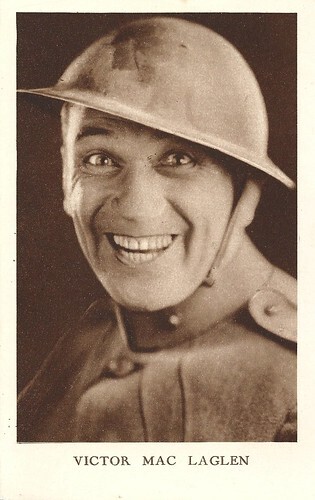
Belgian postcard by Weekblad 'Cinema', Antwerpen. Victor McLaglen in What Price Glory (Raoul Walsh, 1926).
Victor McLaglen (1886-1959) was a Scottish boxer and World War I veteran who became a successful film actor. He started in British silent films, and later became a popular character actor in Hollywood, with a particular knack for playing drunks.
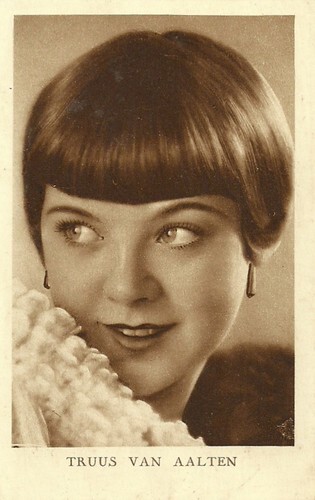
Belgian postcard by Uitgeverij Weekblad 'Cinéma', Antwerpen.
Dutch film star Truus van Aalten (1910-1999) made 29 films in the 1920s and 1930s, and only one of them in the Netherlands. The Germans lovingly called her 'die kleine holländische Käse' (the little Dutch cheese).
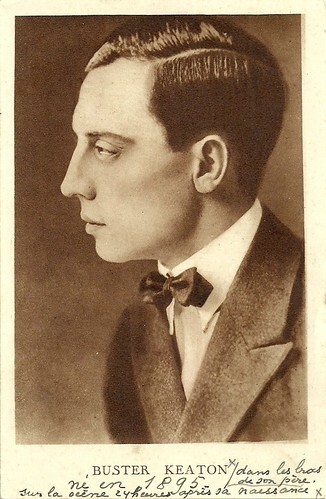
Belgian postcard by Ed. Weekblad Cinema, Antwerpen. French written caption: Buster Keaton, born in 1895, on the stage 24 hours after his birth, in the arms of his father.
Stone-faced Buster Keaton (1895-1966) was one of the three greatest comedians of Silent Hollywood.
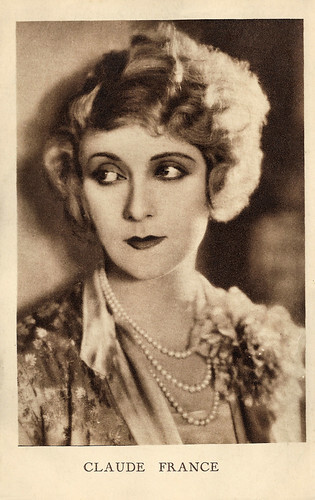
Belgian postcard by Weekblad Cinema, Antwerpen.
Claude France (1893-1928) was a French silent film actress of the 1920s. Two months before her greatest triumph opened in the cinemas, she committed suicide by opening the gas.
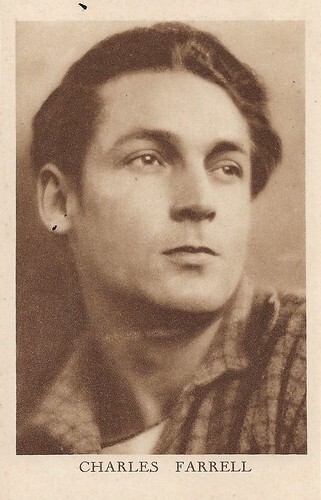
Belgian postcard by Weekblad 'Cinema', Antwerpen. Charles Farrell in 7th Heaven (Frank Borzage, 1927).
Good-looking American actor Charles Farrell (1900-1990) was a Hollywood matinée idol of the Jazz Age and Depression era. He seems now forgotten, but between 1927 and 1934, he was very popular thanks to his teaming with Janet Gaynor in 12 screen romances, including 7th Heaven (1927), Street Angel (1928), and Lucky Star (1929). He retired from films in the early 1940s, but TV audiences of the 1950s would see him as Gale Storm's widower dad in the popular television series My Little Margie (1952-1955).
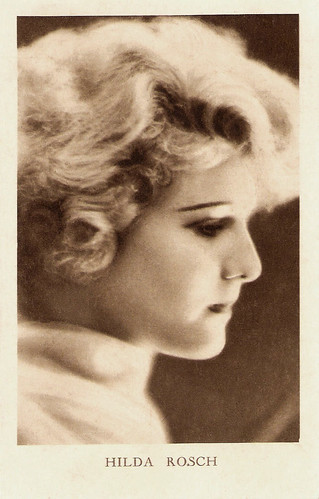
Belgian postcard by Weekblad 'Cinema', Antwerpen.
German actress Hilda Rosch only appeared in eight films between 1928 and 1931. Rosch co-starred in popular silent films with Harry Liedtke and Luciano Albertini, but she was soon forgotten.
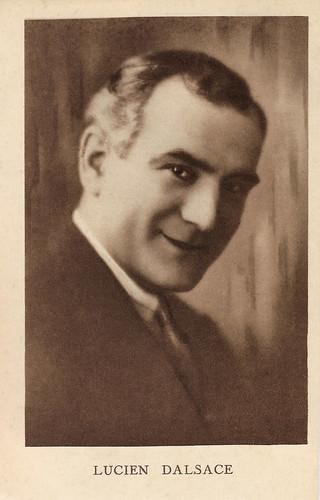
Belgian postcard by Weekblad 'Cinema', Antwerpen.
Lucien Dalsace (1893-1980) was a French stage and screen actor who peaked in French silent cinema of the 1920s. He went from success to success in films directed by Louis Feuillade, René Leprince, Gaston Ravel, René Hervil and Henri Desfontaines.
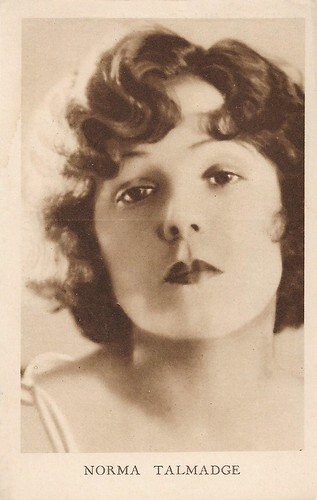
Belgian postcard by Weekblad 'Cinema' Antwerpen.
Norma Talmadge (1894-1957) was an American actress and film producer of the silent era. She made her first films in 1910 at Vitascope. A major box-office draw for over a decade, her career peaked in the early 1920s, when she ranked among the most popular idols on the American screen.
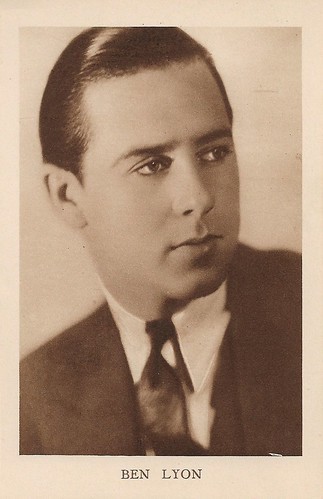
Belgian postcard by Weekblad 'Cinema', Antwerpen.
Ben Lyon (1901- 1979) was an American stage, film, radio and TV performer, as well as a studio manager. He is famous for his part as the war aviator in Hell's Angels (1930).
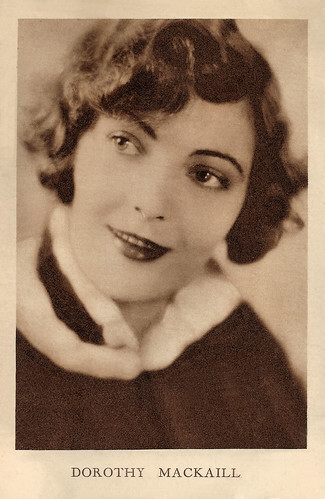
Belgian postcard by Weekblad 'Cinema', Antwerpen.
Dorothy Mackaill (1903–1990) was a British-American actress, most active during the silent-film era and into the pre-Code era of the early 1930s. During the 1930s, her popularity declined and she found herself in B-movies. From 1920 to 1937, she starred in more than 60 films.
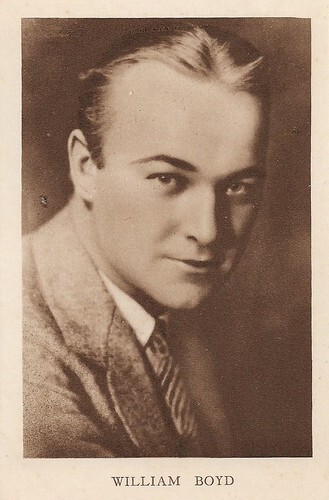
Belgian postcard by Weekblad 'Cinema', Antwerpen.
American film actor William Boyd (1895-1972) with his expressive blue eyes and prematurely silver-gray hair was a sought-after leading man of the silent movie era. He is now best known for his later parts in Westerns and is known primarily as the performer of the cowboy Hopalong Cassidy in the eponymous film and TV series.
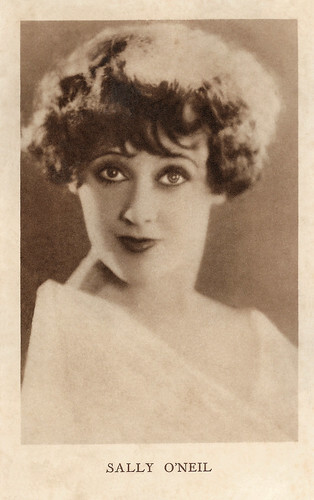
Belgian postcard by Weekblad 'Cinema', Antwerpen.
Cute and petite American actress Sally O'Neill (1908-1968) acted in almost 50 films between the mid-1920s and the mid-1930s. Her starring role in The Brat (1931), directed by John Ford, was a highlight of her career. She also starred in several Broadway productions.
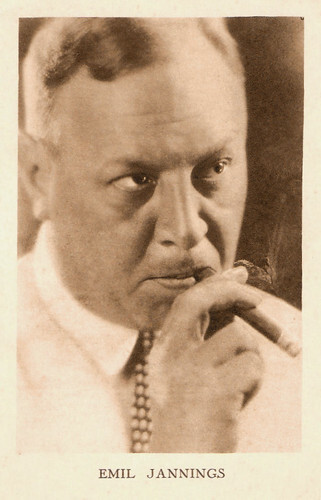
Belgian postcard by Weekblad 'Cinema', Antwerpen.
If Weimar cinema had one film star, then it was Emil Jannings (1884-1950) for sure. He was a great actor in the silent era and won the first Oscar for Best Actor. Too bad that during his later years, he worked as a board member for the Ufa propaganda machine during the Third Reich.
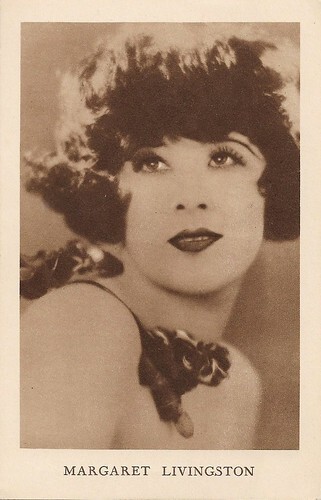
Belgian postcard published by Weekblad 'Cinema', Antwerpen.
Margaret Livingston (1895–1984) was an American film actress and businesswoman, most notable for her work during the silent film era. She remains best known today as 'the Woman from the City' in F.W. Murnau's film Sunrise: A Song of Two Humans (1927).
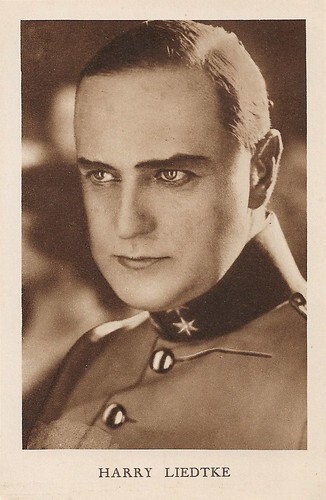
Belgian postcard by Weekblad 'Cinema', Antwerpen.
German actor Harry Liedtke (1882-1945) was the charming ladykiller of many early silent classics. Detective serials like Joe Deebs made him one of the first male stars of the German cinema.
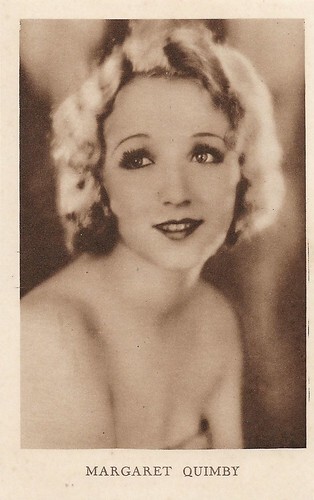
Belgian postcard by Weekblad 'Cinema', Antwerpen.
Margaret Quimby (1904–1965) was an American stage and film actress, who appeared in both lead and supporting roles during the silent and early sound era. She is best remembered for the (lost) serial Perils of the Wild (Francis Ford, 1925) with Joe Bonomo, and such films as The Western Whirlwind (1927) with Jack Hoxie and The Tired Business Man (1927) with Raymond Hitchcock.
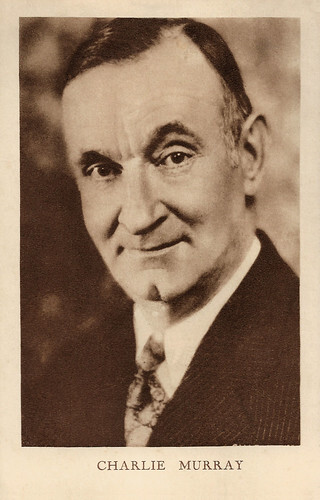
Belgian postcard by Weekblad 'Cinema', Antwerpen.
American comedian Charles Murray (1872-1941) appeared in 283 films between 1912 and 1938 and also directed 5 films. He worked together with George Sidney (1876-1945) on a series of comedies around the Jewish Nate Cohen and the Irish Catholic Patrick Kelly, two business partners who are constantly fighting.
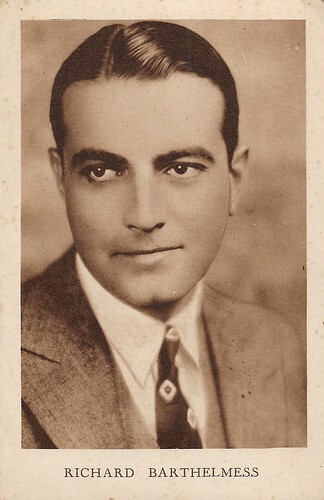
Belgian postcard by Weekblad 'Cinema', Antwerpen.
American actor Richard Barthelmess (1895-1963) is best known for his roles in the films of D.W. Griffith. In 1928, he was nominated for the Academy Award for Best Actor for two films: The Patent Leather Kid and The Noose. Barthelmess made 75 films in the twenty years between his first feature in 1916 and his semi-retirement from the screen in 1936. He appeared in only six more films between 1936 and 1942.
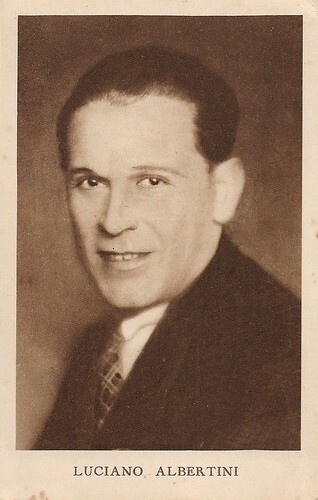
Belgian postcard by Weekblad 'Cinema", Antwerpen.
Italian actor-acrobat Luciano Albertini (1882-1941) had a prolific career in Italian and German silent cinema. He was one of the 'Forzuti', the popular Italian strongmen and acrobats of European film in the 1910s and 1920s.
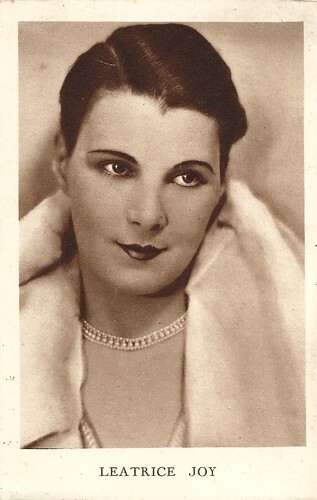
Belgian postcard by Weekblad 'Cinema', Antwerpen, 1920s.
Leatrice Joy (1893-1985) was an American actress of the silent screen. She was known for her roles as a determined and independent lady. From 1922 on, she became one of Cecil B. DeMille's favourites and protégées.
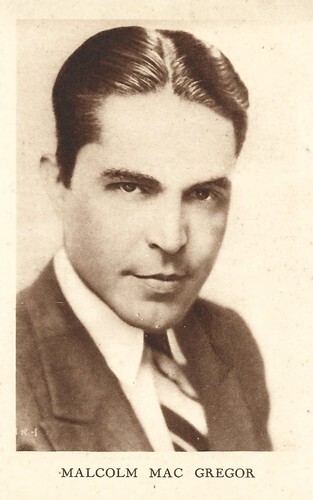
Belgian postcard by Weekblad 'Cinema', Antwerpen.
Handsome Malcolm McGregor (1892-1945) had a rich career in 1920s Hollywood as the male partner to such female stars as Pauline Frederick, Norma Shearer, Corinne Griffith and Colleen Moore. He debuted in The Prisoner of Zenda (Rex Ingram, 1922) as the dashing lieutenant who helps to defend his king. McGregor had his breakthrough as the male lead in Broken Chains (Allen Holubar, 1922) and All the Brothers Were Valiant (Irving Willat, 1923).
Source: Nathalie Hannes (De komst van de geluidsfilm in België: een nieuwe filmindustrie - Flemish).
The weekly issued a large series of sepia-tinted film star postcards for its readers. The postcards, published in the late 1920s, were identical to the star postcards by the Vilvorde-based chocolate factory Kivou. Yet, the Kivou cards have often (but not always) the word 'Cliché', followed by a company name on the front. Not to be confused with the quite similar cards of the Antwerp-based company N.V. Universum, which used a smaller typography. Here are our 21 favourite postcards by Weekblad Cinema.

Belgian postcard by Weekblad 'Cinema', Antwerpen. Victor McLaglen in What Price Glory (Raoul Walsh, 1926).
Victor McLaglen (1886-1959) was a Scottish boxer and World War I veteran who became a successful film actor. He started in British silent films, and later became a popular character actor in Hollywood, with a particular knack for playing drunks.

Belgian postcard by Uitgeverij Weekblad 'Cinéma', Antwerpen.
Dutch film star Truus van Aalten (1910-1999) made 29 films in the 1920s and 1930s, and only one of them in the Netherlands. The Germans lovingly called her 'die kleine holländische Käse' (the little Dutch cheese).

Belgian postcard by Ed. Weekblad Cinema, Antwerpen. French written caption: Buster Keaton, born in 1895, on the stage 24 hours after his birth, in the arms of his father.
Stone-faced Buster Keaton (1895-1966) was one of the three greatest comedians of Silent Hollywood.

Belgian postcard by Weekblad Cinema, Antwerpen.
Claude France (1893-1928) was a French silent film actress of the 1920s. Two months before her greatest triumph opened in the cinemas, she committed suicide by opening the gas.

Belgian postcard by Weekblad 'Cinema', Antwerpen. Charles Farrell in 7th Heaven (Frank Borzage, 1927).
Good-looking American actor Charles Farrell (1900-1990) was a Hollywood matinée idol of the Jazz Age and Depression era. He seems now forgotten, but between 1927 and 1934, he was very popular thanks to his teaming with Janet Gaynor in 12 screen romances, including 7th Heaven (1927), Street Angel (1928), and Lucky Star (1929). He retired from films in the early 1940s, but TV audiences of the 1950s would see him as Gale Storm's widower dad in the popular television series My Little Margie (1952-1955).

Belgian postcard by Weekblad 'Cinema', Antwerpen.
German actress Hilda Rosch only appeared in eight films between 1928 and 1931. Rosch co-starred in popular silent films with Harry Liedtke and Luciano Albertini, but she was soon forgotten.

Belgian postcard by Weekblad 'Cinema', Antwerpen.
Lucien Dalsace (1893-1980) was a French stage and screen actor who peaked in French silent cinema of the 1920s. He went from success to success in films directed by Louis Feuillade, René Leprince, Gaston Ravel, René Hervil and Henri Desfontaines.

Belgian postcard by Weekblad 'Cinema' Antwerpen.
Norma Talmadge (1894-1957) was an American actress and film producer of the silent era. She made her first films in 1910 at Vitascope. A major box-office draw for over a decade, her career peaked in the early 1920s, when she ranked among the most popular idols on the American screen.

Belgian postcard by Weekblad 'Cinema', Antwerpen.
Ben Lyon (1901- 1979) was an American stage, film, radio and TV performer, as well as a studio manager. He is famous for his part as the war aviator in Hell's Angels (1930).

Belgian postcard by Weekblad 'Cinema', Antwerpen.
Dorothy Mackaill (1903–1990) was a British-American actress, most active during the silent-film era and into the pre-Code era of the early 1930s. During the 1930s, her popularity declined and she found herself in B-movies. From 1920 to 1937, she starred in more than 60 films.

Belgian postcard by Weekblad 'Cinema', Antwerpen.
American film actor William Boyd (1895-1972) with his expressive blue eyes and prematurely silver-gray hair was a sought-after leading man of the silent movie era. He is now best known for his later parts in Westerns and is known primarily as the performer of the cowboy Hopalong Cassidy in the eponymous film and TV series.

Belgian postcard by Weekblad 'Cinema', Antwerpen.
Cute and petite American actress Sally O'Neill (1908-1968) acted in almost 50 films between the mid-1920s and the mid-1930s. Her starring role in The Brat (1931), directed by John Ford, was a highlight of her career. She also starred in several Broadway productions.

Belgian postcard by Weekblad 'Cinema', Antwerpen.
If Weimar cinema had one film star, then it was Emil Jannings (1884-1950) for sure. He was a great actor in the silent era and won the first Oscar for Best Actor. Too bad that during his later years, he worked as a board member for the Ufa propaganda machine during the Third Reich.

Belgian postcard published by Weekblad 'Cinema', Antwerpen.
Margaret Livingston (1895–1984) was an American film actress and businesswoman, most notable for her work during the silent film era. She remains best known today as 'the Woman from the City' in F.W. Murnau's film Sunrise: A Song of Two Humans (1927).

Belgian postcard by Weekblad 'Cinema', Antwerpen.
German actor Harry Liedtke (1882-1945) was the charming ladykiller of many early silent classics. Detective serials like Joe Deebs made him one of the first male stars of the German cinema.

Belgian postcard by Weekblad 'Cinema', Antwerpen.
Margaret Quimby (1904–1965) was an American stage and film actress, who appeared in both lead and supporting roles during the silent and early sound era. She is best remembered for the (lost) serial Perils of the Wild (Francis Ford, 1925) with Joe Bonomo, and such films as The Western Whirlwind (1927) with Jack Hoxie and The Tired Business Man (1927) with Raymond Hitchcock.

Belgian postcard by Weekblad 'Cinema', Antwerpen.
American comedian Charles Murray (1872-1941) appeared in 283 films between 1912 and 1938 and also directed 5 films. He worked together with George Sidney (1876-1945) on a series of comedies around the Jewish Nate Cohen and the Irish Catholic Patrick Kelly, two business partners who are constantly fighting.

Belgian postcard by Weekblad 'Cinema', Antwerpen.
American actor Richard Barthelmess (1895-1963) is best known for his roles in the films of D.W. Griffith. In 1928, he was nominated for the Academy Award for Best Actor for two films: The Patent Leather Kid and The Noose. Barthelmess made 75 films in the twenty years between his first feature in 1916 and his semi-retirement from the screen in 1936. He appeared in only six more films between 1936 and 1942.

Belgian postcard by Weekblad 'Cinema", Antwerpen.
Italian actor-acrobat Luciano Albertini (1882-1941) had a prolific career in Italian and German silent cinema. He was one of the 'Forzuti', the popular Italian strongmen and acrobats of European film in the 1910s and 1920s.

Belgian postcard by Weekblad 'Cinema', Antwerpen, 1920s.
Leatrice Joy (1893-1985) was an American actress of the silent screen. She was known for her roles as a determined and independent lady. From 1922 on, she became one of Cecil B. DeMille's favourites and protégées.

Belgian postcard by Weekblad 'Cinema', Antwerpen.
Handsome Malcolm McGregor (1892-1945) had a rich career in 1920s Hollywood as the male partner to such female stars as Pauline Frederick, Norma Shearer, Corinne Griffith and Colleen Moore. He debuted in The Prisoner of Zenda (Rex Ingram, 1922) as the dashing lieutenant who helps to defend his king. McGregor had his breakthrough as the male lead in Broken Chains (Allen Holubar, 1922) and All the Brothers Were Valiant (Irving Willat, 1923).
Source: Nathalie Hannes (De komst van de geluidsfilm in België: een nieuwe filmindustrie - Flemish).
Published on July 02, 2024 22:00
July 1, 2024
Ruth Roman
In a career of five decades, American actress Ruth Roman (1922–1999) transitioned flawlessly from ingénue to leading lady to character actress. She is memorable as the murderous villain in the classic Film Noir The Window (1949) and as Farley Granger's elegant girlfriend in Alfred Hitchcock's thriller Strangers on a Train (1951).
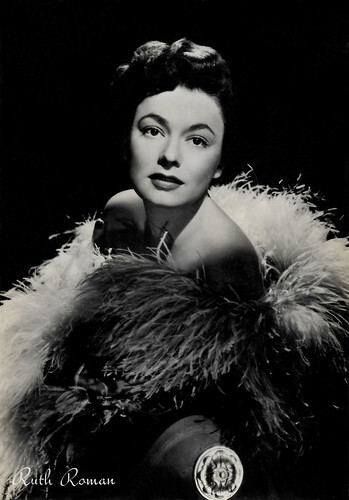
Italian postcard by Rotalfoto, Milano, no. 71.
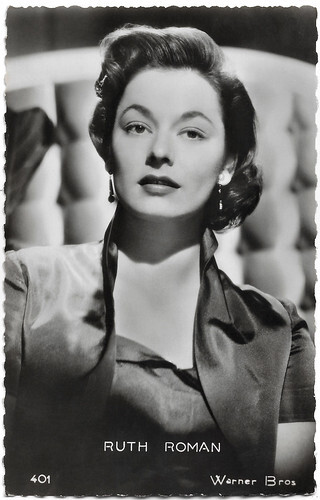
French postcard by Editions P.I., Paris, offered by Hardy, France, no. 401. Photo: Warner.
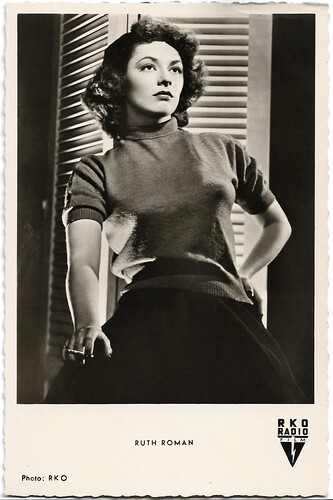
West German postcard by Kunst und Bild, Berlin, no. A 429. Photo: R.K.O. Ruth Roman in Lightning Strikes Twice (King Vidor, 1951).
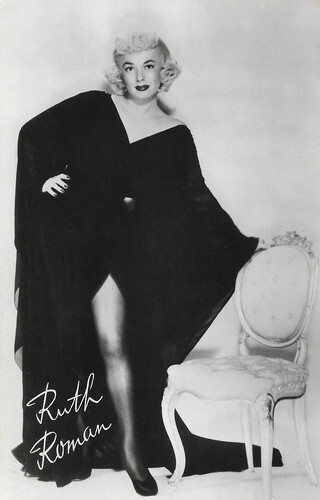
Dutch postcard by DRC, no. F 152. Photo: Warner Bros. Ruth Roman in Tomorrow is Another Day (Felix E. Feist, 1951).
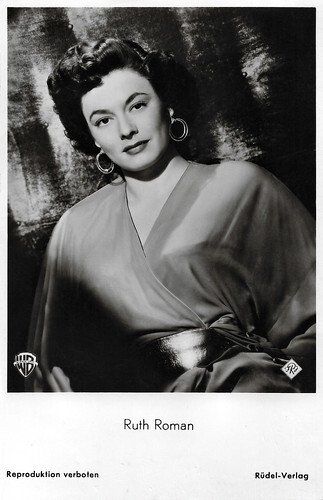
West German postcard by Rüdel Verlag, no. 345. Photo: Warner Bros.
Strangers on a Train
Ruth Roman was born Norma Roman in Lynn, Massachusetts in 1922. Her Lithuanian Jewish parents were Mary Pauline (née Gold) and Abraham 'Anthony' Roman. Her mother was a dancer, and her father a barker in a carnival sideshow that they owned at Revere Beach, Massachusetts. She had two older sisters, Ann and Eve. She was renamed 'Ruth' when a fortune-teller told her mother that 'Norma' was an unlucky name. Her father died when Ruth was eight. Her mother sold the sideshow and supported the family by working as a waitress and cleaning woman.
As a girl, Ruth pursued her dream to become an actress by enrolling in the prestigious Bishop Lee Dramatic School in Boston. Roman moved to New York City, where she hoped to find success on Broadway. Instead, she worked as a cigarette girl, a hat check girl at a night club and a model for a crime magazine to make a living and save money. After playing stage roles on the East Coast, Roman moved to Hollywood to pursue a career in films.
She appeared in several uncredited bit parts before she was cast as the leading lady in the Western Harmony Trail (Robert Emmett Tansey, 1944) opposite Ken Maynard. She was cast in the title role in the thirteen-episode serial Jungle Queen (Lewis D. Collins, Ray Taylor, 1945). Roman's career began to improve in the late 1940s when she was cast in a featured role in Good Sam (Leo McCarey, 1948) starring Gary Cooper .
She first starred in the title role of Belle Starr's Daughter (Lesley Selander, 1948). She achieved her first notable success with a role as a murderess in the Film Noir The Window (Ted Tetzlaff, 1949) both a critical success and a box office hit. She played another important role as the dependable wife of the fighter ( Kirk Douglas ) in the boxing drama Champion (Mark Robson, 1949). A year later she was nominated for the Golden Globe Award for New Star of the Year – Actress for her performance.
Ruth Roman was under contract to Warner Bros., where she starred in a variety of films. Look Magazine billed her as the 'Big Time Movie Personality of 1950', and by the following year, she was receiving some 500 fan letters per week. In Three Secrets (Robert Wise, 1950), she played a distraught mother waiting to learn whether or not her child survived an aeroplane crash. In one of her most memorable roles, Roman co-starred with Farley Granger and Robert Walker in the Alfred Hitchcock thriller Strangers on a Train (1951).
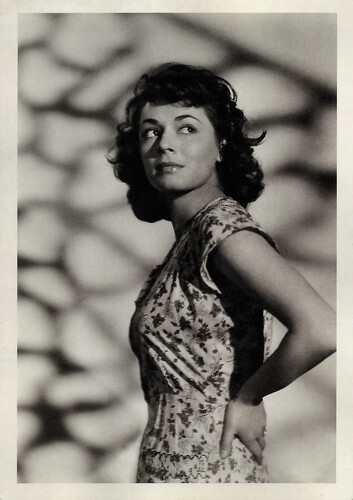
Spanish postcard in the Colleccíon 'Mitos Cinematográficos', CACITEL S.L., no. 84.
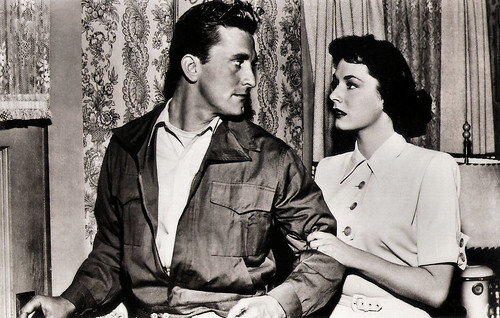
Spanish postcard by Soberanas, no. 280. Photo: Kirk Douglas and Ruth Roman in Champion (Mark Robson, 1949).
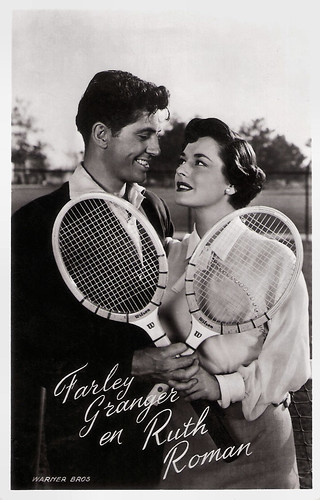
Dutch postcard by Takken, no. 566. Photo: Warner Bros. Farley Granger and Ruth Roman in Strangers on a Train (Alfred Hitchcock, 1951).
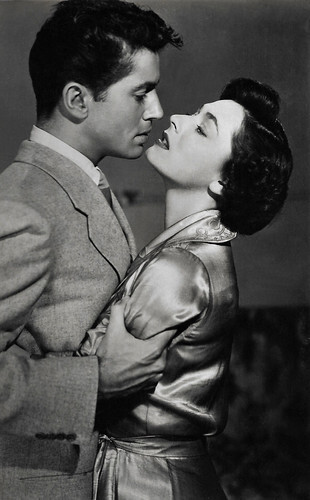
Spanish postcard. Farley Granger and Ruth Roman in Strangers on a Train (Alfred Hitchcock, 1951).
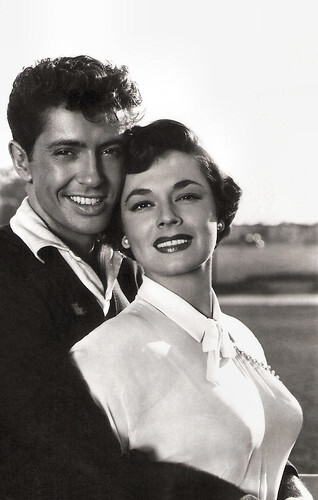
Spanish postcard. Farley Granger and Ruth Roman in Strangers on a Train (Alfred Hitchcock, 1951).
Rescued from the SS Andrea Doria
In the mid-1950s, Ruth Roman left Warner Bros. At Universal, she was the love interest to James Stewart in the Western The Far Country (Anthony Mann, 1955). She continued to star in films but also began playing guest roles in television series. She also worked abroad and made films in England, Italy, and Spain.
In 1956, Ruth Roman and her son Dickie boarded the Italian passenger liner SS Andrea Doria for a trip from France to the US. On a night, the Andrea Doria collided with the Swedish passenger liner MS Stockholm. When the collision happened Roman immediately took off her high heels in the lounge and scrambled back to her cabin barefoot to retrieve her sleeping son. Several hours later the passengers were being evacuated from the sinking liner. Dickie was lowered first into a waiting lifeboat, and before Roman could follow the lifeboat departed. Ruth stepped into the next boat and was eventually rescued along with 750 other survivors from the Andrea Doria by the French passenger liner SS Ile de France. Dickie was rescued by the Stockholm and was reunited with his mother in New York.
She played the woman between British Army officers Richard Burton and Curd Jürgens in the World War II drama Amère victoire/Bitter Victory (Nicholas Ray, 1957). In 1959, she won the Sarah Siddons Award for her work in Chicago theatre.
Although she never achieved the level of success as a leading lady that many predicted, Roman worked regularly in film well into the 1960s. Ruth had made the transition to middle-aged character parts and began to appear mostly on television in shows like The Outer Limits (1963), Mannix (1967), Gunsmoke (1955), and (in a recurring role) in The Long, Hot Summer (1965). She also toured with theatrical productions of 'Plaza Suite', 'Who's Afraid of Virginia Woolf', and 'Two for the Seesaw'.
Her final theatrical film was the thriller Impulse (William Grefé, 1974), starring William Shatner. Her last screen appearance was in the TV series Murder She Wrote (1989) with Angela Lansbury . Ruth Roman died at 76 in Laguna Beach, California, in 1999. Roman was married four times. She had one son, Richard Roman Hall (1952) with husband Mortimer Hall.
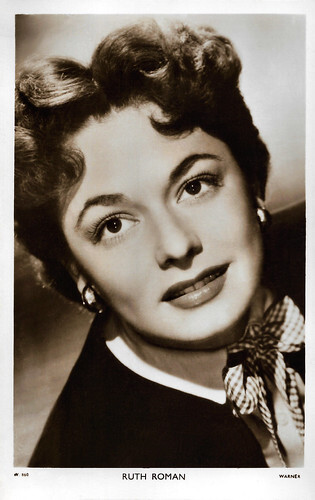
British postcard in the Picturegoer Series, London, no. W 860. Photo: Warner.
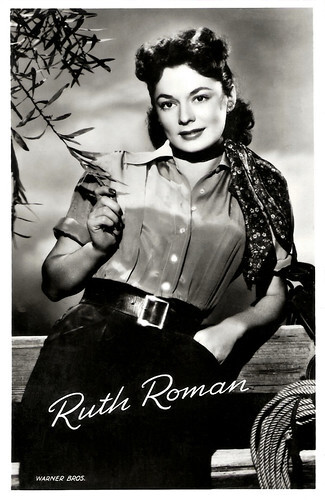
Dutch postcard by Fotoarchief Film en Toneel, no. AX 187. Photo: Warner Bros.
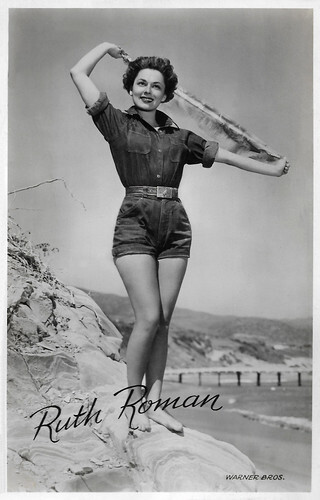
Dutch postcard by Fotoarchief Film en Toneel, no. 3376. Photo: Warner.
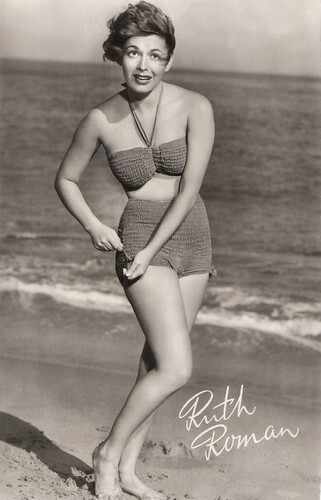
Dutch postcard by DRC, no. F 182. Photo: Warner Bros.
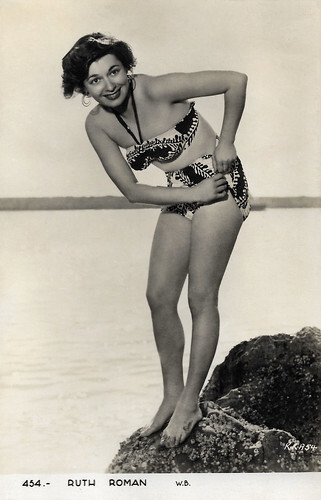
Spanish postcard, no. 454. Photo: Warner Bros.
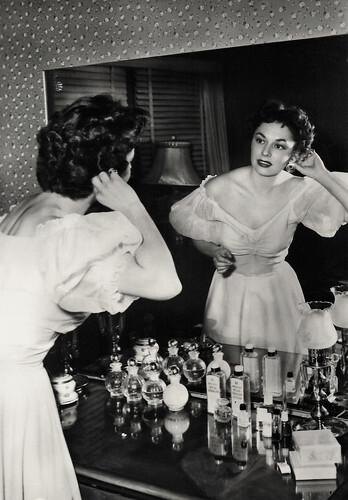
Italian postcard by Rotalfoto, Milano.
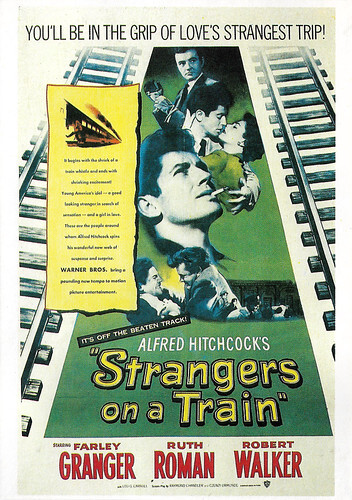
French postcard in the Série Hitchcock by Editions ZREIK, Paris, no. H. Image: Warner Bros. American poster for Strangers on a Train (Alfred Hitchcock, 1951) with Farley Granger , Ruth Roman and Robert Walker .
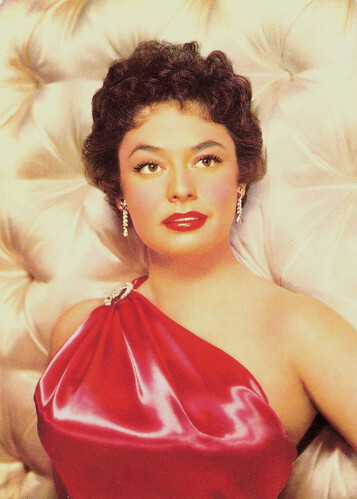
Italian postcard by Rotalcolor, no. N. 35.
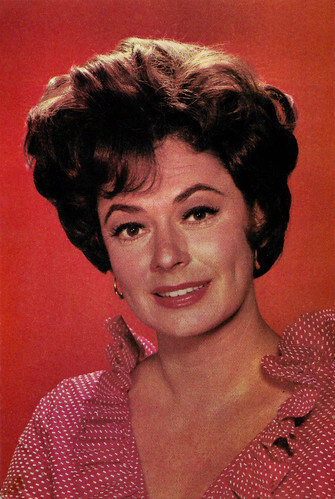
Yugoslavian postcard by NIP 'Borba', Beograd. Ruth Roman in The Long Hot Summer (1965-1966).
Sources: Wikipedia (Dutch, German and English) and .

Italian postcard by Rotalfoto, Milano, no. 71.

French postcard by Editions P.I., Paris, offered by Hardy, France, no. 401. Photo: Warner.

West German postcard by Kunst und Bild, Berlin, no. A 429. Photo: R.K.O. Ruth Roman in Lightning Strikes Twice (King Vidor, 1951).

Dutch postcard by DRC, no. F 152. Photo: Warner Bros. Ruth Roman in Tomorrow is Another Day (Felix E. Feist, 1951).

West German postcard by Rüdel Verlag, no. 345. Photo: Warner Bros.
Strangers on a Train
Ruth Roman was born Norma Roman in Lynn, Massachusetts in 1922. Her Lithuanian Jewish parents were Mary Pauline (née Gold) and Abraham 'Anthony' Roman. Her mother was a dancer, and her father a barker in a carnival sideshow that they owned at Revere Beach, Massachusetts. She had two older sisters, Ann and Eve. She was renamed 'Ruth' when a fortune-teller told her mother that 'Norma' was an unlucky name. Her father died when Ruth was eight. Her mother sold the sideshow and supported the family by working as a waitress and cleaning woman.
As a girl, Ruth pursued her dream to become an actress by enrolling in the prestigious Bishop Lee Dramatic School in Boston. Roman moved to New York City, where she hoped to find success on Broadway. Instead, she worked as a cigarette girl, a hat check girl at a night club and a model for a crime magazine to make a living and save money. After playing stage roles on the East Coast, Roman moved to Hollywood to pursue a career in films.
She appeared in several uncredited bit parts before she was cast as the leading lady in the Western Harmony Trail (Robert Emmett Tansey, 1944) opposite Ken Maynard. She was cast in the title role in the thirteen-episode serial Jungle Queen (Lewis D. Collins, Ray Taylor, 1945). Roman's career began to improve in the late 1940s when she was cast in a featured role in Good Sam (Leo McCarey, 1948) starring Gary Cooper .
She first starred in the title role of Belle Starr's Daughter (Lesley Selander, 1948). She achieved her first notable success with a role as a murderess in the Film Noir The Window (Ted Tetzlaff, 1949) both a critical success and a box office hit. She played another important role as the dependable wife of the fighter ( Kirk Douglas ) in the boxing drama Champion (Mark Robson, 1949). A year later she was nominated for the Golden Globe Award for New Star of the Year – Actress for her performance.
Ruth Roman was under contract to Warner Bros., where she starred in a variety of films. Look Magazine billed her as the 'Big Time Movie Personality of 1950', and by the following year, she was receiving some 500 fan letters per week. In Three Secrets (Robert Wise, 1950), she played a distraught mother waiting to learn whether or not her child survived an aeroplane crash. In one of her most memorable roles, Roman co-starred with Farley Granger and Robert Walker in the Alfred Hitchcock thriller Strangers on a Train (1951).

Spanish postcard in the Colleccíon 'Mitos Cinematográficos', CACITEL S.L., no. 84.

Spanish postcard by Soberanas, no. 280. Photo: Kirk Douglas and Ruth Roman in Champion (Mark Robson, 1949).

Dutch postcard by Takken, no. 566. Photo: Warner Bros. Farley Granger and Ruth Roman in Strangers on a Train (Alfred Hitchcock, 1951).

Spanish postcard. Farley Granger and Ruth Roman in Strangers on a Train (Alfred Hitchcock, 1951).

Spanish postcard. Farley Granger and Ruth Roman in Strangers on a Train (Alfred Hitchcock, 1951).
Rescued from the SS Andrea Doria
In the mid-1950s, Ruth Roman left Warner Bros. At Universal, she was the love interest to James Stewart in the Western The Far Country (Anthony Mann, 1955). She continued to star in films but also began playing guest roles in television series. She also worked abroad and made films in England, Italy, and Spain.
In 1956, Ruth Roman and her son Dickie boarded the Italian passenger liner SS Andrea Doria for a trip from France to the US. On a night, the Andrea Doria collided with the Swedish passenger liner MS Stockholm. When the collision happened Roman immediately took off her high heels in the lounge and scrambled back to her cabin barefoot to retrieve her sleeping son. Several hours later the passengers were being evacuated from the sinking liner. Dickie was lowered first into a waiting lifeboat, and before Roman could follow the lifeboat departed. Ruth stepped into the next boat and was eventually rescued along with 750 other survivors from the Andrea Doria by the French passenger liner SS Ile de France. Dickie was rescued by the Stockholm and was reunited with his mother in New York.
She played the woman between British Army officers Richard Burton and Curd Jürgens in the World War II drama Amère victoire/Bitter Victory (Nicholas Ray, 1957). In 1959, she won the Sarah Siddons Award for her work in Chicago theatre.
Although she never achieved the level of success as a leading lady that many predicted, Roman worked regularly in film well into the 1960s. Ruth had made the transition to middle-aged character parts and began to appear mostly on television in shows like The Outer Limits (1963), Mannix (1967), Gunsmoke (1955), and (in a recurring role) in The Long, Hot Summer (1965). She also toured with theatrical productions of 'Plaza Suite', 'Who's Afraid of Virginia Woolf', and 'Two for the Seesaw'.
Her final theatrical film was the thriller Impulse (William Grefé, 1974), starring William Shatner. Her last screen appearance was in the TV series Murder She Wrote (1989) with Angela Lansbury . Ruth Roman died at 76 in Laguna Beach, California, in 1999. Roman was married four times. She had one son, Richard Roman Hall (1952) with husband Mortimer Hall.

British postcard in the Picturegoer Series, London, no. W 860. Photo: Warner.

Dutch postcard by Fotoarchief Film en Toneel, no. AX 187. Photo: Warner Bros.

Dutch postcard by Fotoarchief Film en Toneel, no. 3376. Photo: Warner.

Dutch postcard by DRC, no. F 182. Photo: Warner Bros.

Spanish postcard, no. 454. Photo: Warner Bros.

Italian postcard by Rotalfoto, Milano.

French postcard in the Série Hitchcock by Editions ZREIK, Paris, no. H. Image: Warner Bros. American poster for Strangers on a Train (Alfred Hitchcock, 1951) with Farley Granger , Ruth Roman and Robert Walker .

Italian postcard by Rotalcolor, no. N. 35.

Yugoslavian postcard by NIP 'Borba', Beograd. Ruth Roman in The Long Hot Summer (1965-1966).
Sources: Wikipedia (Dutch, German and English) and .
Published on July 01, 2024 22:00
June 30, 2024
Donald Sutherland (1935-2024)
Canadian actor Donald Sutherland (1935) passed away in Miami, Florida, on 20 June 2024. He rose to fame after starring in films including M*A*S*H (1970), Klute (1971), Don't Look Now (1973), Fellini's Casanova (1976), and 1900 (1976). During his long film career, he won two Golden Globe Awards, for the television films Citizen X (1995) and Path to War (2002), and an Emmy Award for the former. In 2017, he received an Honorary Oscar for his contributions to cinema. Donald Sutherland was 88.
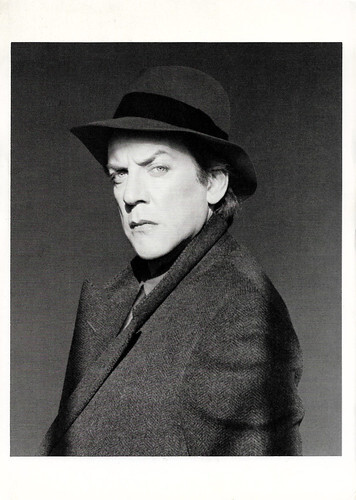
American postcard by Fotofolio, N.Y., N.Y., no. RM28. Photo: Robert Mapplethorpe. Caption: Donald Sutherland, 1983.
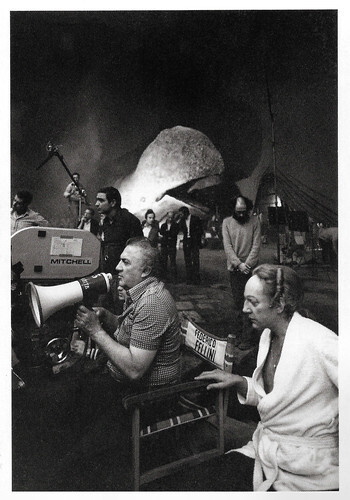
Swiss postcard by News Productions, Baulmes, no. 55592. Photo: Michelangelo Durazzo / ANA, Paris. Caption: Federico Fellini during the shooting of the film Casanova.
Casanova
Donald McNichol Sutherland was born in Saint John, New Brunswick in 1935. His parents were Dorothy Isobel (née McNichol) and Frederick McLea Sutherland. His father worked in sales and ran the local gas, electricity, and bus company. Donald obtained his first part-time job, at the age of 14, as a news correspondent for local radio station CKBW. He graduated from Bridgewater High School and then studied at Victoria University, where he met his first wife Lois Hardwick and graduated with a double major in engineering and drama. He changed his mind about becoming an engineer, and left Canada for Britain in 1957, studying at the London Academy of Music and Dramatic Art.
After departing the London Academy of Music and Dramatic Art (LAMDA), Sutherland spent a year and a half at the Perth Repertory Theatre in Scotland. In the early to mid-1960s, he began to gain small roles in British films and TV. He was featured alongside Christopher Lee in Horror films such as Il castello dei morti vivi/Castle of the Living Dead (Warren Kiefer, Luciano Ricci, 1964) and Dr. Terror's House of Horrors (Freddie Francis, 1965). He also had a supporting role in the Hammer Films production Fanatic/Die! Die! My Darling! (Silvio Narizzano, 1965), with Tallulah Bankhead and Stefanie Powers. The same year, he appeared in the Cold War classic The Bedford Incident (James B. Harris, 1965). In 1966, Sutherland appeared on the BBC TV play Lee Oswald-Assassin, playing a friend of Lee Harvey Oswald. Then followed parts in such popular TV series as Gideon's Way (1966), The Saint (1966-1967) and The Avengers (1967).
Donald Sutherland landed the role of a lame-brained convict in the exciting action film The Dirty Dozen (Robert Aldrich, 1967), starring Lee Marvin and Charles Bronson . It was the 5th highest-grossing film of 1967, MGM's highest-grossing movie of the year and Sutherland's breakthrough. In 1968, he left London for Hollywood and appeared in two war films, playing the lead role of 'Hawkeye' Pierce in M*A*S*H (Robert Altman, 1970) and, as hippie tank commander 'Oddball' in Kelly's Heroes (Brian G. Hutton, 1970). Sutherland starred with Gene Wilder in the comedy Start the Revolution Without Me (Bud Yorkin, 1970).
Sutherland found himself as a leading man throughout the 1970s. During the filming of the Oscar-winning detective thriller Klute (Alan J. Pakula, 1971), he had an intimate relationship with co-star Jane Fonda . They went on to co-produce and star together in the anti-Vietnam War documentary F.T.A. (1972), consisting of a series of sketches performed outside army bases in the Pacific Rim and interviews with American troops who were then on active service. A follow-up to their teaming up in Klute, Sutherland, and Fonda performed together in Steelyard Blues (David S. Ward, 1973). He then played in the Venice-based psychological horror film Don't Look Now (Nicholas Roeg, 1973), co-starring Julie Christie . He was nominated for his role for the BAFTA Award for Best Actor.
Then followed the war film The Eagle Has Landed (John Sturges, 1976), Il Casanova di Federico Fellini/Casanova (Federico Fellini, 1976), and the thriller Eye of the Needle (Richard Marquand, 1981), which was filmed on location on the Isle of Mull, West Scotland. His role as the Corpse of Lt. Robert Schmied in the German film Der Richter und sein Henker/End of the Game (Maximilian Schell, 1976). Then he was the ever-optimistic health inspector in the Science Fiction/Horror film Invasion of the Body Snatchers (Philip Kaufman, 1978) alongside Brooke Adams and Jeff Goldblum. Sutherland also had a role as pot-smoking Professor Dave Jennings in National Lampoon's Animal House/Animal House (John Landis, 1978), making himself known to younger fans as a result of the movie's popularity. He won acclaim for his performance in the Italian epic 1900/Novecento (Bernardo Bertolucci, 1976) and as the conflicted father in the Academy Award-winning family drama Ordinary People (Robert Redford, 1980), alongside Mary Tyler Moore and Timothy Hutton.
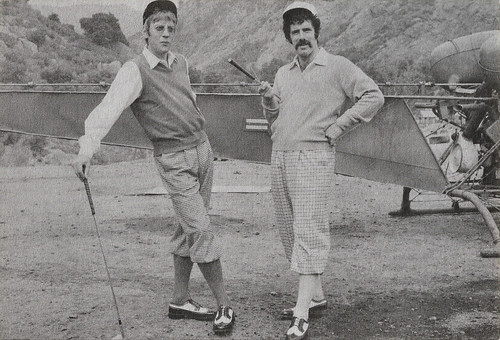
Promotion card by the American Film Institute, no. 3333. Donald Sutherland and Elliott Gould in M*A*S*H (Robert Altman, 1970).
The head of a government agency hunting for aliens
Some of Donald Sutherland's better-known roles in the 1980s and 1990s were in the South African apartheid drama A Dry White Season (Euzhan Palcy, 1989), alongside Marlon Brando and Susan Sarandon; as a sadistic warden in Lock Up (John Flynn, 1989) with Sylvester Stallone ; as an incarcerated pyromaniac in the firefighter thriller Backdraft (Ron Howard, 1990) alongside Kurt Russell and Robert De Niro , as the humanitarian doctor-activist Norman Bethune in Bethune: the Making of a Hero (Bethune: The Making of a Hero, 1992), and as a snobbish New York City art dealer in Six Degrees of Separation (Fred Schepisi, 1993), with Stockard Channing and Will Smith . In JFK (Oliver Stone, 1991), he played a mysterious Washington intelligence officer, reputed to have been L. Fletcher Prouty, who spoke of links to the military-industrial complex in the assassination of U.S. President John F. Kennedy.
The following year, he played the role of Merrick in the film Buffy the Vampire Slayer (Fran Rubel Kuzui, 1992), with Kristy Swanson. In 1994, he played the head of a government agency hunting for aliens who take over people's bodies similar to the premise of Invasion of the Body Snatchers in the film The Puppet Masters(Stuart Ortme, 1994), based on Robert A. Heinlein's 1951 book. In 1994, Sutherland played a software company's scheming CEO in Barry Levinson's drama Disclosure opposite Michael Douglas and Demi Moore . He was cast as Maj. Gen. Donald McClintock in Wolfgang Petersen's Outbreak (1995). For only the second time, he was cast with his son Kiefer Sutherland in Joel Schumacher's A Time to Kill (1996). He won two Golden Globe Awards, for the television films Citizen X (Chris Gerolmo, 1995) and Path to War (John Frankenheimer, 2002), and an Emmy Award for the former.
Donald Sutherland played an astronaut in Space Cowboys (Clint Eastwood, 2000), with co-stars Clint Eastwood , Tommy Lee Jones , and James Garner. Sutherland was a model for Chris Claremont and John Byrne to create Donald Pierce, the character in the Marvel Comics, whose last name comes from Sutherland's character in M*A*S*H (Robert Altman, 1970), Hawkeye Pierce. In more recent years, Sutherland was known for his role as Reverend Monroe in the Civil War drama Cold Mountain (Anthony Minghella, 2003), in the remake of The Italian Job (F. Gary Gray, 2003), in the TV series Commander in Chief (2005–2006), and as Mr. Bennet in Pride & Prejudice (Joe Wright, 2005), starring alongside Keira Knightley. Sutherland starred as Tripp Darling in the prime-time drama series Dirty Sexy Money (2007-2009), and his distinctive voice has also been used in many radio and television commercials.
In 2010, he starred alongside an ensemble cast in a TV adaptation of Ken Follett's novel The Pillars of the Earth (Sergio Mimica-Gezzan, 2010). Beginning in 2012, Sutherland portrayed President Snow, the main antagonist of The Hunger Games film franchise, in The Hunger Games (Francis Lawrence, 2012), The Hunger Games: Catching Fire (Francis Lawrence, 2013), The Hunger Games: Mockingjay – Part 1 (Francis Lawrence, 2014), and Part 2 (Francis Lawrence, 2015). His role was well-received by fans and critics. In the television program Crossing Lines (2013-2015), Sutherland played Michel Dorn, the Chief Prosecutor for the International Criminal Court. He was one of only two actors to appear in all episodes across three seasons. He also played a supporting role in the Science Fiction film Ad Astra (James Gray, 2019) starring Brad Pitt . His final film was the Horror film Mr. Harrigan's Phone (John Lee Hancock, 2022), based on Stephen King's short story of the same name.
Donald Sutherland was married three times. His first marriage, to Lois Hardwick, lasted from 1959 to 1966. His second marriage, which lasted from 1966 to 1970, was to Shirley Douglas. They have two children, twins Kiefer and Rachel. Sutherland met his current wife, French Canadian actress Francine Racette, on the set of the Canadian pioneer drama Alien Thunder. They married in 1972 and had three sons: Rossif Sutherland, Angus Redford Sutherland, and Roeg Sutherland. His four sons have all been named after directors whom Sutherland has worked with: Kiefer is named after American-born director and writer Warren Kiefer, who, under the assumed name of Lorenzo Sabatini, directed Sutherland in his first feature film, the Italian low-budget Horror film Il castello dei morti vivi/Castle of the Living Dead. Roeg is named after director Nicolas Roeg; Rossif is named after French director Frédéric Rossif, and Angus Redford has his middle name after Robert Redford . Donald Sutherland was a Companion of the Order of Canada (CC) since 2019. Donald Sutherland died on 20 June 2024 in Miami at the age of 88 following a long illness.
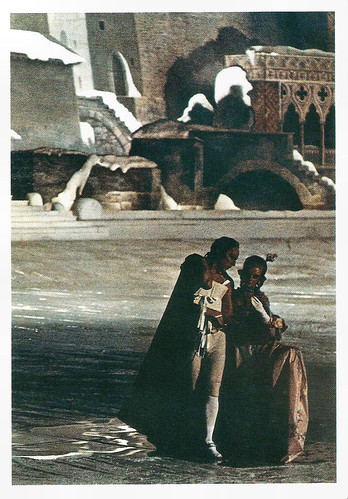
French postcard in the Collection Cinéma Couleur by Editions La Malibran, Nancy, no. MC 40. Donald Sutherland in Il Casanova di Federico Fellini (Federico Fellini, 1976).
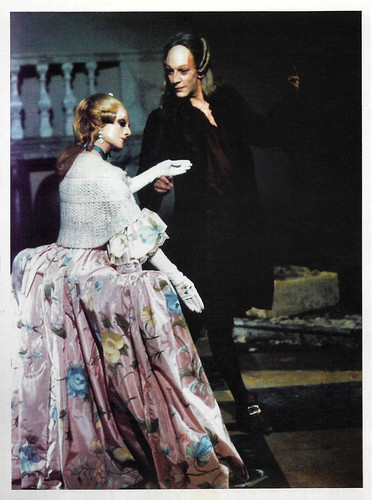
Italian postcard in the Federico Fellini series by Gruppo Prospettive. Photo: F. Pinna / RAM Studio. Donald Sutherland in Il Casanova di Federico Fellini (Federico Fellini, 1976).
Sources: Wikipedia (Dutch and English) and .

American postcard by Fotofolio, N.Y., N.Y., no. RM28. Photo: Robert Mapplethorpe. Caption: Donald Sutherland, 1983.

Swiss postcard by News Productions, Baulmes, no. 55592. Photo: Michelangelo Durazzo / ANA, Paris. Caption: Federico Fellini during the shooting of the film Casanova.
Casanova
Donald McNichol Sutherland was born in Saint John, New Brunswick in 1935. His parents were Dorothy Isobel (née McNichol) and Frederick McLea Sutherland. His father worked in sales and ran the local gas, electricity, and bus company. Donald obtained his first part-time job, at the age of 14, as a news correspondent for local radio station CKBW. He graduated from Bridgewater High School and then studied at Victoria University, where he met his first wife Lois Hardwick and graduated with a double major in engineering and drama. He changed his mind about becoming an engineer, and left Canada for Britain in 1957, studying at the London Academy of Music and Dramatic Art.
After departing the London Academy of Music and Dramatic Art (LAMDA), Sutherland spent a year and a half at the Perth Repertory Theatre in Scotland. In the early to mid-1960s, he began to gain small roles in British films and TV. He was featured alongside Christopher Lee in Horror films such as Il castello dei morti vivi/Castle of the Living Dead (Warren Kiefer, Luciano Ricci, 1964) and Dr. Terror's House of Horrors (Freddie Francis, 1965). He also had a supporting role in the Hammer Films production Fanatic/Die! Die! My Darling! (Silvio Narizzano, 1965), with Tallulah Bankhead and Stefanie Powers. The same year, he appeared in the Cold War classic The Bedford Incident (James B. Harris, 1965). In 1966, Sutherland appeared on the BBC TV play Lee Oswald-Assassin, playing a friend of Lee Harvey Oswald. Then followed parts in such popular TV series as Gideon's Way (1966), The Saint (1966-1967) and The Avengers (1967).
Donald Sutherland landed the role of a lame-brained convict in the exciting action film The Dirty Dozen (Robert Aldrich, 1967), starring Lee Marvin and Charles Bronson . It was the 5th highest-grossing film of 1967, MGM's highest-grossing movie of the year and Sutherland's breakthrough. In 1968, he left London for Hollywood and appeared in two war films, playing the lead role of 'Hawkeye' Pierce in M*A*S*H (Robert Altman, 1970) and, as hippie tank commander 'Oddball' in Kelly's Heroes (Brian G. Hutton, 1970). Sutherland starred with Gene Wilder in the comedy Start the Revolution Without Me (Bud Yorkin, 1970).
Sutherland found himself as a leading man throughout the 1970s. During the filming of the Oscar-winning detective thriller Klute (Alan J. Pakula, 1971), he had an intimate relationship with co-star Jane Fonda . They went on to co-produce and star together in the anti-Vietnam War documentary F.T.A. (1972), consisting of a series of sketches performed outside army bases in the Pacific Rim and interviews with American troops who were then on active service. A follow-up to their teaming up in Klute, Sutherland, and Fonda performed together in Steelyard Blues (David S. Ward, 1973). He then played in the Venice-based psychological horror film Don't Look Now (Nicholas Roeg, 1973), co-starring Julie Christie . He was nominated for his role for the BAFTA Award for Best Actor.
Then followed the war film The Eagle Has Landed (John Sturges, 1976), Il Casanova di Federico Fellini/Casanova (Federico Fellini, 1976), and the thriller Eye of the Needle (Richard Marquand, 1981), which was filmed on location on the Isle of Mull, West Scotland. His role as the Corpse of Lt. Robert Schmied in the German film Der Richter und sein Henker/End of the Game (Maximilian Schell, 1976). Then he was the ever-optimistic health inspector in the Science Fiction/Horror film Invasion of the Body Snatchers (Philip Kaufman, 1978) alongside Brooke Adams and Jeff Goldblum. Sutherland also had a role as pot-smoking Professor Dave Jennings in National Lampoon's Animal House/Animal House (John Landis, 1978), making himself known to younger fans as a result of the movie's popularity. He won acclaim for his performance in the Italian epic 1900/Novecento (Bernardo Bertolucci, 1976) and as the conflicted father in the Academy Award-winning family drama Ordinary People (Robert Redford, 1980), alongside Mary Tyler Moore and Timothy Hutton.

Promotion card by the American Film Institute, no. 3333. Donald Sutherland and Elliott Gould in M*A*S*H (Robert Altman, 1970).
The head of a government agency hunting for aliens
Some of Donald Sutherland's better-known roles in the 1980s and 1990s were in the South African apartheid drama A Dry White Season (Euzhan Palcy, 1989), alongside Marlon Brando and Susan Sarandon; as a sadistic warden in Lock Up (John Flynn, 1989) with Sylvester Stallone ; as an incarcerated pyromaniac in the firefighter thriller Backdraft (Ron Howard, 1990) alongside Kurt Russell and Robert De Niro , as the humanitarian doctor-activist Norman Bethune in Bethune: the Making of a Hero (Bethune: The Making of a Hero, 1992), and as a snobbish New York City art dealer in Six Degrees of Separation (Fred Schepisi, 1993), with Stockard Channing and Will Smith . In JFK (Oliver Stone, 1991), he played a mysterious Washington intelligence officer, reputed to have been L. Fletcher Prouty, who spoke of links to the military-industrial complex in the assassination of U.S. President John F. Kennedy.
The following year, he played the role of Merrick in the film Buffy the Vampire Slayer (Fran Rubel Kuzui, 1992), with Kristy Swanson. In 1994, he played the head of a government agency hunting for aliens who take over people's bodies similar to the premise of Invasion of the Body Snatchers in the film The Puppet Masters(Stuart Ortme, 1994), based on Robert A. Heinlein's 1951 book. In 1994, Sutherland played a software company's scheming CEO in Barry Levinson's drama Disclosure opposite Michael Douglas and Demi Moore . He was cast as Maj. Gen. Donald McClintock in Wolfgang Petersen's Outbreak (1995). For only the second time, he was cast with his son Kiefer Sutherland in Joel Schumacher's A Time to Kill (1996). He won two Golden Globe Awards, for the television films Citizen X (Chris Gerolmo, 1995) and Path to War (John Frankenheimer, 2002), and an Emmy Award for the former.
Donald Sutherland played an astronaut in Space Cowboys (Clint Eastwood, 2000), with co-stars Clint Eastwood , Tommy Lee Jones , and James Garner. Sutherland was a model for Chris Claremont and John Byrne to create Donald Pierce, the character in the Marvel Comics, whose last name comes from Sutherland's character in M*A*S*H (Robert Altman, 1970), Hawkeye Pierce. In more recent years, Sutherland was known for his role as Reverend Monroe in the Civil War drama Cold Mountain (Anthony Minghella, 2003), in the remake of The Italian Job (F. Gary Gray, 2003), in the TV series Commander in Chief (2005–2006), and as Mr. Bennet in Pride & Prejudice (Joe Wright, 2005), starring alongside Keira Knightley. Sutherland starred as Tripp Darling in the prime-time drama series Dirty Sexy Money (2007-2009), and his distinctive voice has also been used in many radio and television commercials.
In 2010, he starred alongside an ensemble cast in a TV adaptation of Ken Follett's novel The Pillars of the Earth (Sergio Mimica-Gezzan, 2010). Beginning in 2012, Sutherland portrayed President Snow, the main antagonist of The Hunger Games film franchise, in The Hunger Games (Francis Lawrence, 2012), The Hunger Games: Catching Fire (Francis Lawrence, 2013), The Hunger Games: Mockingjay – Part 1 (Francis Lawrence, 2014), and Part 2 (Francis Lawrence, 2015). His role was well-received by fans and critics. In the television program Crossing Lines (2013-2015), Sutherland played Michel Dorn, the Chief Prosecutor for the International Criminal Court. He was one of only two actors to appear in all episodes across three seasons. He also played a supporting role in the Science Fiction film Ad Astra (James Gray, 2019) starring Brad Pitt . His final film was the Horror film Mr. Harrigan's Phone (John Lee Hancock, 2022), based on Stephen King's short story of the same name.
Donald Sutherland was married three times. His first marriage, to Lois Hardwick, lasted from 1959 to 1966. His second marriage, which lasted from 1966 to 1970, was to Shirley Douglas. They have two children, twins Kiefer and Rachel. Sutherland met his current wife, French Canadian actress Francine Racette, on the set of the Canadian pioneer drama Alien Thunder. They married in 1972 and had three sons: Rossif Sutherland, Angus Redford Sutherland, and Roeg Sutherland. His four sons have all been named after directors whom Sutherland has worked with: Kiefer is named after American-born director and writer Warren Kiefer, who, under the assumed name of Lorenzo Sabatini, directed Sutherland in his first feature film, the Italian low-budget Horror film Il castello dei morti vivi/Castle of the Living Dead. Roeg is named after director Nicolas Roeg; Rossif is named after French director Frédéric Rossif, and Angus Redford has his middle name after Robert Redford . Donald Sutherland was a Companion of the Order of Canada (CC) since 2019. Donald Sutherland died on 20 June 2024 in Miami at the age of 88 following a long illness.

French postcard in the Collection Cinéma Couleur by Editions La Malibran, Nancy, no. MC 40. Donald Sutherland in Il Casanova di Federico Fellini (Federico Fellini, 1976).

Italian postcard in the Federico Fellini series by Gruppo Prospettive. Photo: F. Pinna / RAM Studio. Donald Sutherland in Il Casanova di Federico Fellini (Federico Fellini, 1976).
Sources: Wikipedia (Dutch and English) and .
Published on June 30, 2024 22:00
June 29, 2024
La Collectionneuse: Anne Baxter
Anne Baxter worked for famous directors such as Jean Renoir, Orson Welles, Billy Wilder, Otto Preminger, Joseph Mankiewicz, Alfred Hitchcock, Fritz Lang and Cecil B. DeMille. She won the Best Supporting Actress Oscar for The Razor’s Edge (1946) and was nominated for the Best Actress Oscar for her most famous role in All About Eve (1950). She once declared: "I’m an actress, not a personality. It’s more successful to be a personality. But can you use it in every role? I don’t spill over into everything I do. I do what I do from inside someone else’s skin."
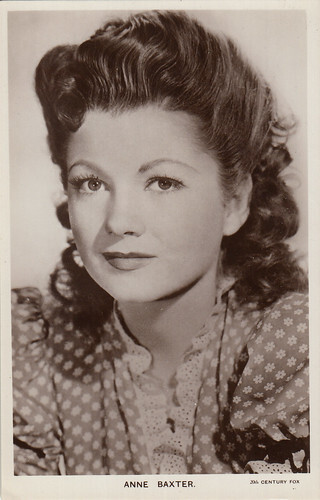
British postcard by Picturegoer, no. W177. Photo: 20th Century Fox.
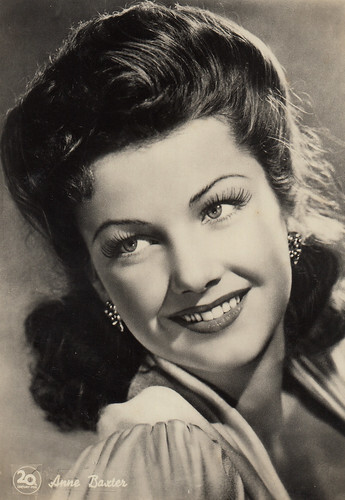
Italian postcard by Rotalfoto, Milano, no. 75. Photo: 20th Century Fox.
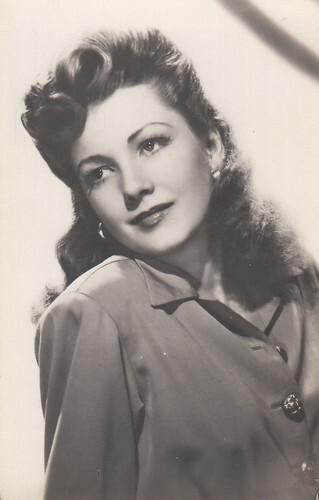
Spanish postcard by Kores Carboplan.
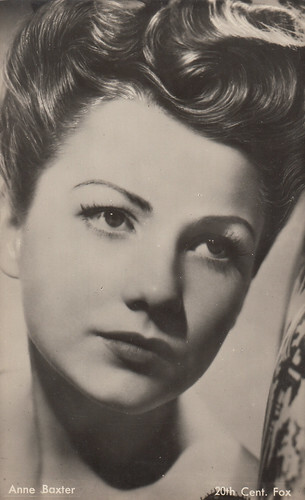
Dutch postcard by MPEA, no. 41. Photo: 20th Century Fox.
A candidate for Rebecca
Anne Baxter was born on the 7th of May 1923 in Michigan City, Indiana, U.S.A. Her maternal grandfather was the famous architect Frank Lloyd Wright.
From an early age, she decided to be an actress and made her Broadway debut in 'Seen But Not Heard', which ran from September to November 1936.
At the end of the 1930s, David O’Selznick started a search to find the perfect actress to play the leading role in the movie Rebecca.
After some time, the selection was narrowed to five contenders: Vivien Leigh , Loretta Young , Margaret Sullavan , Anne Baxter and Joan Fontaine , who were subjected to further extensive screen tests.
Anne Baxter, who was only 16 years old at the time, was very good and made a strong impression but she looked too young for the part and Selznick finally choose Joan Fontaine at the end of August 1939.
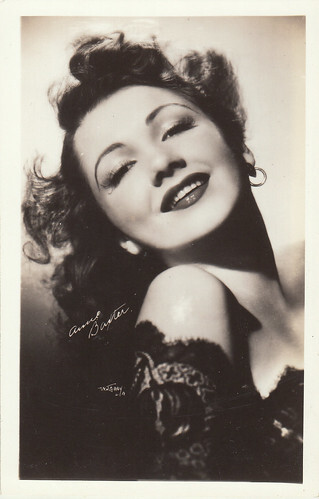
American postcard by W.J. Gray, L.A.
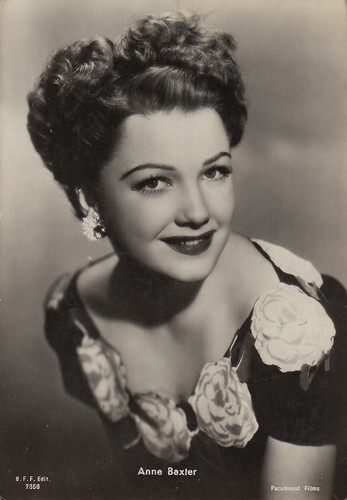
Italian postcard by Ballerini & Fratini, Firenze, no. 2356. Photo: Paramount Films.
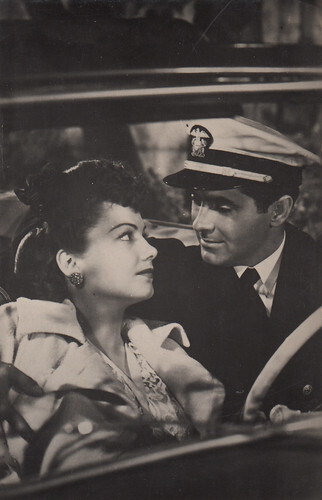
Spanish postcard. Anne Baxter and Tyrone Power in Crash Drive (Archie Mayo, 1943).
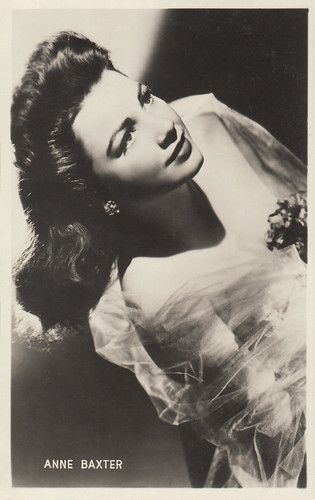
Vintage postcard, no. 112.
20th Century Fox star
Anne finally signed with 20th Century Fox and made her screen debut in 20 Mule Team (1940). She got her first star billing in Jean Renoir ’s Swamp Water (1941), as a rural girl.
After Orson Welles ’ The Magnificent Ambersons, she was featured in seven films dealing with World War II: The Pied Piper (1942), Crash Drive (1943), Billy Wilder ’s Five Graves to Cairo (1943), The North Star (1943), The Sullivans (1944), The Eve of St. Mark (1944) and Sunday Dinner for a Soldier (1944).
She also played an evil home wrecker in Guest in the House (1944), which was a departure from her usual roles at the time. In Otto Preminger’s A Royal Scandal, Anne’s role as a lady in waiting was overshadowed by Tallulah Bankhead ’s domineering performance as Catherine the Great. She then co-starred with Fred MacMurray in the box office hit Smoky (1946) and with Paul Muni in Angel on My Shoulder (1946).
In 1946, she got the part of the ill-fated Sophie in Edmund Goulding’s The Razor’s Edge, which earned her a Best Supporting Actress Oscar. Films such as Blaze of Noon (1947), The Luck of the Irish (1948), Yellow Sky (1949) and You’re My Everything (1949) followed.
Then came the highlight of her professional career when she was cast as scheming Eve Harrington in Joseph Mankiewicz’s All About Eve (1950). She was nominated for a Best Actress Oscar, as was her co-star Bette Davis , but lost out to Judy Holliday for Born Yesterday (1950). Her 20th Century Fox contract ended with Follow the Sun (1951), The Outcasts of Poker Flat (1952), O. Henry’s Full House (1952) and My Wife’s Best Friend (1952).
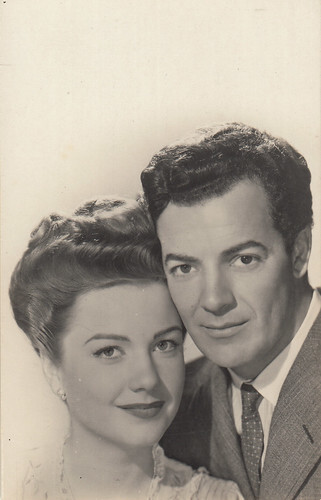
Spanish postcard. Anne Baxter and Cornel Wilde in The Walls of Jericho (John M. Stahl, 1948).
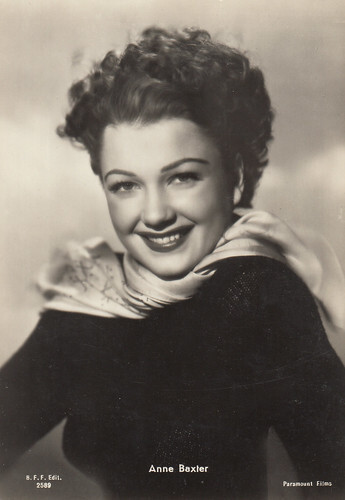
Italian postcard by Ballerini & Fratini, Firenze, no. 2589. Photo: Paramount Films.
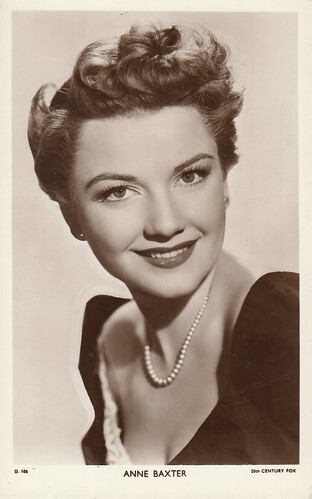
British postcard by Picturegoer, no. D106. Photo: 20th Century Fox. Anne Baxter in All About Eve (Joseph L. Mankiewicz, 1950).
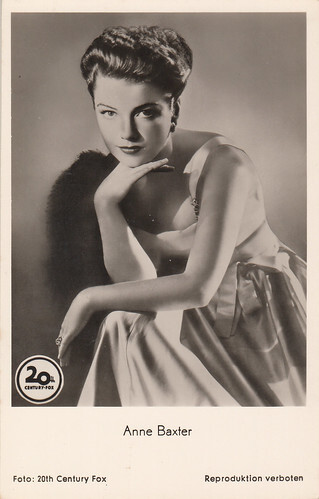
German postcard by J.F. Rüdel, Hamburg-Bergedorf. Photo: 20th Century Fox.
A freelance actress
After her departure from Fox, she signed a two-picture contract with Warner Brothers. She was first directed by Alfred Hitchcock in I Confess (1953). The director’s first choice had been Swedish actress Anita Björk but she had had a daughter in 1951 without being married and Warner refused to give her the role by fear of scandal.
She then appeared in Fritz Lang ’s The Blue Gardenia (1953), as a switchboard operator suspected of murder.
As a freelance actress, Anne Baxter worked steadily in movies until the beginning of the 1960s and played for example a destitute German girl turned circus artist in Carnival Story (1954), a saloon lady falling in love with Rock Hudson in One Desire (1955) or a Mexican cafe owner in Walk on the Wild Side (1962).
She also starred in two Britsh crime dramas, Chase a Crooked Shadow (1958) and Mix Me a Person (1962). In Australia, she appeared in Summer of the Seventeenth Doll (1959).
Her most notable role from this period was probably as strong-willed Egyptian Princess Nefretiri in Cecil B De Mille ’s star-studded The Ten Commandments (1956). After 1962, she only appeared in six movies, including the European Western Las 7 magnificas (1966) and a star vehicle for comedian Sid Caesar, The Busy Body (1967).
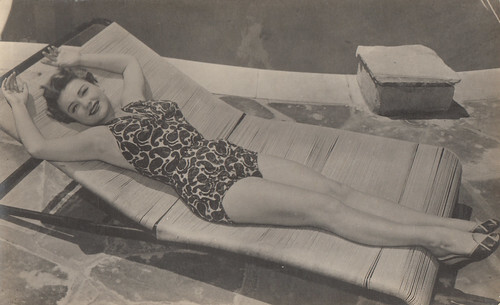
Spanish postcard, no. 3065.
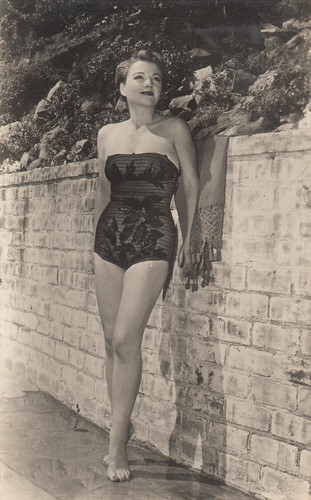
Spanish postcard, no. 3126.
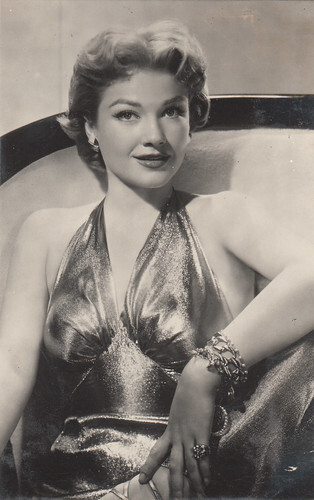
Spanish postcard.
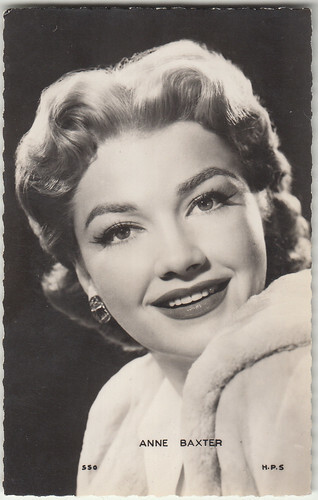
French postcard by Editions P.I., Paris, no. 550. Photo: H.P.S.
Television work
Anne Baxter first worked for television in 1958 and it soon took prominence on her movie career. She appeared in popular series such as Dr. Kildare, The Virginian, The Big Valley, Ironside, Columbo, Mannix and The Love Boat.
She also played two villains in Batman: Zelda the Great in 1966 and Olga, Queen of Cossacks in 1967.
She was nominated for an Emmy Award for the episode The Bobby Currier Story (1969), from the series The Name of the Game.
After she had played hotel owner Laura Trent in the pilot episode of the series Hotel, Bette Davis had to withdraw for health reasons.
So, Anne was brought in as Victoria Cabot, Laura Trent’s sister-in-law, and starred in Hotel from 1983 onwards. The last episode she appeared in was aired on the 2nd of April 1986.
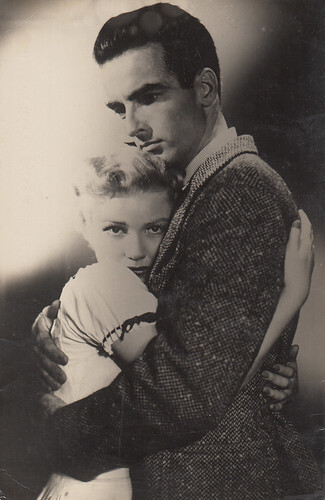
Spanish postcard. Anne Baxter and Montgomery Clift in I Confess (Alfred Hitchcock, 1953).
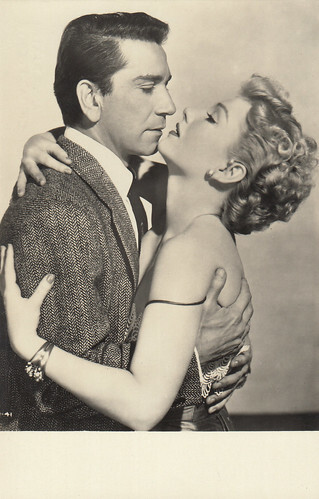
Spanish postcard. Anne Baxter and Richard Conte in The Blue Gardenia (Fritz Lang, 1953).
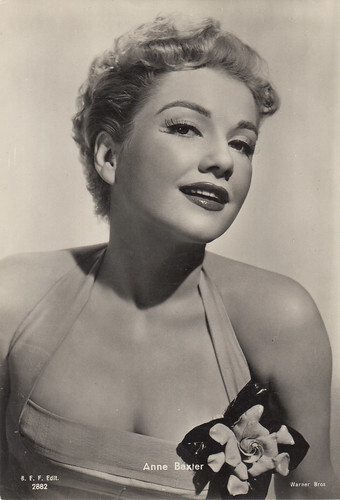
Italian postcard by Ballerini & Fratini, Firenze, no. 2882. Photo: Warner Bros.
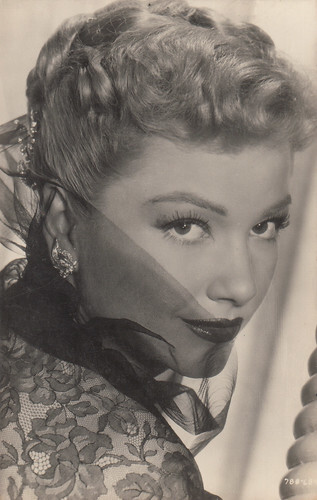
Spanish postcard, no. 2569.
Back on stage
Anne Baxter made her return to Broadway in 'The Square Root of Wonderful', which closed after forty-five performances in 1957.
The following year, Baxter starred in 'The Joshua Tree' in London.
In July 1971, she replaced Lauren Bacall in the successful Broadway musical 'Applause'and performed in it until April 1972.
'Applause' was adapted from All About Eve but, this time, Anne played ageing star Margo Channing instead of cunning Eve Harrington.
Her last Broadway appearance was in 'Noël Coward in Two Keys' from February to June 1974.
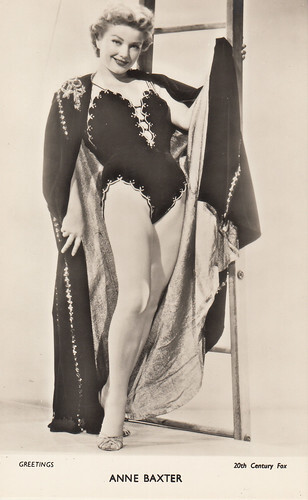
British postcard in the Greetings series. Anne Baxter in Carnival Story (Kurt Neumann, 1954). The reference to 20th Century Fox on the card must be a mistake as it was an R.K.O. movie.
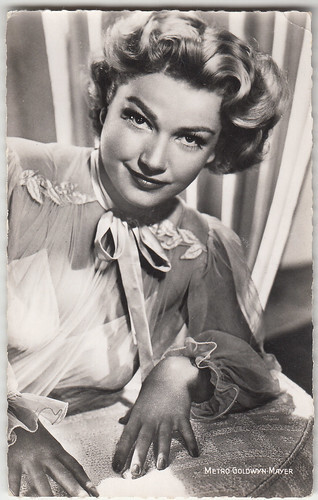
French postcard by Editions du Globe, no. 477. Photo: Metro Goldwyn Mayer.
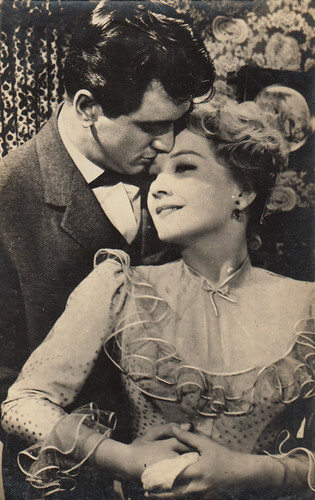
Spanish postcard by Marte. Anne Baxter and Rock Hudson in One Desire (Jerry Hopper, 1955).
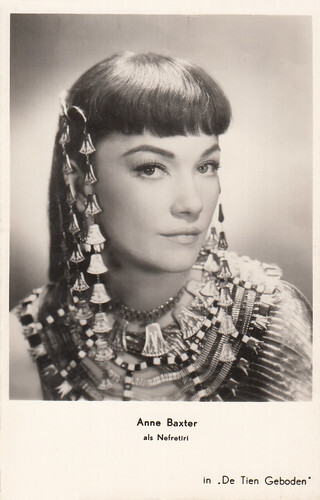
Dutch postcard by Gebr. Spanjersberg N.V., Rotterdam, no. 5194. Anne Baxter in The Ten Commandments (Cecil B. DeMille, 1956).
Her private life
Anne Baxter married actor John Hodiak in 1946. They had a daughter, Katrina, in 1951, and divorced in 1954.
She remarried in 1960 with the owner of a cattle station in Australia, Randolph Galt. They had two daughters, Melissa in 1962 and Maginel in 1963. They divorced in 1970.
Her third husband was stockbroker David Klee but he passed away in October 1977, several months after their marriage.
Anne Baxter died of a stroke on the 12th of December 1985 in New York.
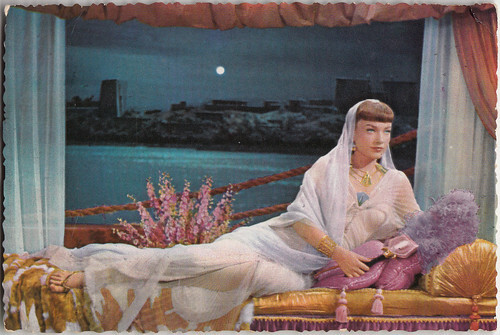
Spanish promotional postcard. Anne Baxter in The Ten Commandments (Cecil B. DeMille, 1956).
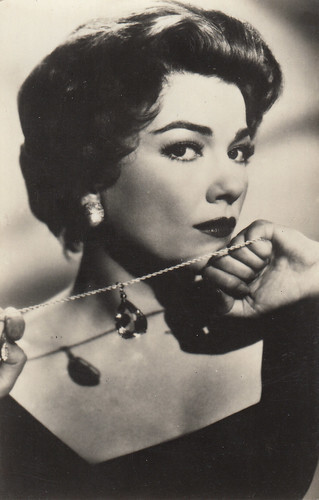
Spanish postcard, no. 3095.
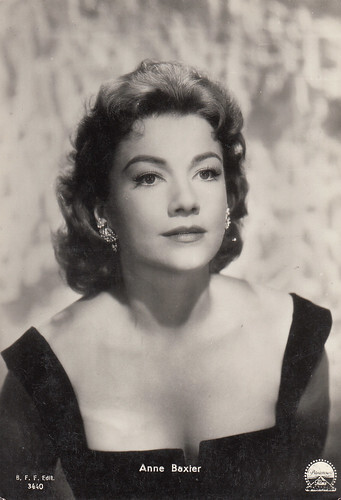
Italian postcard by Ballerini & Fratini, Firenze, no. 3440. Photo: Paramount Films.
Text and postcards: Marlene Pilaete.

British postcard by Picturegoer, no. W177. Photo: 20th Century Fox.

Italian postcard by Rotalfoto, Milano, no. 75. Photo: 20th Century Fox.

Spanish postcard by Kores Carboplan.

Dutch postcard by MPEA, no. 41. Photo: 20th Century Fox.
A candidate for Rebecca
Anne Baxter was born on the 7th of May 1923 in Michigan City, Indiana, U.S.A. Her maternal grandfather was the famous architect Frank Lloyd Wright.
From an early age, she decided to be an actress and made her Broadway debut in 'Seen But Not Heard', which ran from September to November 1936.
At the end of the 1930s, David O’Selznick started a search to find the perfect actress to play the leading role in the movie Rebecca.
After some time, the selection was narrowed to five contenders: Vivien Leigh , Loretta Young , Margaret Sullavan , Anne Baxter and Joan Fontaine , who were subjected to further extensive screen tests.
Anne Baxter, who was only 16 years old at the time, was very good and made a strong impression but she looked too young for the part and Selznick finally choose Joan Fontaine at the end of August 1939.

American postcard by W.J. Gray, L.A.

Italian postcard by Ballerini & Fratini, Firenze, no. 2356. Photo: Paramount Films.

Spanish postcard. Anne Baxter and Tyrone Power in Crash Drive (Archie Mayo, 1943).

Vintage postcard, no. 112.
20th Century Fox star
Anne finally signed with 20th Century Fox and made her screen debut in 20 Mule Team (1940). She got her first star billing in Jean Renoir ’s Swamp Water (1941), as a rural girl.
After Orson Welles ’ The Magnificent Ambersons, she was featured in seven films dealing with World War II: The Pied Piper (1942), Crash Drive (1943), Billy Wilder ’s Five Graves to Cairo (1943), The North Star (1943), The Sullivans (1944), The Eve of St. Mark (1944) and Sunday Dinner for a Soldier (1944).
She also played an evil home wrecker in Guest in the House (1944), which was a departure from her usual roles at the time. In Otto Preminger’s A Royal Scandal, Anne’s role as a lady in waiting was overshadowed by Tallulah Bankhead ’s domineering performance as Catherine the Great. She then co-starred with Fred MacMurray in the box office hit Smoky (1946) and with Paul Muni in Angel on My Shoulder (1946).
In 1946, she got the part of the ill-fated Sophie in Edmund Goulding’s The Razor’s Edge, which earned her a Best Supporting Actress Oscar. Films such as Blaze of Noon (1947), The Luck of the Irish (1948), Yellow Sky (1949) and You’re My Everything (1949) followed.
Then came the highlight of her professional career when she was cast as scheming Eve Harrington in Joseph Mankiewicz’s All About Eve (1950). She was nominated for a Best Actress Oscar, as was her co-star Bette Davis , but lost out to Judy Holliday for Born Yesterday (1950). Her 20th Century Fox contract ended with Follow the Sun (1951), The Outcasts of Poker Flat (1952), O. Henry’s Full House (1952) and My Wife’s Best Friend (1952).

Spanish postcard. Anne Baxter and Cornel Wilde in The Walls of Jericho (John M. Stahl, 1948).

Italian postcard by Ballerini & Fratini, Firenze, no. 2589. Photo: Paramount Films.

British postcard by Picturegoer, no. D106. Photo: 20th Century Fox. Anne Baxter in All About Eve (Joseph L. Mankiewicz, 1950).

German postcard by J.F. Rüdel, Hamburg-Bergedorf. Photo: 20th Century Fox.
A freelance actress
After her departure from Fox, she signed a two-picture contract with Warner Brothers. She was first directed by Alfred Hitchcock in I Confess (1953). The director’s first choice had been Swedish actress Anita Björk but she had had a daughter in 1951 without being married and Warner refused to give her the role by fear of scandal.
She then appeared in Fritz Lang ’s The Blue Gardenia (1953), as a switchboard operator suspected of murder.
As a freelance actress, Anne Baxter worked steadily in movies until the beginning of the 1960s and played for example a destitute German girl turned circus artist in Carnival Story (1954), a saloon lady falling in love with Rock Hudson in One Desire (1955) or a Mexican cafe owner in Walk on the Wild Side (1962).
She also starred in two Britsh crime dramas, Chase a Crooked Shadow (1958) and Mix Me a Person (1962). In Australia, she appeared in Summer of the Seventeenth Doll (1959).
Her most notable role from this period was probably as strong-willed Egyptian Princess Nefretiri in Cecil B De Mille ’s star-studded The Ten Commandments (1956). After 1962, she only appeared in six movies, including the European Western Las 7 magnificas (1966) and a star vehicle for comedian Sid Caesar, The Busy Body (1967).

Spanish postcard, no. 3065.

Spanish postcard, no. 3126.

Spanish postcard.

French postcard by Editions P.I., Paris, no. 550. Photo: H.P.S.
Television work
Anne Baxter first worked for television in 1958 and it soon took prominence on her movie career. She appeared in popular series such as Dr. Kildare, The Virginian, The Big Valley, Ironside, Columbo, Mannix and The Love Boat.
She also played two villains in Batman: Zelda the Great in 1966 and Olga, Queen of Cossacks in 1967.
She was nominated for an Emmy Award for the episode The Bobby Currier Story (1969), from the series The Name of the Game.
After she had played hotel owner Laura Trent in the pilot episode of the series Hotel, Bette Davis had to withdraw for health reasons.
So, Anne was brought in as Victoria Cabot, Laura Trent’s sister-in-law, and starred in Hotel from 1983 onwards. The last episode she appeared in was aired on the 2nd of April 1986.

Spanish postcard. Anne Baxter and Montgomery Clift in I Confess (Alfred Hitchcock, 1953).

Spanish postcard. Anne Baxter and Richard Conte in The Blue Gardenia (Fritz Lang, 1953).

Italian postcard by Ballerini & Fratini, Firenze, no. 2882. Photo: Warner Bros.

Spanish postcard, no. 2569.
Back on stage
Anne Baxter made her return to Broadway in 'The Square Root of Wonderful', which closed after forty-five performances in 1957.
The following year, Baxter starred in 'The Joshua Tree' in London.
In July 1971, she replaced Lauren Bacall in the successful Broadway musical 'Applause'and performed in it until April 1972.
'Applause' was adapted from All About Eve but, this time, Anne played ageing star Margo Channing instead of cunning Eve Harrington.
Her last Broadway appearance was in 'Noël Coward in Two Keys' from February to June 1974.

British postcard in the Greetings series. Anne Baxter in Carnival Story (Kurt Neumann, 1954). The reference to 20th Century Fox on the card must be a mistake as it was an R.K.O. movie.

French postcard by Editions du Globe, no. 477. Photo: Metro Goldwyn Mayer.

Spanish postcard by Marte. Anne Baxter and Rock Hudson in One Desire (Jerry Hopper, 1955).

Dutch postcard by Gebr. Spanjersberg N.V., Rotterdam, no. 5194. Anne Baxter in The Ten Commandments (Cecil B. DeMille, 1956).
Her private life
Anne Baxter married actor John Hodiak in 1946. They had a daughter, Katrina, in 1951, and divorced in 1954.
She remarried in 1960 with the owner of a cattle station in Australia, Randolph Galt. They had two daughters, Melissa in 1962 and Maginel in 1963. They divorced in 1970.
Her third husband was stockbroker David Klee but he passed away in October 1977, several months after their marriage.
Anne Baxter died of a stroke on the 12th of December 1985 in New York.

Spanish promotional postcard. Anne Baxter in The Ten Commandments (Cecil B. DeMille, 1956).

Spanish postcard, no. 3095.

Italian postcard by Ballerini & Fratini, Firenze, no. 3440. Photo: Paramount Films.
Text and postcards: Marlene Pilaete.
Published on June 29, 2024 22:00
June 28, 2024
Marlene Dietrich: Cinema Disrupted, Part 2
On the final day of Il Cinema Ritrovato 2024, we return to 'Marlene Dietrich: Cinema Disrupted', curated by the Deutsche Kinemathek. In this second post, EFSP focuses on her sound films. Throughout her long career, Marlene Dietrich constantly re-invented herself. In the 1930s, she became a Hollywood star, then a World War II frontline entertainer, and finally she was an international stage show performer from the 1950s till the 1970s. In Hollywood, Dietrich did not shy away from disrupting film and society. She was provocative as a working mother, as a bisexual star who practised cross-dressing, as a fashion and style icon who created her own image, as an actress who intervened politically and took a clear stand for freedom, tolerance and democracy.
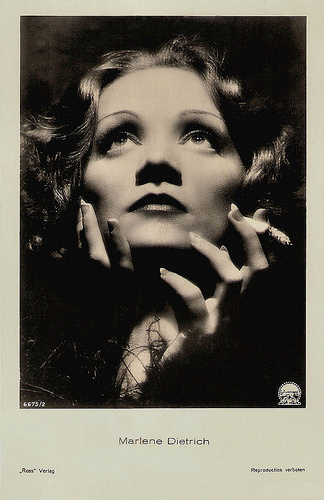
German postcard by Ross Verlag, no. 6673/2, 1931-1932. Photo: Don English / Paramount. Publicity still for Shanghai Express (Josef von Sternberg, 1932).
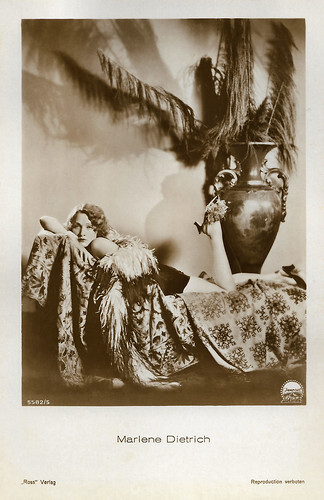
German postcard by Ross Verlag, no. 5582/5, 1930-1931 Photo: Paramount. Marlene Dietrich in Morocco (Josef von Sternberg, 1930).
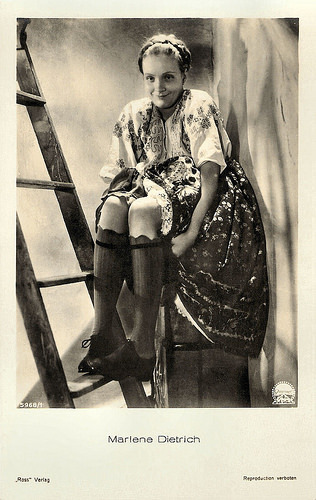
German postcard by Ross Verlag, no. 5968/1, 1930-1931. Photo: Paramount. Marlene Dietrich in Dishonored/Agent X27 (Josef von Sternberg, 1931).
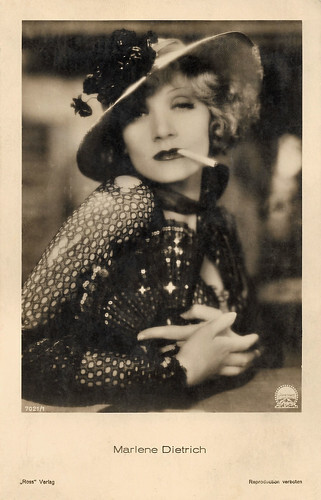
German postcard by Ross Verlag, no. 7021/1, 1932-1933. Photo: Paramount. Marlene Dietrich in Blonde Venus (Josef von Sternberg, 1932).
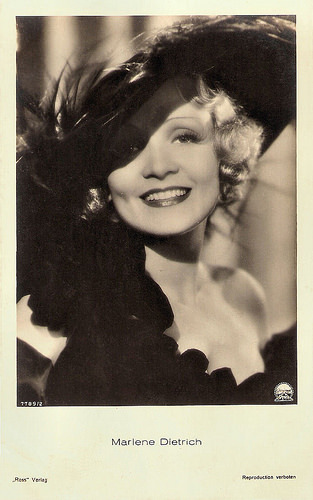
German postcard by Ross Verlag, no. 7789/2, 1932-1933. Photo: Paramount. Marlene Dietrich in The Song of Songs (Rouben Mamoulian, 1933).
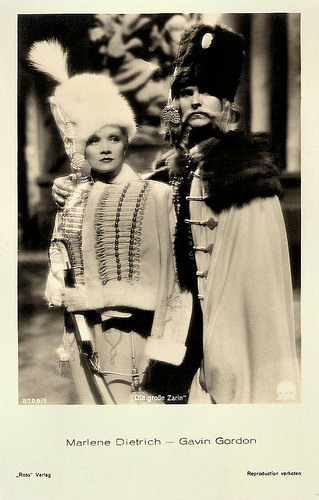
German postcard by Ross Verlag, no. 8709/1, 1933-1934. Photo: Paramount. Publicity still for The Scarlet Empress (Josef von Sternberg, 1934) with Gavin Gordon.
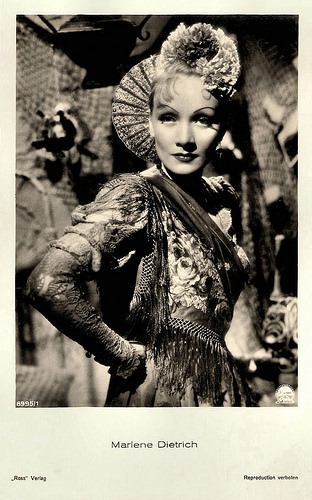
German postcard by Ross Verlag, no. 8995/1, 1933-1934. Photo: Paramount. Publicity still for The Devil Is a Woman (Josef von Sternberg, 1935).
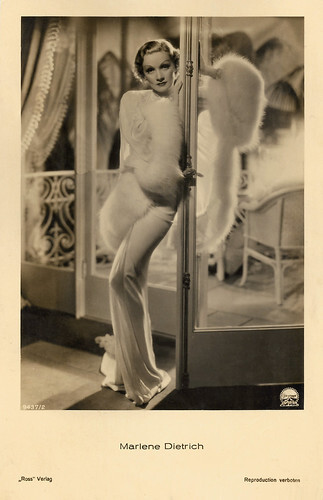
German postcard by Ross Verlag, no. 9437/2, 1935-1936. Photo: Paramount. Marlene Dietrich in Desire (Frank Borzage, 1936).
Josef von Sternberg
On the strength of the success of Der blaue Engel/The Blue Angel (Josef von Sternberg, 1930), and with encouragement and promotion from her director Josef von Sternberg , Marlene Dietrich moved in February 1930 to Hollywood. She left her husband Rudi and daughter Maria behind in Berlin. Paramount wanted to market her as a German answer to MGM's Swedish sensation Greta Garbo . Von Sternberg welcomed her with gifts, including a green Rolls-Royce Phantom II. The car later appeared in their first American film Morocco.
Dietrich starred in six films directed by Josef von Sternberg at Paramount between 1930 and 1935. Von Sternberg worked effectively with Dietrich to create the image of a glamorous and mysterious femme fatale. Wikipedia : "He encouraged her to lose weight and coached her intensively as an actress – she, in turn, was willing to trust him and follow his sometimes imperious direction in a way that a number of other performers resisted." In Morocco (Josef von Sternberg, 1930) with Gary Cooper , Dietrich was again cast as a cabaret singer. The film is best remembered for the sequence in which she performs a song dressed in a man's white tie and kisses another woman, both provocative for the era. The film earned Dietrich her only Academy Award nomination.
Morocco was followed by Dishonored (Josef von Sternberg, 1931), a major success. Dietrich played a Mata Hari-like spy who betrays her country for love of a worthless man ( Victor McLaglen ). Then followed Shanghai Express (Josef von Sternberg, 1932) with Anna May Wong . In this melodrama, Dietrich is a China Coast prostitute who offers herself to a warlord (Warner Oland) to save the life of a former lover ( Clive Brook ). A crucial part of the overall effect of the film was created by von Sternberg's exceptional skill in lighting and photographing Dietrich to optimum effect. In Shanghai Express he masterly uses light and shadow, including the impact of light passed through a veil or slatted blinds. Shanghai Express was dubbed by the critics 'Grand Hotel on wheels' and was another major success. The film earned $1.5 million in worldwide rentals.
Dietrich and von Sternberg again collaborated on the romance Blonde Venus (Josef von Sternberg, 1932) with Cary Grant and little Dickie Moore . Dietrich worked without von Sternberg for the first time in three years in the romantic drama Song of Songs (1933), playing a naïve German peasant, under the direction of Rouben Mamoulian. Then followed The Scarlet Empress (Josef von Sternberg, 1934) with John Lodge, an opulent and visually stunning melodrama about a lascivious Catherine the Great.
Dietrich and Sternberg's last film, The Devil Is a Woman (Josef von Sternberg, 1935) is also the most stylized of their collaborations. It is an erotic tale about a soldier-corrupting vamp in turn-of-the-century Seville. Dietrich later remarked that she was at her most beautiful in The Devil Is a Woman and that the film was her particular favourite. But after the dismal failure of The Devil Is A Woman at the box office, Paramount fired Von Sternberg. The star and director would never work together again.
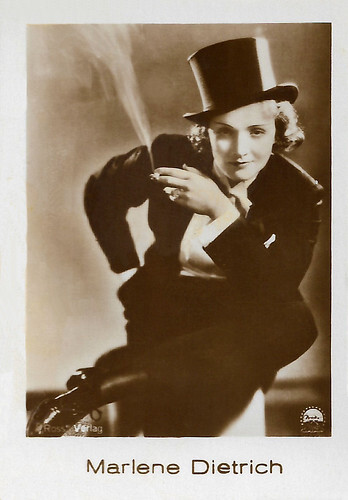
Small German card by Ross Verlag for Hänsom Cigaretten by Jasmatzi Cigaretten-Fabrik G.m.b.H., Dresden, Tonfilmseries, no. 358. Photo: Eugene Robert Richee / Paramount. Marlene Dietrich in Morocco (Josef von Sternberg, 1930).
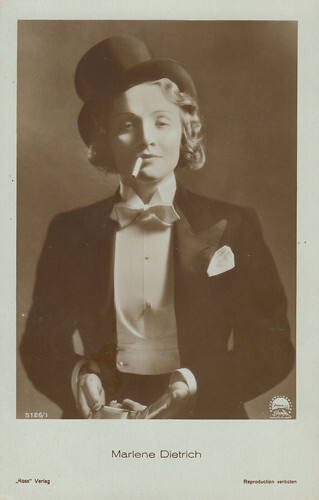
German postcard by Ross Verlag, no. 5126/1, 1930-1931. Photo: Eugene Robert Richee / Paramount. Marlene Dietrich in Morocco (Josef von Sternberg, 1930). Collection: Marlene Pilaete.
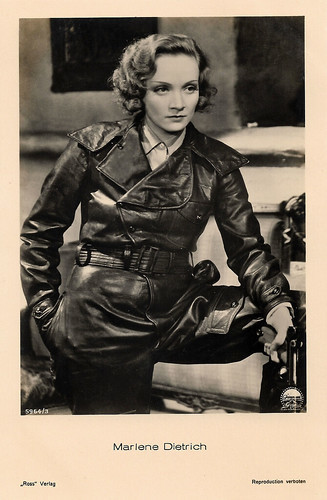
German postcard by Ross Verlag, no. 5964/3, 1930-1931. Photo: Paramount. Marlene Dietrich in Dishonored/Agent X27 (Josef von Sternberg, 1931). Collection: Geoffrey Donaldson Institute.
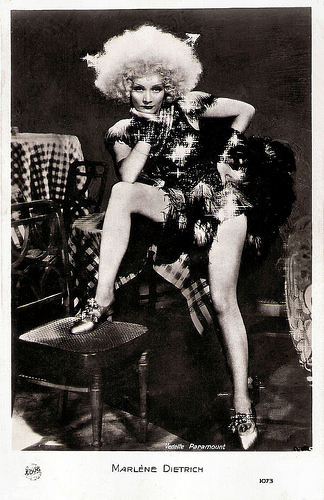
French postcard by EDUG, no. 1073. Photo: Paramount. Publicity still for Blonde Venus (Josef von Sternberg, 1932).
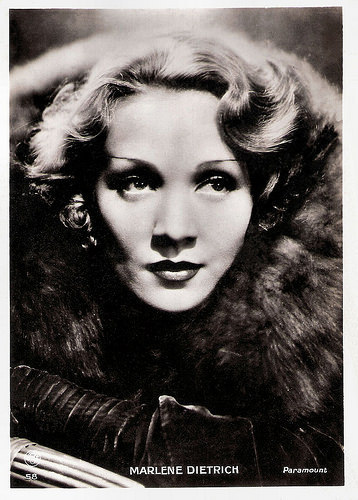
French postcard by Europe, no. 58. Photo: Paramount. Publicity still for Shanghai Express (Josef von Sternberg, 1932).
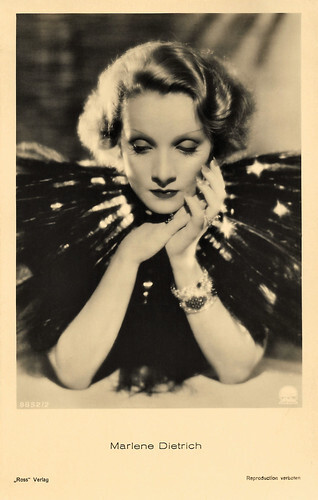
German postcard by Ross Verlag, no. 8852/2, 1933-1934. Photo: William Walling Jr. / Paramount. Marlene Dietrich in Shanghai Express (Josef von Sternberg, 1932).
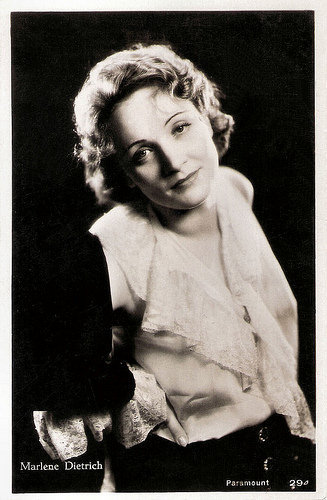
Dutch postcard, no. 294. Photo: Paramount.
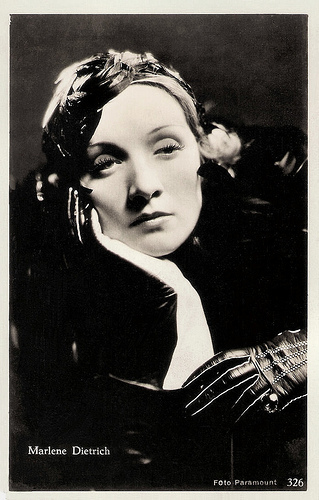
Dutch postcard, no. 326. Sent by mail in the Netherlands in 1934. Photo: Paramount. Publicity still for Shanghai Express (Josef von Sternberg, 1932).
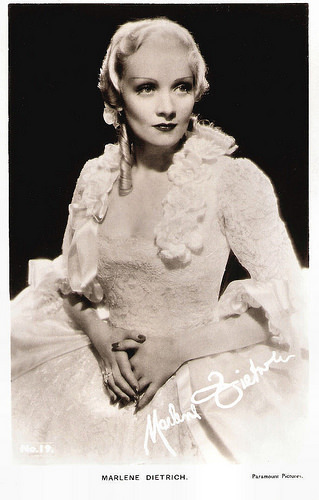
British postcard by Film-Kurier Series, London, no. 19. Photo: Paramount Pictures. Publicity still for The Scarlet Empress (Josef von Sternberg, 1934).
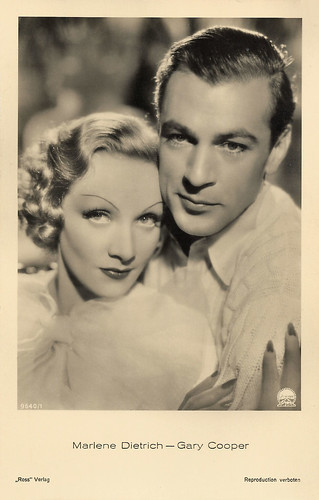
German postcard by Ross Verlag, no. 9640/1, 1935-1936. Photo: Paramount. Marlene Dietrich and Gary Cooper in Desire (Frank Borzage, 1936).
Box office poison
Without Von Sternberg, Marlene Dietrich made her first comedy, Desire (Frank Borzage, 1936). It was a satire about an urbane jewel thief (Dietrich) who steals a choice necklace from a Parisian jeweller and, in efforts to keep it, becomes involved with a hayseed Detroit engineer ( Gary Cooper ). The film was a commercial success that gave Dietrich an opportunity to try her hand at romantic comedy. Her next project, I Loved a Soldier (1936), ended in shambles when the film was scrapped several weeks into production due to script problems, scheduling confusion and the studio's decision to fire the producer Ernst Lubitsch .
Extravagant offers lured Dietrich away from Paramount to make her first colour film The Garden of Allah (Richard Boleslawski, 1936) for independent producer David O. Selznick, for which she received $200,000, and to Britain for Alexander Korda's production, Knight Without Armour (Jacques Feyder, 1937), at a salary of $450,000, which made her one of the best paid film stars of the time. Although Dietrich's salary in the mid 1930s was enormous, she was never listed among the top ten box-office attractions, and depression-era audiences often felt she was preposterously exotic. She was even labelled 'box office poison' after Knight Without Armour proved an expensive flop.
While in London, Dietrich later said in interviews, she was approached by Nazi Party officials and offered lucrative contracts, should she agree to return to be a foremost film star in Nazi Germany. She refused their offers and applied for U.S. citizenship in 1937. She returned to Paramount to make Angel (1937), another romantic comedy directed by Ernst Lubitsch . The film was poorly received, leading Paramount to buy out the remainder of Dietrich's contract. In 1939, her stardom revived when she played the freewheeling saloon entertainer Frenchie in the comic Western Destry Rides Again (George Marshall, 1939) opposite James Stewart . Hollywood's attempt to make her more 'ordinary' worked. The film also introduced another favourite song, 'The Boys in the Back Room'. She played a similar role with John Wayne and Randolph Scott in The Spoilers (Ray Enright, 1942).
Dietrich was known to have strong political convictions and the mind to speak them. In the late 1930s, Dietrich created a fund with Billy Wilder and several other exiles to help Jews and dissidents escape from Germany. In 1937, her entire salary for Knight Without Armor ($450,000) was put into escrow to help the refugees. In 1939, she became an American citizen and renounced her German citizenship. In December 1941, the US entered World War II, and Dietrich became one of the first celebrities to raise war bonds. She toured the US from January 1942 to September 1943 and it is said that she sold more war bonds than any other star. During two extended tours for the USO in 1944 and 1945, she sang and performed the singing saw for Allied troops on the front lines in Algeria, Italy, England and France.
Her revue, with Danny Thomas as her opening act for the first tour, included songs from her films, performances on her musical saw and a 'mindreading' act that her friend Orson Welles had taught her for his Mercury Wonder Show. Dietrich would inform the audience that she could read minds and ask them to concentrate on whatever came into their minds. Then she would walk over to a soldier and earnestly tell him, "Oh, think of something else. I can't possibly talk about that!" American church papers reportedly published stories complaining about this part of Dietrich's act. For musical propaganda broadcasts designed to demoralize enemy soldiers, she recorded a number of songs in German, including the ballad 'Lili Marleen'. The troops loved her. In 1947, she was awarded the Presidential Medal of Freedom by the US for her wartime work. In 1950, the French state conferred the title of 'Chevalier de la Légion d' Honneur' (Knight of the Legion of Honour) on her, in 1971 she was named 'Officier' by President Pompidou and in 1989 'Commandeur' by President Mitterrand.
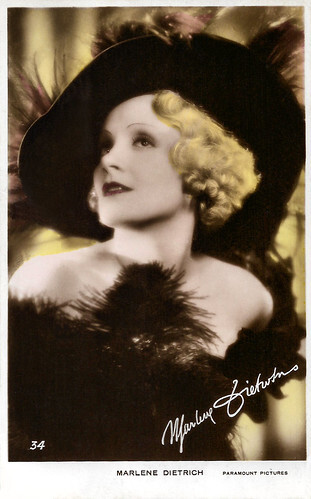
British postcard, no. 34. Photo: Paramount Pictures. Marlene Dietrich in The Song of Songs (Rouben Mamoulian, 1932), based on 'Das hohe Lied' by German author Hermann Sudermann.
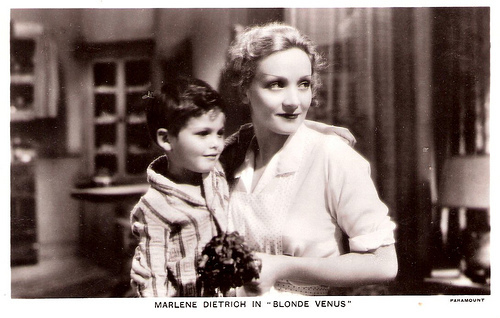
British postcard, distributed in the Netherlands by M. Bonnist & Zonen, Amsterdam, no. 136e. Photo: Paramount. Publicity still for Blonde Venus (Josef von Sternberg, 1932) with Dickie Moore.
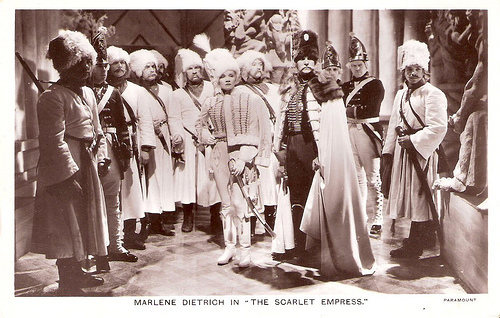
British-Dutch postcard by M. Bonnist & Zonen, Amsterdam, no. B 351. Photo: Paramount. Publicity still for The Scarlet Empress (Josef von Sternberg, 1934) with Marlene Dietrich as Catherine the Great, the notorious empress of Russia.
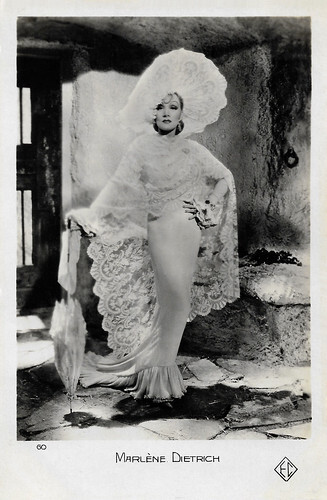
French postcard in Cinémagazine-Edition, no. 60. Photo: Don English / Paramount. Marlene Dietrich in The Devil Is a Woman (Josef von Sternberg, 1935). Costume: Travis Banton.
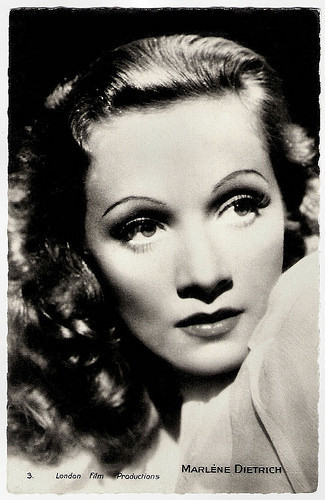
French postcard by Editions Chantal, Rueil, no. 3. Photo: London Film Productions. Publicity still for Knight Without Armour (Jacques Feyder, 1937).
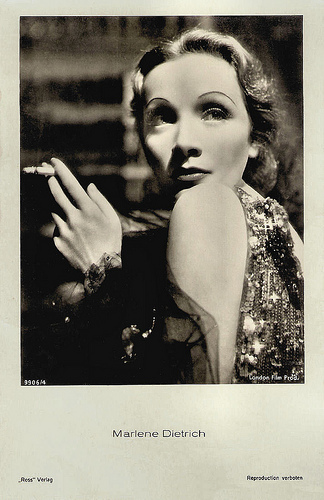
German postcard by Ross Verlag, no. 9906/4, 1935-1936. Photo: London Film Productions. Marlene Dietrich in Knight Without Armour (Jacques Feyder, 1937).
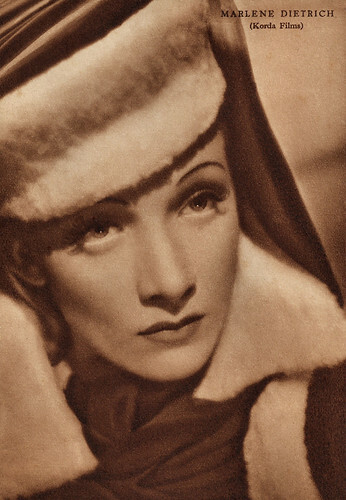
Italian postcard by Rizzoli & c., Milano, 1938 XVI Photo: Korda Films. Marlene Dietrich in Knight Without Armour (Jacques Feyder, 1937).
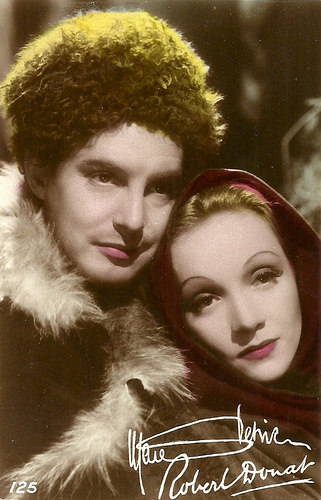
British postcard by Art Photo Postcard, no. 125. Marlene Dietrich and Robert Donat in the London Films production Knight Without Armour (Jacques Feyder, 1937).
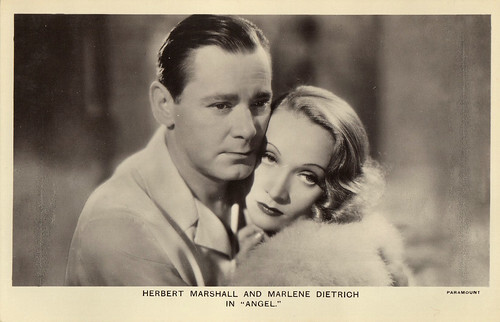
Dutch postcard by M. Bonnist & Zonen, Amsterdam, no. B 480. Photo: Paramount. Herbert Marshall and Marlene Dietrich in Angel (Ernst Lubitsch, 1937). Collection: Marlene Pilaete.
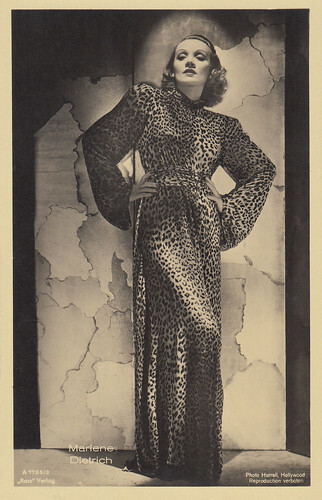
German postcard by Ross Verlag, no. A 1755/3, 1937-1938. Photo: George Hurrell, Hollywood. Collection: Marlene Pilaete.
Body-hugging dresses and careful stage lighting
From the early 1950s until the mid-1970s, Marlene Dietrich worked almost exclusively as a highly-paid cabaret artist, performing live in large theatres in major cities worldwide. Dietrich employed Burt Bacharach as her musical arranger starting in the mid-1950s. Together, they refined her nightclub act into a more ambitious theatrical one-woman show with an expanded repertoire. Her repertoire included songs from her films as well as popular songs of the day. Her costumes (body-hugging dresses covered with thousands of crystals as well as a swansdown coat), body-sculpting undergarments, careful stage lighting helped to preserve Dietrich's glamorous image well into old age.
She never fully regained her former screen glory, but she continued performing in films for distinguished directors. Her successful film roles included an exotic gypsy in Golden Earrings (Mitchell Leisen, 1947), with Ray Milland , an ex-Nazi cafe singer in A Foreign Affair (Billy Wilder, 1948), a famous singer and murderer in Stage Fright (Alfred Hitchcock, 1950), an ageing bandit queen in Rancho Notorious (Fritz Lang, 1952), the wife of a suspected murderer in Witness for the Prosecution (Billy Wilder, 1957), a cynical brothel-keeper in Touch of Evil (Orson Welles, 1958), and the aristocratic widow of a prominent Nazi general in Judgment at Nuremberg (Stanley Kramer, 1961).
Dietrich's show business career largely ended in 1975, when she broke her leg during a stage performance in Sydney, Australia. Her husband, Rudolf Sieber, died of cancer in 1976. Her final on-camera film appearance was a small role in Schöner Gigolo, armer Gigolo/Just a Gigolo (David Hemmings, 1979), starring David Bowie . Dietrich withdrew to her apartment in Paris. She spent the final 11 years of her life mostly bedridden, allowing only a select few — including family and employees — to enter the apartment. During this time, she was a prolific letter-writer and phone-caller. Her autobiography, 'Nehmt nur mein Leben/Marlene', was published in 1979.
In 1982, she agreed to participate in a documentary film about her life, Marlene (1984), but refused to be filmed. The film's director, Maximilian Schell, was only allowed to record her voice. He used his interviews with her as the basis for the film, set to a collage of film clips from her career. The final film won several European film prizes and received an Academy Award nomination for Best Documentary in 1984. Newsweek named it "a unique film, perhaps the most fascinating and affecting documentary ever made about a great movie star". Her autobiography, 'Ich bin, Gott sei Dank, Berlinerin' (I Am, Thank God, a Berliner) or 'Marlene', was published in 1987.
In 1992, Marlene Dietrich died of renal failure at the age of 90 in Paris. In an obituary The New York Times concluded: "In her films and record-breaking cabaret performances, Miss Dietrich artfully projected cool sophistication, self-mockery and infinite experience. Her sexuality was audacious, her wit was insolent and her manner was ageless. With a world-weary charm and a diaphanous gown showing off her celebrated legs, she was the quintessential cabaret entertainer of Weimar-era Germany." Eight years after her death, a collection of her film costumes, recordings, written documents, photographs, and other personal items was put on permanent display in the Berlin Film Museum (2000). Two years later, Berlin - the city of Dietrich's birth which she shunned for most of her life - declared her an honorary citizen.
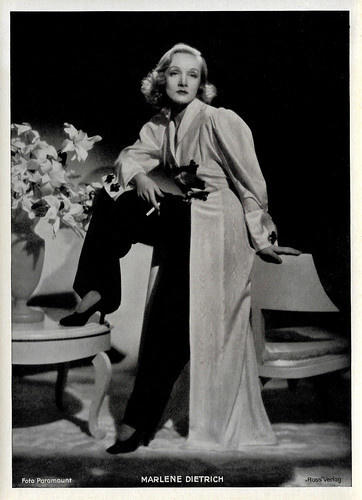
Big German card by Ross Verlag. Photo: Paramount.
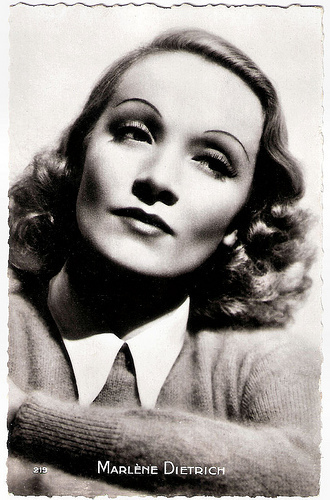
French postcard by Editions P.I., no. 219.
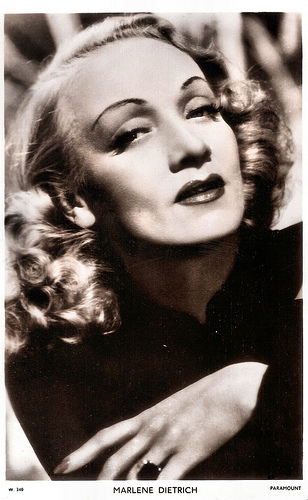
British postcard in the Picturegoer series, London, no. W 340. Photo: Paramount.
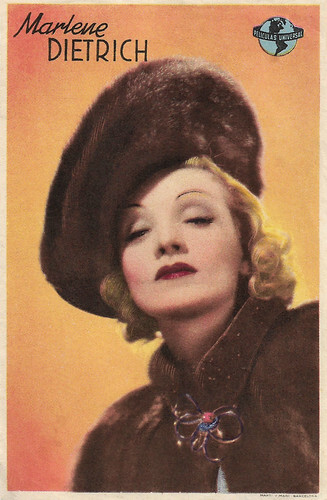
Spanish postcard. Photo: Ray Jones, Universal, 1939.
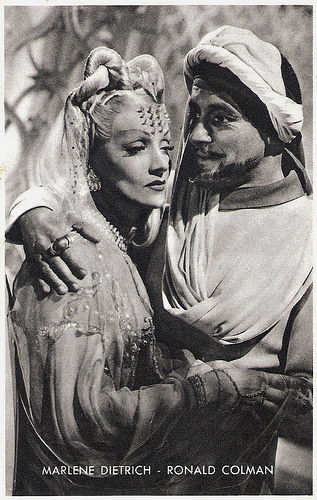
Belgian collectors card by Kwatta, Bois d'Haine, no. C 156. Photo: M.G.M. Publicity still for Kismet (William Dieterle, 1944) with Ronald Colman .
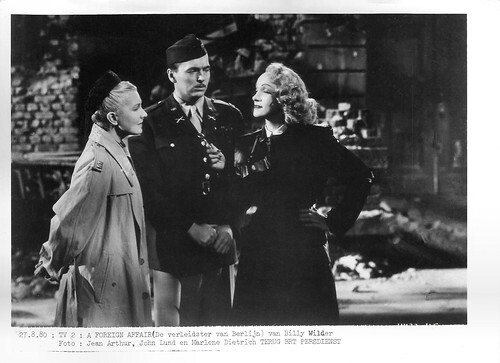
Belgian press photo by BRT Television. Jean Arthur , John Lund and Marlene Dietrich in A Foreign Affair (Billy Wilder, 1948).
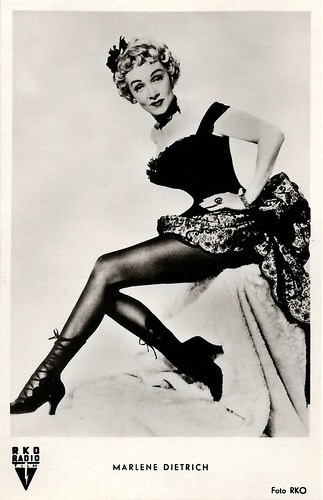
West German postcard by Kunst und Bild, Berlin / Crazy Cards, Berlin. Photo: RKO Radio Film. Marlene Dietrich in Rancho Notorious (Fritz Lang, 1952).
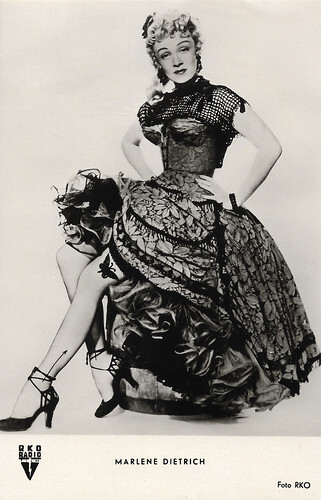
West-German postcard by Kunst und Bild, Berlin / Crazy Cards, Berlin. Photo: RKO Radio Film. Marlene Dietrich in Rancho Notorious (Fritz Lang, 1952).
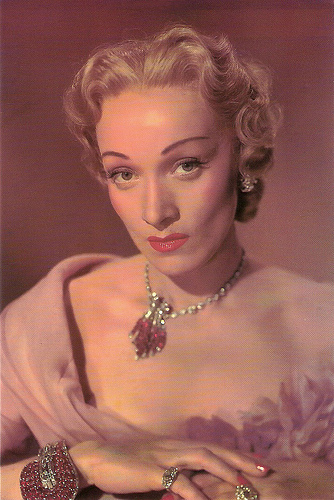
American postcard by Quantity Postcards, Oakland, no. 3372.
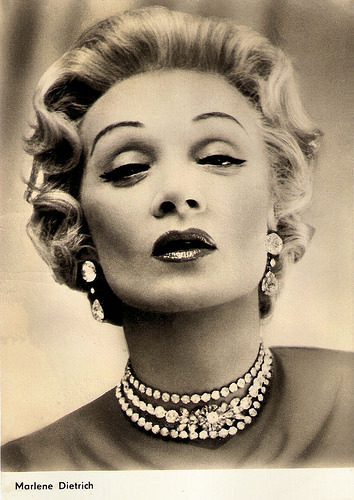
East-German postcard by VEB Progress Filmvertrieb, no. 2.192, 1964.
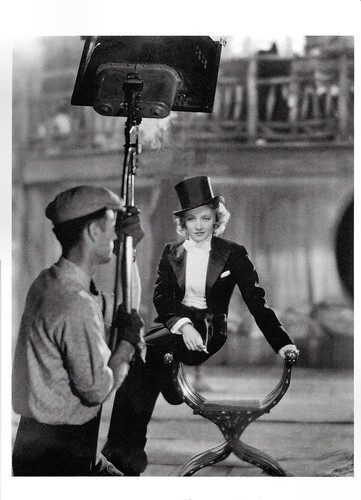
Swiss-German-British postcard by News Productions, Baulmes / Filmwelt Berlin, Bakede / News Productions, Stroud, no. 56481. Photo: Paramount, 1932 / Collection Cinémathèque Suisse, Lausanne.
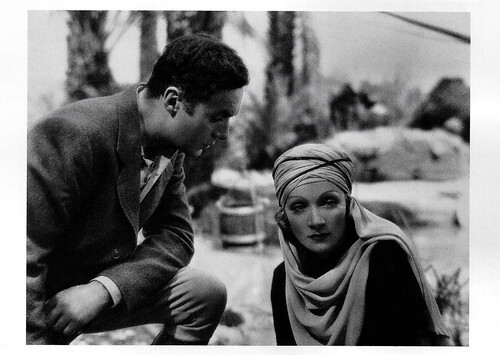
American postcard by Pomegranate Publications, Petaluma, CA, no. 2160. Photo: Popprerfoto, London. Marlene Dietrich and Charles Boyer in Garden of Allah (Richard Boleslawski, 1936).
Sources: James Naremore (Senses of Cinema), Wikipedia, The New York Times, Britannica, and .

German postcard by Ross Verlag, no. 6673/2, 1931-1932. Photo: Don English / Paramount. Publicity still for Shanghai Express (Josef von Sternberg, 1932).

German postcard by Ross Verlag, no. 5582/5, 1930-1931 Photo: Paramount. Marlene Dietrich in Morocco (Josef von Sternberg, 1930).

German postcard by Ross Verlag, no. 5968/1, 1930-1931. Photo: Paramount. Marlene Dietrich in Dishonored/Agent X27 (Josef von Sternberg, 1931).

German postcard by Ross Verlag, no. 7021/1, 1932-1933. Photo: Paramount. Marlene Dietrich in Blonde Venus (Josef von Sternberg, 1932).

German postcard by Ross Verlag, no. 7789/2, 1932-1933. Photo: Paramount. Marlene Dietrich in The Song of Songs (Rouben Mamoulian, 1933).

German postcard by Ross Verlag, no. 8709/1, 1933-1934. Photo: Paramount. Publicity still for The Scarlet Empress (Josef von Sternberg, 1934) with Gavin Gordon.

German postcard by Ross Verlag, no. 8995/1, 1933-1934. Photo: Paramount. Publicity still for The Devil Is a Woman (Josef von Sternberg, 1935).

German postcard by Ross Verlag, no. 9437/2, 1935-1936. Photo: Paramount. Marlene Dietrich in Desire (Frank Borzage, 1936).
Josef von Sternberg
On the strength of the success of Der blaue Engel/The Blue Angel (Josef von Sternberg, 1930), and with encouragement and promotion from her director Josef von Sternberg , Marlene Dietrich moved in February 1930 to Hollywood. She left her husband Rudi and daughter Maria behind in Berlin. Paramount wanted to market her as a German answer to MGM's Swedish sensation Greta Garbo . Von Sternberg welcomed her with gifts, including a green Rolls-Royce Phantom II. The car later appeared in their first American film Morocco.
Dietrich starred in six films directed by Josef von Sternberg at Paramount between 1930 and 1935. Von Sternberg worked effectively with Dietrich to create the image of a glamorous and mysterious femme fatale. Wikipedia : "He encouraged her to lose weight and coached her intensively as an actress – she, in turn, was willing to trust him and follow his sometimes imperious direction in a way that a number of other performers resisted." In Morocco (Josef von Sternberg, 1930) with Gary Cooper , Dietrich was again cast as a cabaret singer. The film is best remembered for the sequence in which she performs a song dressed in a man's white tie and kisses another woman, both provocative for the era. The film earned Dietrich her only Academy Award nomination.
Morocco was followed by Dishonored (Josef von Sternberg, 1931), a major success. Dietrich played a Mata Hari-like spy who betrays her country for love of a worthless man ( Victor McLaglen ). Then followed Shanghai Express (Josef von Sternberg, 1932) with Anna May Wong . In this melodrama, Dietrich is a China Coast prostitute who offers herself to a warlord (Warner Oland) to save the life of a former lover ( Clive Brook ). A crucial part of the overall effect of the film was created by von Sternberg's exceptional skill in lighting and photographing Dietrich to optimum effect. In Shanghai Express he masterly uses light and shadow, including the impact of light passed through a veil or slatted blinds. Shanghai Express was dubbed by the critics 'Grand Hotel on wheels' and was another major success. The film earned $1.5 million in worldwide rentals.
Dietrich and von Sternberg again collaborated on the romance Blonde Venus (Josef von Sternberg, 1932) with Cary Grant and little Dickie Moore . Dietrich worked without von Sternberg for the first time in three years in the romantic drama Song of Songs (1933), playing a naïve German peasant, under the direction of Rouben Mamoulian. Then followed The Scarlet Empress (Josef von Sternberg, 1934) with John Lodge, an opulent and visually stunning melodrama about a lascivious Catherine the Great.
Dietrich and Sternberg's last film, The Devil Is a Woman (Josef von Sternberg, 1935) is also the most stylized of their collaborations. It is an erotic tale about a soldier-corrupting vamp in turn-of-the-century Seville. Dietrich later remarked that she was at her most beautiful in The Devil Is a Woman and that the film was her particular favourite. But after the dismal failure of The Devil Is A Woman at the box office, Paramount fired Von Sternberg. The star and director would never work together again.

Small German card by Ross Verlag for Hänsom Cigaretten by Jasmatzi Cigaretten-Fabrik G.m.b.H., Dresden, Tonfilmseries, no. 358. Photo: Eugene Robert Richee / Paramount. Marlene Dietrich in Morocco (Josef von Sternberg, 1930).

German postcard by Ross Verlag, no. 5126/1, 1930-1931. Photo: Eugene Robert Richee / Paramount. Marlene Dietrich in Morocco (Josef von Sternberg, 1930). Collection: Marlene Pilaete.

German postcard by Ross Verlag, no. 5964/3, 1930-1931. Photo: Paramount. Marlene Dietrich in Dishonored/Agent X27 (Josef von Sternberg, 1931). Collection: Geoffrey Donaldson Institute.

French postcard by EDUG, no. 1073. Photo: Paramount. Publicity still for Blonde Venus (Josef von Sternberg, 1932).

French postcard by Europe, no. 58. Photo: Paramount. Publicity still for Shanghai Express (Josef von Sternberg, 1932).

German postcard by Ross Verlag, no. 8852/2, 1933-1934. Photo: William Walling Jr. / Paramount. Marlene Dietrich in Shanghai Express (Josef von Sternberg, 1932).

Dutch postcard, no. 294. Photo: Paramount.

Dutch postcard, no. 326. Sent by mail in the Netherlands in 1934. Photo: Paramount. Publicity still for Shanghai Express (Josef von Sternberg, 1932).

British postcard by Film-Kurier Series, London, no. 19. Photo: Paramount Pictures. Publicity still for The Scarlet Empress (Josef von Sternberg, 1934).

German postcard by Ross Verlag, no. 9640/1, 1935-1936. Photo: Paramount. Marlene Dietrich and Gary Cooper in Desire (Frank Borzage, 1936).
Box office poison
Without Von Sternberg, Marlene Dietrich made her first comedy, Desire (Frank Borzage, 1936). It was a satire about an urbane jewel thief (Dietrich) who steals a choice necklace from a Parisian jeweller and, in efforts to keep it, becomes involved with a hayseed Detroit engineer ( Gary Cooper ). The film was a commercial success that gave Dietrich an opportunity to try her hand at romantic comedy. Her next project, I Loved a Soldier (1936), ended in shambles when the film was scrapped several weeks into production due to script problems, scheduling confusion and the studio's decision to fire the producer Ernst Lubitsch .
Extravagant offers lured Dietrich away from Paramount to make her first colour film The Garden of Allah (Richard Boleslawski, 1936) for independent producer David O. Selznick, for which she received $200,000, and to Britain for Alexander Korda's production, Knight Without Armour (Jacques Feyder, 1937), at a salary of $450,000, which made her one of the best paid film stars of the time. Although Dietrich's salary in the mid 1930s was enormous, she was never listed among the top ten box-office attractions, and depression-era audiences often felt she was preposterously exotic. She was even labelled 'box office poison' after Knight Without Armour proved an expensive flop.
While in London, Dietrich later said in interviews, she was approached by Nazi Party officials and offered lucrative contracts, should she agree to return to be a foremost film star in Nazi Germany. She refused their offers and applied for U.S. citizenship in 1937. She returned to Paramount to make Angel (1937), another romantic comedy directed by Ernst Lubitsch . The film was poorly received, leading Paramount to buy out the remainder of Dietrich's contract. In 1939, her stardom revived when she played the freewheeling saloon entertainer Frenchie in the comic Western Destry Rides Again (George Marshall, 1939) opposite James Stewart . Hollywood's attempt to make her more 'ordinary' worked. The film also introduced another favourite song, 'The Boys in the Back Room'. She played a similar role with John Wayne and Randolph Scott in The Spoilers (Ray Enright, 1942).
Dietrich was known to have strong political convictions and the mind to speak them. In the late 1930s, Dietrich created a fund with Billy Wilder and several other exiles to help Jews and dissidents escape from Germany. In 1937, her entire salary for Knight Without Armor ($450,000) was put into escrow to help the refugees. In 1939, she became an American citizen and renounced her German citizenship. In December 1941, the US entered World War II, and Dietrich became one of the first celebrities to raise war bonds. She toured the US from January 1942 to September 1943 and it is said that she sold more war bonds than any other star. During two extended tours for the USO in 1944 and 1945, she sang and performed the singing saw for Allied troops on the front lines in Algeria, Italy, England and France.
Her revue, with Danny Thomas as her opening act for the first tour, included songs from her films, performances on her musical saw and a 'mindreading' act that her friend Orson Welles had taught her for his Mercury Wonder Show. Dietrich would inform the audience that she could read minds and ask them to concentrate on whatever came into their minds. Then she would walk over to a soldier and earnestly tell him, "Oh, think of something else. I can't possibly talk about that!" American church papers reportedly published stories complaining about this part of Dietrich's act. For musical propaganda broadcasts designed to demoralize enemy soldiers, she recorded a number of songs in German, including the ballad 'Lili Marleen'. The troops loved her. In 1947, she was awarded the Presidential Medal of Freedom by the US for her wartime work. In 1950, the French state conferred the title of 'Chevalier de la Légion d' Honneur' (Knight of the Legion of Honour) on her, in 1971 she was named 'Officier' by President Pompidou and in 1989 'Commandeur' by President Mitterrand.

British postcard, no. 34. Photo: Paramount Pictures. Marlene Dietrich in The Song of Songs (Rouben Mamoulian, 1932), based on 'Das hohe Lied' by German author Hermann Sudermann.

British postcard, distributed in the Netherlands by M. Bonnist & Zonen, Amsterdam, no. 136e. Photo: Paramount. Publicity still for Blonde Venus (Josef von Sternberg, 1932) with Dickie Moore.

British-Dutch postcard by M. Bonnist & Zonen, Amsterdam, no. B 351. Photo: Paramount. Publicity still for The Scarlet Empress (Josef von Sternberg, 1934) with Marlene Dietrich as Catherine the Great, the notorious empress of Russia.

French postcard in Cinémagazine-Edition, no. 60. Photo: Don English / Paramount. Marlene Dietrich in The Devil Is a Woman (Josef von Sternberg, 1935). Costume: Travis Banton.

French postcard by Editions Chantal, Rueil, no. 3. Photo: London Film Productions. Publicity still for Knight Without Armour (Jacques Feyder, 1937).

German postcard by Ross Verlag, no. 9906/4, 1935-1936. Photo: London Film Productions. Marlene Dietrich in Knight Without Armour (Jacques Feyder, 1937).

Italian postcard by Rizzoli & c., Milano, 1938 XVI Photo: Korda Films. Marlene Dietrich in Knight Without Armour (Jacques Feyder, 1937).

British postcard by Art Photo Postcard, no. 125. Marlene Dietrich and Robert Donat in the London Films production Knight Without Armour (Jacques Feyder, 1937).

Dutch postcard by M. Bonnist & Zonen, Amsterdam, no. B 480. Photo: Paramount. Herbert Marshall and Marlene Dietrich in Angel (Ernst Lubitsch, 1937). Collection: Marlene Pilaete.

German postcard by Ross Verlag, no. A 1755/3, 1937-1938. Photo: George Hurrell, Hollywood. Collection: Marlene Pilaete.
Body-hugging dresses and careful stage lighting
From the early 1950s until the mid-1970s, Marlene Dietrich worked almost exclusively as a highly-paid cabaret artist, performing live in large theatres in major cities worldwide. Dietrich employed Burt Bacharach as her musical arranger starting in the mid-1950s. Together, they refined her nightclub act into a more ambitious theatrical one-woman show with an expanded repertoire. Her repertoire included songs from her films as well as popular songs of the day. Her costumes (body-hugging dresses covered with thousands of crystals as well as a swansdown coat), body-sculpting undergarments, careful stage lighting helped to preserve Dietrich's glamorous image well into old age.
She never fully regained her former screen glory, but she continued performing in films for distinguished directors. Her successful film roles included an exotic gypsy in Golden Earrings (Mitchell Leisen, 1947), with Ray Milland , an ex-Nazi cafe singer in A Foreign Affair (Billy Wilder, 1948), a famous singer and murderer in Stage Fright (Alfred Hitchcock, 1950), an ageing bandit queen in Rancho Notorious (Fritz Lang, 1952), the wife of a suspected murderer in Witness for the Prosecution (Billy Wilder, 1957), a cynical brothel-keeper in Touch of Evil (Orson Welles, 1958), and the aristocratic widow of a prominent Nazi general in Judgment at Nuremberg (Stanley Kramer, 1961).
Dietrich's show business career largely ended in 1975, when she broke her leg during a stage performance in Sydney, Australia. Her husband, Rudolf Sieber, died of cancer in 1976. Her final on-camera film appearance was a small role in Schöner Gigolo, armer Gigolo/Just a Gigolo (David Hemmings, 1979), starring David Bowie . Dietrich withdrew to her apartment in Paris. She spent the final 11 years of her life mostly bedridden, allowing only a select few — including family and employees — to enter the apartment. During this time, she was a prolific letter-writer and phone-caller. Her autobiography, 'Nehmt nur mein Leben/Marlene', was published in 1979.
In 1982, she agreed to participate in a documentary film about her life, Marlene (1984), but refused to be filmed. The film's director, Maximilian Schell, was only allowed to record her voice. He used his interviews with her as the basis for the film, set to a collage of film clips from her career. The final film won several European film prizes and received an Academy Award nomination for Best Documentary in 1984. Newsweek named it "a unique film, perhaps the most fascinating and affecting documentary ever made about a great movie star". Her autobiography, 'Ich bin, Gott sei Dank, Berlinerin' (I Am, Thank God, a Berliner) or 'Marlene', was published in 1987.
In 1992, Marlene Dietrich died of renal failure at the age of 90 in Paris. In an obituary The New York Times concluded: "In her films and record-breaking cabaret performances, Miss Dietrich artfully projected cool sophistication, self-mockery and infinite experience. Her sexuality was audacious, her wit was insolent and her manner was ageless. With a world-weary charm and a diaphanous gown showing off her celebrated legs, she was the quintessential cabaret entertainer of Weimar-era Germany." Eight years after her death, a collection of her film costumes, recordings, written documents, photographs, and other personal items was put on permanent display in the Berlin Film Museum (2000). Two years later, Berlin - the city of Dietrich's birth which she shunned for most of her life - declared her an honorary citizen.

Big German card by Ross Verlag. Photo: Paramount.

French postcard by Editions P.I., no. 219.

British postcard in the Picturegoer series, London, no. W 340. Photo: Paramount.

Spanish postcard. Photo: Ray Jones, Universal, 1939.

Belgian collectors card by Kwatta, Bois d'Haine, no. C 156. Photo: M.G.M. Publicity still for Kismet (William Dieterle, 1944) with Ronald Colman .

Belgian press photo by BRT Television. Jean Arthur , John Lund and Marlene Dietrich in A Foreign Affair (Billy Wilder, 1948).

West German postcard by Kunst und Bild, Berlin / Crazy Cards, Berlin. Photo: RKO Radio Film. Marlene Dietrich in Rancho Notorious (Fritz Lang, 1952).

West-German postcard by Kunst und Bild, Berlin / Crazy Cards, Berlin. Photo: RKO Radio Film. Marlene Dietrich in Rancho Notorious (Fritz Lang, 1952).

American postcard by Quantity Postcards, Oakland, no. 3372.

East-German postcard by VEB Progress Filmvertrieb, no. 2.192, 1964.

Swiss-German-British postcard by News Productions, Baulmes / Filmwelt Berlin, Bakede / News Productions, Stroud, no. 56481. Photo: Paramount, 1932 / Collection Cinémathèque Suisse, Lausanne.

American postcard by Pomegranate Publications, Petaluma, CA, no. 2160. Photo: Popprerfoto, London. Marlene Dietrich and Charles Boyer in Garden of Allah (Richard Boleslawski, 1936).
Sources: James Naremore (Senses of Cinema), Wikipedia, The New York Times, Britannica, and .
Published on June 28, 2024 22:00
June 27, 2024
Richard Häussler
One of the interesting programmes of Il Cinema Ritrovato 2024 is 'Dark Heimat', curated by Olaf Möller. The late 1940s and very early 1950s saw a scattered production of films in which the worries of today and the pain and shameful memories of the recent past were discussed in stories set at the edges of Germany and Austria – in the rural far-away of the Alpine regions. In terms of genre, they’re rooted in what soon would be called 'Heimatfilm': films set in specific landscapes whose people are seen as paragons of traditions needed to face the challenges of modern (city) life. But in contrast to the official Heimatfilm classics, a gem like Die Alm an der Grenze (1951) starring Richard Häussler had more to do with Film Noir and offers unexpected insights into a transitional period of Germany and Austria. The film and its star are little known even in Germany, so EFSP puts the spot on Richard Häussler.
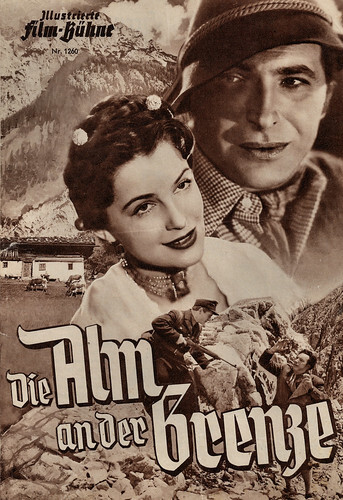
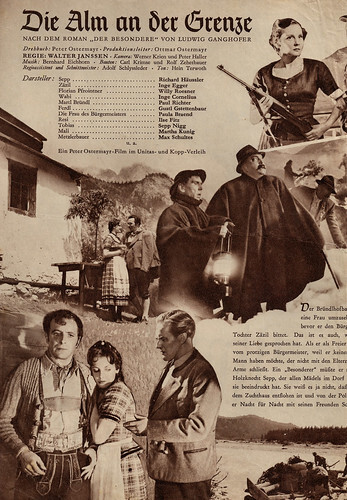
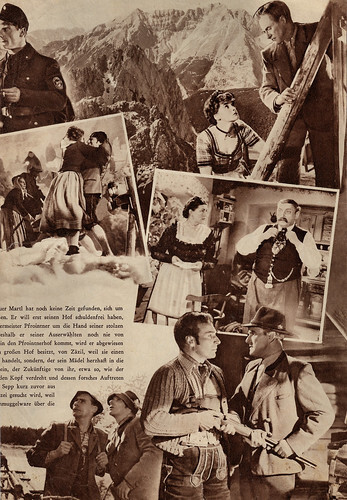
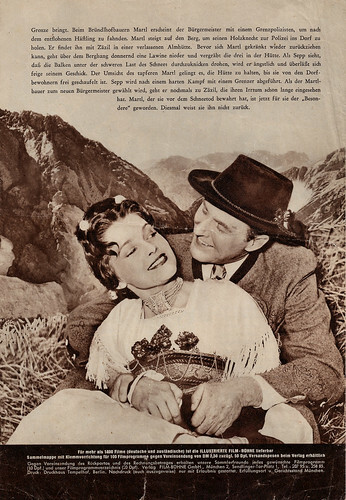
German flyer by Illustrierte Film-Bühne, no. 1260. Photos: Peter Ostermayr-Film / Unitas un Kopp Verleih. Richard Häussler and Inge Egger in Die Alm an der Grenze/The Mountain Pasture on the Border (Walter Janssen, 1951).
Richard Häussler (1908-1964) was a German character actor and occasional director. He appeared in more than 60 films between 1936 and 1964. He also directed seven films between 1951 and 1957.
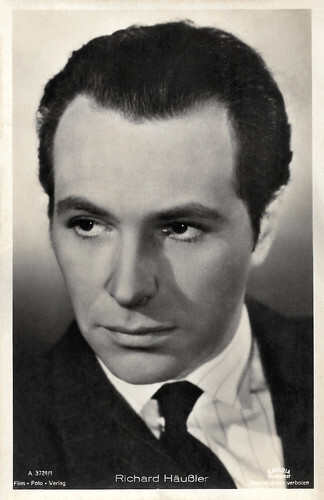
German postcard by Film-Foto-Verlag, no. A 3427/1, 1941-1944. Photo: Bavaria Filmkunst.
One of the few German colour films during the war
Richard Häussler was born in 1908 in Munich, Germany. He made his stage debut in 1926 and acted in youthful leading roles. His film debut followed in the Bavarian crime comedy Der ahnungslose Engel/The Unsuspecting Angel (Franz Seitz, 1936) starring Joe Stöckel and Lucie Englisch .
He also appeared in the historical drama Maria Ilona (Géza von Bolvary, 1939) starring Paula Wessely and Willy Birgel . The film is set in Austria during the reign of Ferdinand I. During the war, he had a role in Der Fuchs von Glenarvon/The Fox of Glenarvon (Max W. Kimmich, 1940), a Nazi propaganda film portraying the years of the Irish fight for independence during World War I. It starred Olga Tschechova , Karl Ludwig Diehl and Ferdinand Marian .
He had a bigger part in the drama Mädchen im Vorzimmer/The Girl at the Reception (Gerhard Lamprecht, 1940) starring Magda Schneider , Heinz Engelmann, and Carsta Löck . He also appeared in the historical drama Komödianten/The Comedians (G. W. Pabst, 1941) starring Käthe Dorsch , Hilde Krahl and Henny Porten and based on the novel 'Philine' by Olly Boeheim. The film is set in the eighteenth century and portrays the development of German theatre.
Richard Häussler also played supporting parts in the dramas Das andere Ich/Her Other Self (Wolfgang Liebeneiner, 1941) starring Hilde Krahl, and Geheimakte W.B.1 (Herbert Selpin, 1942) starring Alexander Golling. The film portrays Wilhelm Bauer and his work on developing the submarine.
He played a leading role opposite Annelies Reinhold in the drama Violanta (Paul May, 1942). He co-starred with Will Dohm and Heli Finkenzeller in the comedy Das Bad auf der Tenne/The Bath in the Barn (Volker von Collande, 1943). The film was shot in Agfacolor, one of only a few German films made in colour during the war years.
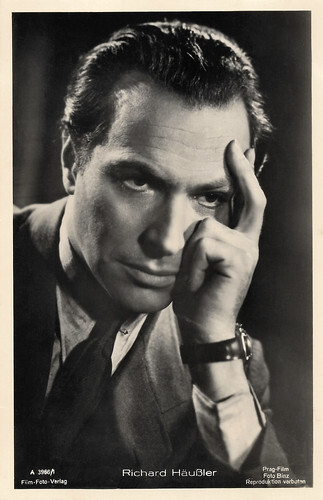
German postcard by Film-Foto-Verlag, no. A 3966/1, 1941-1944. Photo: Prag-Film / Binz.
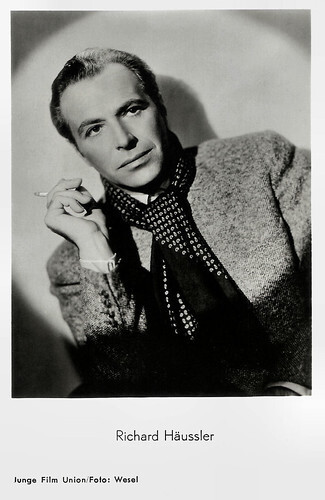
West German postcard by F.J. Rúdel, Filmpostkarten-Verlag, Hamburg-Bergedorf, no. 124. Photo: Wesel / Junge Film Union.
A mainstay of Bavarian Heimatfilms
Richard Häussler could continue his career after the war and he was able to prove his acting abilities in popular films such as Wozzeck (Georg C. Klaren, 1947) starring Kurt Meisel, Das verlorene Gesicht/The Lost Face (Kurt Hoffmann, 1948) starring Marianne Hoppe and Gustav Fröhlich and the historical adventure film Der Bagnosträfling/The Prisoner (1949).
He directed the drama Die Martinsklause/The Cloister of Martins (Richard Häussler, 1951) starring Willy Rösner. Based on the novel of the same title by Ludwig Ganghofer, it was part of the postwar wave of Heimat films in Germany.
Häussler became a mainstay of Bavarian Heimatfilms, often in the role of well-to-do or gentlemanly professional men. To his other well-known post-war films belong the Austrian-German crime film Die Todesarena/Arena of Death (Kurt Meisel, 1953), the East German crime film Das Fräulein von Scuderi (Eugen York, 1955) starring Henny Porten in her last film role, and the TV film Affäre Dreyfus/The Dreyfus Affair (Hanns Farenburg, 1959).
Out of character, he played a gangster in the Edgar Wallace thriller Zimmer 13/Room 13 (Harald Reinl, 1964). His final film was a Spanish Spaghetti Western Los Pistoleros de Arizona/Five Thousand Dollars on One Ace (Alfonso Balcázar, 1964), starring Robert Woods.
Richard Häussler died in 1964 in Munich, Bavaria, West Germany. He was married to actress Maria Andergast from 1958 till his death.
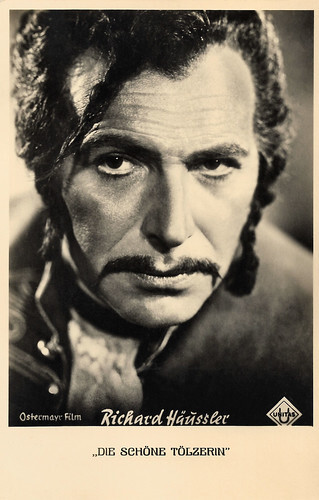
West German postcard. Photo: Ostermayr-Film / Unitas. Richard Häussler in Die schöne Tölzerin/The Beautiful Girl From Tölz (Richard Häussler, 1952).
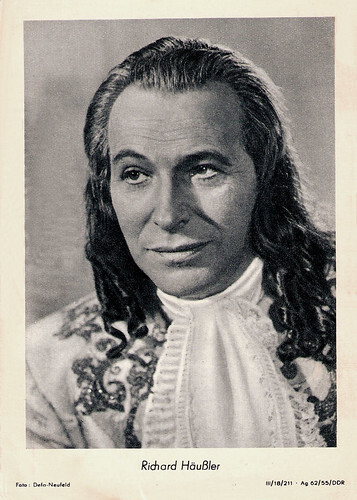
East German card, no. 62/55. Photo: DEFA / Neufeld. Richard Häussler in Das Fräulein von Scuderi/Mademoiselle de Scuderi (Eugen York, 1955).
Sources: Wikipedia (English and German) and .




German flyer by Illustrierte Film-Bühne, no. 1260. Photos: Peter Ostermayr-Film / Unitas un Kopp Verleih. Richard Häussler and Inge Egger in Die Alm an der Grenze/The Mountain Pasture on the Border (Walter Janssen, 1951).
Richard Häussler (1908-1964) was a German character actor and occasional director. He appeared in more than 60 films between 1936 and 1964. He also directed seven films between 1951 and 1957.

German postcard by Film-Foto-Verlag, no. A 3427/1, 1941-1944. Photo: Bavaria Filmkunst.
One of the few German colour films during the war
Richard Häussler was born in 1908 in Munich, Germany. He made his stage debut in 1926 and acted in youthful leading roles. His film debut followed in the Bavarian crime comedy Der ahnungslose Engel/The Unsuspecting Angel (Franz Seitz, 1936) starring Joe Stöckel and Lucie Englisch .
He also appeared in the historical drama Maria Ilona (Géza von Bolvary, 1939) starring Paula Wessely and Willy Birgel . The film is set in Austria during the reign of Ferdinand I. During the war, he had a role in Der Fuchs von Glenarvon/The Fox of Glenarvon (Max W. Kimmich, 1940), a Nazi propaganda film portraying the years of the Irish fight for independence during World War I. It starred Olga Tschechova , Karl Ludwig Diehl and Ferdinand Marian .
He had a bigger part in the drama Mädchen im Vorzimmer/The Girl at the Reception (Gerhard Lamprecht, 1940) starring Magda Schneider , Heinz Engelmann, and Carsta Löck . He also appeared in the historical drama Komödianten/The Comedians (G. W. Pabst, 1941) starring Käthe Dorsch , Hilde Krahl and Henny Porten and based on the novel 'Philine' by Olly Boeheim. The film is set in the eighteenth century and portrays the development of German theatre.
Richard Häussler also played supporting parts in the dramas Das andere Ich/Her Other Self (Wolfgang Liebeneiner, 1941) starring Hilde Krahl, and Geheimakte W.B.1 (Herbert Selpin, 1942) starring Alexander Golling. The film portrays Wilhelm Bauer and his work on developing the submarine.
He played a leading role opposite Annelies Reinhold in the drama Violanta (Paul May, 1942). He co-starred with Will Dohm and Heli Finkenzeller in the comedy Das Bad auf der Tenne/The Bath in the Barn (Volker von Collande, 1943). The film was shot in Agfacolor, one of only a few German films made in colour during the war years.

German postcard by Film-Foto-Verlag, no. A 3966/1, 1941-1944. Photo: Prag-Film / Binz.

West German postcard by F.J. Rúdel, Filmpostkarten-Verlag, Hamburg-Bergedorf, no. 124. Photo: Wesel / Junge Film Union.
A mainstay of Bavarian Heimatfilms
Richard Häussler could continue his career after the war and he was able to prove his acting abilities in popular films such as Wozzeck (Georg C. Klaren, 1947) starring Kurt Meisel, Das verlorene Gesicht/The Lost Face (Kurt Hoffmann, 1948) starring Marianne Hoppe and Gustav Fröhlich and the historical adventure film Der Bagnosträfling/The Prisoner (1949).
He directed the drama Die Martinsklause/The Cloister of Martins (Richard Häussler, 1951) starring Willy Rösner. Based on the novel of the same title by Ludwig Ganghofer, it was part of the postwar wave of Heimat films in Germany.
Häussler became a mainstay of Bavarian Heimatfilms, often in the role of well-to-do or gentlemanly professional men. To his other well-known post-war films belong the Austrian-German crime film Die Todesarena/Arena of Death (Kurt Meisel, 1953), the East German crime film Das Fräulein von Scuderi (Eugen York, 1955) starring Henny Porten in her last film role, and the TV film Affäre Dreyfus/The Dreyfus Affair (Hanns Farenburg, 1959).
Out of character, he played a gangster in the Edgar Wallace thriller Zimmer 13/Room 13 (Harald Reinl, 1964). His final film was a Spanish Spaghetti Western Los Pistoleros de Arizona/Five Thousand Dollars on One Ace (Alfonso Balcázar, 1964), starring Robert Woods.
Richard Häussler died in 1964 in Munich, Bavaria, West Germany. He was married to actress Maria Andergast from 1958 till his death.

West German postcard. Photo: Ostermayr-Film / Unitas. Richard Häussler in Die schöne Tölzerin/The Beautiful Girl From Tölz (Richard Häussler, 1952).

East German card, no. 62/55. Photo: DEFA / Neufeld. Richard Häussler in Das Fräulein von Scuderi/Mademoiselle de Scuderi (Eugen York, 1955).
Sources: Wikipedia (English and German) and .
Published on June 27, 2024 22:00
June 26, 2024
Pietro Germi: a troublesome witness
Emiliano Morreale curated for Il Cinema Ritrovato 2024 the programme 'Pietro Germi: a troublesome witness'. The Italian Pietro Germi (1914-1974) was an internationally successful director who played a crucial role in key periods of Italian cinema history such as Neorealism and Commedia all’italiana. Although he is beloved by younger colleagues like Wes Anderson, Germi nonetheless came across as a surly, aloof filmmaker. His vision of gender relations was considered to be politically incorrect and he was viewed with deep suspicion by the left-wing cultural establishment.
Only decades after his death, Germi was finally and rightly recognised as one of Italian cinema’s greats. His pessimistic vision of human relations took shape through a highly original reworking of genres: from the Western like In nome della legge/In the Name of the Law (1949), the first film ever made about the mafia, to melodrama like Il ferroviere (1956), Film Noir like La città si difende (1951), detective mystery like Un maledetto imbroglio (1959) and black comedy like Divorzio all’italiana (1961). Germi never claimed to be an auteur and remained faithful to a vocation as a popular filmmaker. He consistently emphasised the perfectly written screenplay, the mise-en-scene, the film’s rhythm, and the direction of his actors. For this EFSP post, we chose twelve postcards of Germi's leading actors.
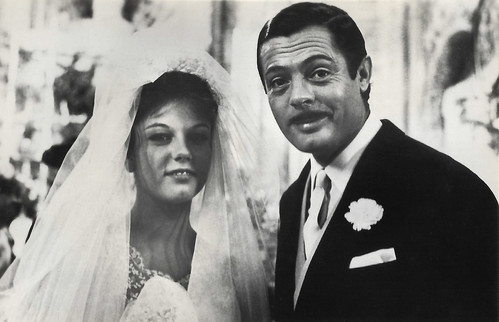
Small Czech collector card by Pressfoto, Praha (Prague), 1965, no. S 83/6. Stefania Sandrelli and Marcello Mastroianni in Divorzio all'italiana/Divorce, Italian Style (Pietro Germi, 1961).
In 1961, Pietro Gwermi stunned audiences and critics alike with his biting, satirical and grotesque comedy Divorzio all'italiana/Divorce, Italian Style (1961). Germi won the Oscar for Best Original Screenplay and earned a Best Director nomination at the 35th Academy Awards. Stefania Sandrelli (1946) was 15 years old when she had her breakthrough in this Commedia all’italiana. Her co-star, Marcello Mastroianni (1924-1996) almost singlehandedly defined the contemporary type of Latin lover, then proceeded to redefine it a dozen times and finally parodied it in films like Divorzio all'italiana and played it against type.
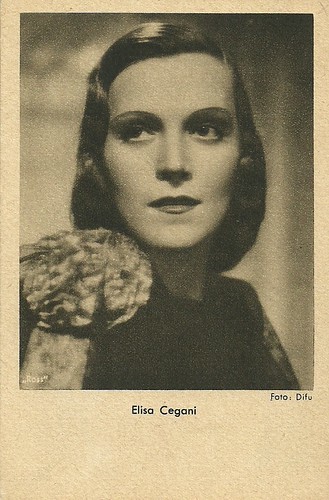
German postcard for Das Programm von Heute, Berlin, by Ross Verlag. Photo: Difu.
Elisa Cegani (1911–1996) was one of the most representative actresses of Italian cinema of the thirties and forties. She was the leading lady, a pianist in the comedy Retroscena/Backstage (Alessandro Blasetti, 1939) for which 25-year-old Pietro Germi co-wrote the screenplay. Germi studied at the Centro Sperimentale di Cinematografia in Rome and attended Blasetti's directing courses. Retroscena was a flop and Blasetti always considered it the worst film of his career.
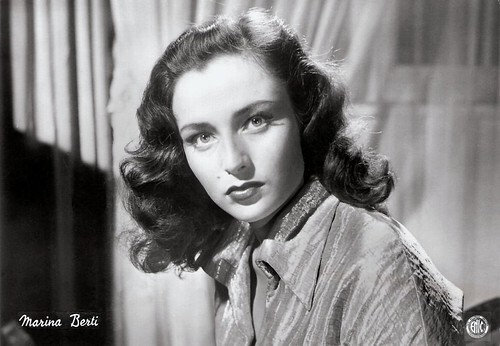
Italian postcard by Bromofoto, Milano (Milan), no. 981. Photo: ENIC.
Italian actress Marina Berti (1924-2002) was a popular starlet in Italian films in the 1940s and early 1950s. She was the leading lady in the psychological thriller Il testimone/The Witness (1946), Pietro Germi's debut as a director. Already evident here is Germi's skill with actors. He puts Berti's sensitivity and delicate beauty to good use in the film as Linda, a newly-married woman whose husband Ernesto is showing increasingly irrational behaviour. Unbeknown to her he has a skeleton in the closet. Germi's early films were in the Neorealist style though a psychological thriller was quite unusual in the years of Neorealism. Many of his other films were social dramas dealing with contemporary issues of people of Sicilian heritage.
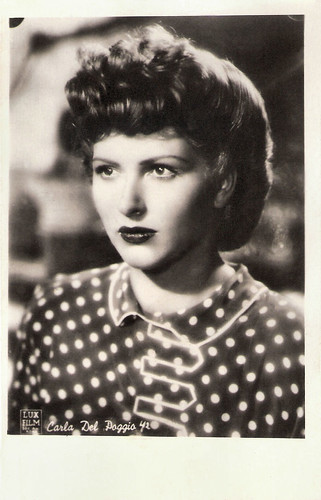
Italian postcard, no. 3. Photo: Lux Film. Carla del Poggio in Gioventù perduta/Lost Youth (Pietro Germi, 1948).
Italian actress Carla Del Poggio (1925-2010) was the female star of Federico Fellini’s bittersweet film debut Luci del varietà/Variety Lights (1950). In the 1940s and 1950s, she also starred in films by other famous directors such as Vittorio De Sica, her husband Alberto Lattuada, and Pietro Germi. The crime drama Gioventù perduta/Lost Youth (Pietro Germi, 1948) was Germi's second film. Del Poggio stars as the sister of a psychopath (Jacques Sernas) who leads students into crime. This crime film is also a study of how family and friends can be completely blind to a sociopathic killer in their midst.
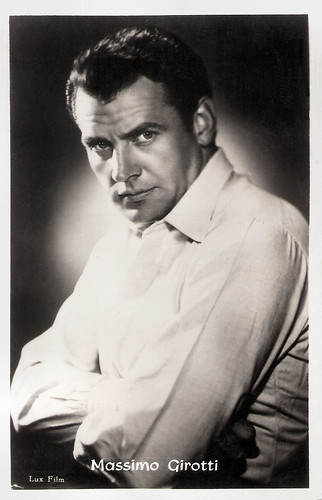
Italian card. Photo: Lux Film.
Handsome, manly Italian actor Massimo Girotti (1918-2003) had a career that spanned seven decades. He starred in Luchino Visconti's Ossessione, Michelangelo Antonioni's Cronaca di un amore and Visconti's Senso. He also appeared in a few films by Pietro Germi. He plays in In nome della legge/In the Name of the Law (Pietro Germi, 1949) a young, by-the-book judge who is appointed to a Sicilian village controlled by corrupt leaders and the Mafia. Germi was obviously influenced by the Western: how the Mafia ride into town, shotguns at their backs, Carlo Rustichelli's English-horn-dominated music raising the blood, while the hero is about to stand off the gang of bandits. In nome della legge won three Silver Ribbons and was a box-office hit.
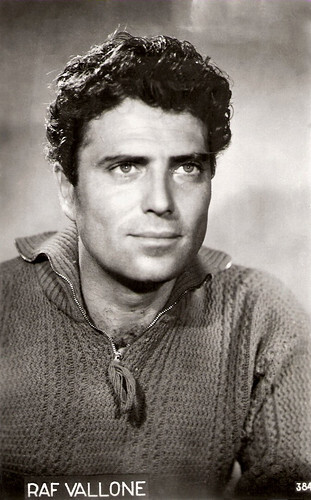
French postcard by Editions P.I., Paris, no. 14 E/384.
In the year after the international box office success of Riso Amaro/Bitter Rice (1949) propelled Raf Vallone (1916-2002) into international stardom, he starred as a desperate immigrant in Pietro Germi's Neorealist drama Il cammino della speranza/The Path of Hope (Pietro Germi, 1950). This powerful, monumental film was inspired by a novel by Nino di Maria and had a screenplay by Federico Fellini, Tullio Pinelli and Germi. Germi handled the burgeoning relationship between two Sicilian immigrants (Vallone and his wife Elena Varzi) beautifully and sensitively. The film was presented in competition at Cannes and won the Silver Bear and the Golden Bear at the Berlin Film Festival.
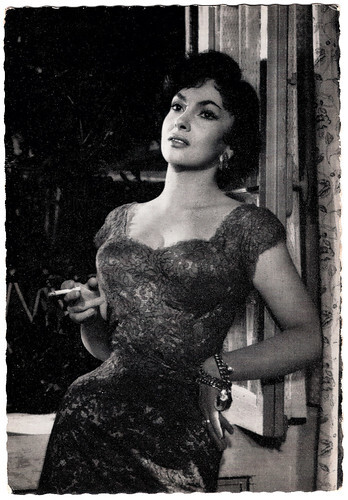
German postcard, no. 15. Sent by mail in the Netherlands in 1961. Collection: Geoffrey Donaldson Institute.
Gorgeous Gina Lollobrigida (1927-2023) was the leading lady of the interesting and effective Film Noir La città si difende/Four Ways Out (Pietro Germi, 1951). Germi followed the results of a big robbery in a different way. Instead of focusing on how the police try to track down the robbers, Germi concentrated on how the crime affects the lives of the thieves and their families. He brought the story alive with several nice cinematic touches, cross-cutting, solid character acting and a tense, emotional finale. Fellini, Pinelli and Germi wrote again the script, this time with the assistance of Giuseppe Mangione and Luigi Comencini. La città si difende was awarded Best Italian Film at the Venice Film Festival.
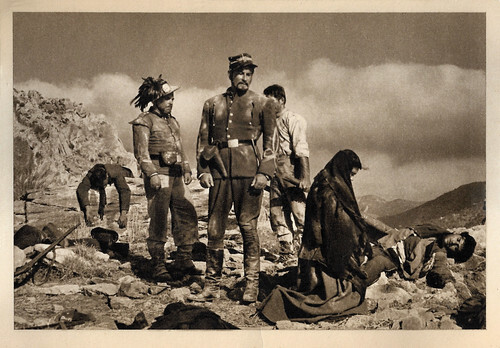
Italian postcard by Rotocalco Dagnino, Torino. Photo: LIF / Cines / Lux Film / Rovere Film. Amedeo Nazzari in Il Brigante di Tacca del Lupo/The Bandit of Tacca Del Lupo (Pietro Germi, 1952).
Italian heartthrob Amedeo Nazzari (1907-1979) was the athletic, fearless hero and impeccable gentleman of dozens of popular films during the late 1930s, 1940s and 1950s. Because of his reckless, adventure-seeking film characters, he was compared to Errol Flynn. He was the male star of Il Brigante di Tacca del Lupo/The Bandit of Tacca del Lupo (Pietro Germi, 1952). Nazzari played the captain of a small force of soldiers in 19th-century southern Italy (near Melfi, Basilicata). They fight in the hills against the bandits who hold their country to ransom.
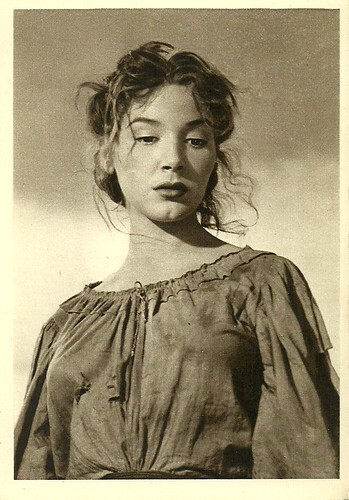
Italian postcard by Rotocalco Dagnino, Torino. Photo: LIF / Cines / Lux Film / Rovere Film. Cosetta Greco in Il Brigante di Tacca del Lupo/The Bandit of Tacca del Lupo (Pietro Germi, 1952), based on the novel by Riccardo Bacchelli. Publicity card for the Manzoni cinema, Turin, where the film ran from 21 November [1952] onwards.
Italian actress Cosetta Greco (1930-2002) appeared in 31 films between 1943 and 1971. She is famous for Germi's Il brigante di Tacca del Lupo (1952), but also for films like Le ragazze di piazza di Spagna/Three Girls from Rome (Luciano Emmer, 1952), Gli eroi della domenica/Sunday Heroes (Mario Camerini, 1953), and Cronache di poveri amanti/Chronicle of Poor Lovers (Carlo Lizzani, 1954).

Italian postcard by B.F.F. Edit., no. 2779. Photo: Minerva Films.
Handsome Erno Crisa (1914-1968) starred in Pietro Germi's drama Gelosia/Jealousy (1953). He played a Sicilian nobleman, jealous of his mistress, a farmhand's daughter. When she gets married to his lieutenant, he commits a murder of which an innocent man is accused. The guilty Marchese is tormented by his conscience and hears the dead man singing outside his villa. A moving and overwhelmingly impressive masterpiece, according to an IMDb reviewer.
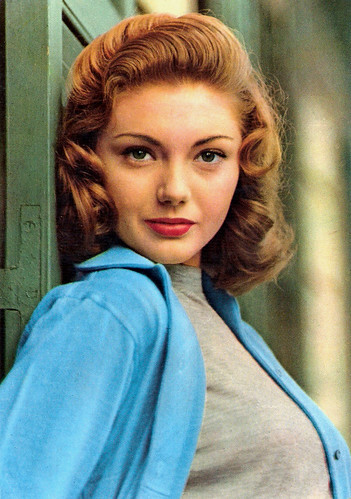
Italian postcard by Rotalcolor, no. 20.
Sylva Koscina (1933-1994) played Giulia the unmarried pregnant daughter of railroad engineer Andrea Marcocci (Pietro Germi) in the melodrama Il ferroviere/The Railroad Man (Pietro Germi, 1956). After a suicide crosses the tracks of his train in a curve, Andrea feels deeply affected by the accident and almost collides with another train. The railroad company investigates the accident and steps Andrea down from his position. At home, his aggressive behaviour causes Giulia and her older brother to leave home. Andrea starts to drink until the day his youngest son Sandrino visits him in a bar. Il ferroviere rises above the limitations of soap operas through the beauty of the characterisations and the quality of the performances. Most of the film is from the viewpoint of Andrea, but in an odd twist, 7-year-old Sandrino (Edoardo Nevola) sometimes narrates what is happening around him. Nevola's performance is awesome. Il ferroviere was a huge popular success and is considered one of the last masterpieces of Italian Neorealism.
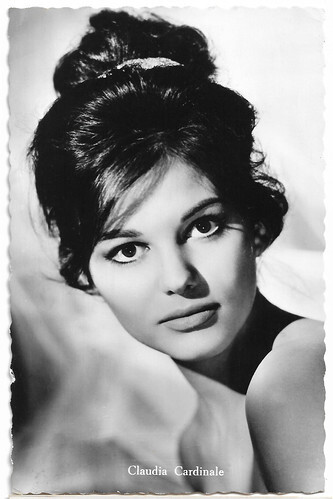
Dutch postcard.
Claudia Cardinale (1938) is one of Europe's iconic and most versatile film stars. At the start of her career, she co-starred with Pietro Germi in his well-constructed and highly entertaining police mystery Un maledetto imbroglio/The Facts of Murder (Pietro Germi, 1959). The plot, about a robbery in one apartment, and a murder in an apartment across the hall a week later, is as complex as a Raymond Chandler novel, with a similar denouement. It's richly detailed, with many interesting characters. Germi is a superb actor and his handling of other actors is sure. The pace is fast but not rushed, and the writing and the photography are richly nuanced.
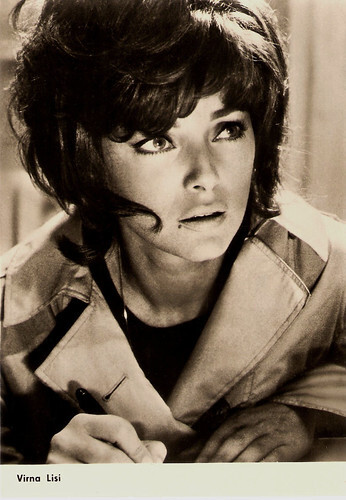
East-German postcard by VEB Progress Film-Vertrieb, Berlin, no. 2869. Retail price: 0,20 MDN.
Through the years, Pietro Germi shifted away from social drama towards satirical comedies but retained his beloved element of the Sicilian people. He received worldwide success with the black comedies Divorzio all'italiana/Divorce, Italian Style (1961), Sedotta e abbandonata/Seduced and Abandoned (1964), and Signore & signori/The Birds, the Bees and the Italians (1966). Virna Lisi (1936-2014) was the leading lady of Signore & signori (Pietro Germi, 1966). The film contains three stories, all set in fictional in small-town Rezega but filmed in Treviso. Various couples experience adultery at a party, a bank clerk abandons his wife for his mistress and all the men in the end are prosecuted for having intercourse with an underage girl. But "si fa ma non si dice" (everybody does it, nobody tells about it) is the law. This forgotten film is one of the best examples of the Commedia all’italiana and won the Palme d'Or at the Cannes Film Festival.
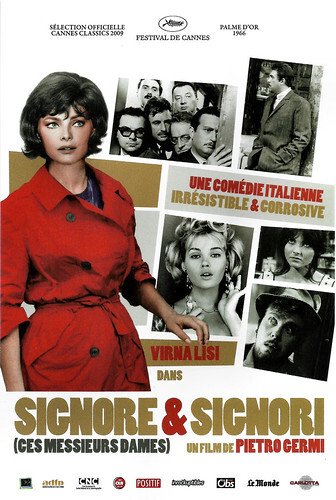
French postcard by Dark Star. Image: French poster for the 2009 re-issue of Signore & Signori (Pietro Germi, 1966) with Virna Lisi .
Sources: Il Cinema Ritrovato, Wikipedia (English and Italian) and .
Only decades after his death, Germi was finally and rightly recognised as one of Italian cinema’s greats. His pessimistic vision of human relations took shape through a highly original reworking of genres: from the Western like In nome della legge/In the Name of the Law (1949), the first film ever made about the mafia, to melodrama like Il ferroviere (1956), Film Noir like La città si difende (1951), detective mystery like Un maledetto imbroglio (1959) and black comedy like Divorzio all’italiana (1961). Germi never claimed to be an auteur and remained faithful to a vocation as a popular filmmaker. He consistently emphasised the perfectly written screenplay, the mise-en-scene, the film’s rhythm, and the direction of his actors. For this EFSP post, we chose twelve postcards of Germi's leading actors.

Small Czech collector card by Pressfoto, Praha (Prague), 1965, no. S 83/6. Stefania Sandrelli and Marcello Mastroianni in Divorzio all'italiana/Divorce, Italian Style (Pietro Germi, 1961).
In 1961, Pietro Gwermi stunned audiences and critics alike with his biting, satirical and grotesque comedy Divorzio all'italiana/Divorce, Italian Style (1961). Germi won the Oscar for Best Original Screenplay and earned a Best Director nomination at the 35th Academy Awards. Stefania Sandrelli (1946) was 15 years old when she had her breakthrough in this Commedia all’italiana. Her co-star, Marcello Mastroianni (1924-1996) almost singlehandedly defined the contemporary type of Latin lover, then proceeded to redefine it a dozen times and finally parodied it in films like Divorzio all'italiana and played it against type.

German postcard for Das Programm von Heute, Berlin, by Ross Verlag. Photo: Difu.
Elisa Cegani (1911–1996) was one of the most representative actresses of Italian cinema of the thirties and forties. She was the leading lady, a pianist in the comedy Retroscena/Backstage (Alessandro Blasetti, 1939) for which 25-year-old Pietro Germi co-wrote the screenplay. Germi studied at the Centro Sperimentale di Cinematografia in Rome and attended Blasetti's directing courses. Retroscena was a flop and Blasetti always considered it the worst film of his career.

Italian postcard by Bromofoto, Milano (Milan), no. 981. Photo: ENIC.
Italian actress Marina Berti (1924-2002) was a popular starlet in Italian films in the 1940s and early 1950s. She was the leading lady in the psychological thriller Il testimone/The Witness (1946), Pietro Germi's debut as a director. Already evident here is Germi's skill with actors. He puts Berti's sensitivity and delicate beauty to good use in the film as Linda, a newly-married woman whose husband Ernesto is showing increasingly irrational behaviour. Unbeknown to her he has a skeleton in the closet. Germi's early films were in the Neorealist style though a psychological thriller was quite unusual in the years of Neorealism. Many of his other films were social dramas dealing with contemporary issues of people of Sicilian heritage.

Italian postcard, no. 3. Photo: Lux Film. Carla del Poggio in Gioventù perduta/Lost Youth (Pietro Germi, 1948).
Italian actress Carla Del Poggio (1925-2010) was the female star of Federico Fellini’s bittersweet film debut Luci del varietà/Variety Lights (1950). In the 1940s and 1950s, she also starred in films by other famous directors such as Vittorio De Sica, her husband Alberto Lattuada, and Pietro Germi. The crime drama Gioventù perduta/Lost Youth (Pietro Germi, 1948) was Germi's second film. Del Poggio stars as the sister of a psychopath (Jacques Sernas) who leads students into crime. This crime film is also a study of how family and friends can be completely blind to a sociopathic killer in their midst.

Italian card. Photo: Lux Film.
Handsome, manly Italian actor Massimo Girotti (1918-2003) had a career that spanned seven decades. He starred in Luchino Visconti's Ossessione, Michelangelo Antonioni's Cronaca di un amore and Visconti's Senso. He also appeared in a few films by Pietro Germi. He plays in In nome della legge/In the Name of the Law (Pietro Germi, 1949) a young, by-the-book judge who is appointed to a Sicilian village controlled by corrupt leaders and the Mafia. Germi was obviously influenced by the Western: how the Mafia ride into town, shotguns at their backs, Carlo Rustichelli's English-horn-dominated music raising the blood, while the hero is about to stand off the gang of bandits. In nome della legge won three Silver Ribbons and was a box-office hit.

French postcard by Editions P.I., Paris, no. 14 E/384.
In the year after the international box office success of Riso Amaro/Bitter Rice (1949) propelled Raf Vallone (1916-2002) into international stardom, he starred as a desperate immigrant in Pietro Germi's Neorealist drama Il cammino della speranza/The Path of Hope (Pietro Germi, 1950). This powerful, monumental film was inspired by a novel by Nino di Maria and had a screenplay by Federico Fellini, Tullio Pinelli and Germi. Germi handled the burgeoning relationship between two Sicilian immigrants (Vallone and his wife Elena Varzi) beautifully and sensitively. The film was presented in competition at Cannes and won the Silver Bear and the Golden Bear at the Berlin Film Festival.

German postcard, no. 15. Sent by mail in the Netherlands in 1961. Collection: Geoffrey Donaldson Institute.
Gorgeous Gina Lollobrigida (1927-2023) was the leading lady of the interesting and effective Film Noir La città si difende/Four Ways Out (Pietro Germi, 1951). Germi followed the results of a big robbery in a different way. Instead of focusing on how the police try to track down the robbers, Germi concentrated on how the crime affects the lives of the thieves and their families. He brought the story alive with several nice cinematic touches, cross-cutting, solid character acting and a tense, emotional finale. Fellini, Pinelli and Germi wrote again the script, this time with the assistance of Giuseppe Mangione and Luigi Comencini. La città si difende was awarded Best Italian Film at the Venice Film Festival.

Italian postcard by Rotocalco Dagnino, Torino. Photo: LIF / Cines / Lux Film / Rovere Film. Amedeo Nazzari in Il Brigante di Tacca del Lupo/The Bandit of Tacca Del Lupo (Pietro Germi, 1952).
Italian heartthrob Amedeo Nazzari (1907-1979) was the athletic, fearless hero and impeccable gentleman of dozens of popular films during the late 1930s, 1940s and 1950s. Because of his reckless, adventure-seeking film characters, he was compared to Errol Flynn. He was the male star of Il Brigante di Tacca del Lupo/The Bandit of Tacca del Lupo (Pietro Germi, 1952). Nazzari played the captain of a small force of soldiers in 19th-century southern Italy (near Melfi, Basilicata). They fight in the hills against the bandits who hold their country to ransom.

Italian postcard by Rotocalco Dagnino, Torino. Photo: LIF / Cines / Lux Film / Rovere Film. Cosetta Greco in Il Brigante di Tacca del Lupo/The Bandit of Tacca del Lupo (Pietro Germi, 1952), based on the novel by Riccardo Bacchelli. Publicity card for the Manzoni cinema, Turin, where the film ran from 21 November [1952] onwards.
Italian actress Cosetta Greco (1930-2002) appeared in 31 films between 1943 and 1971. She is famous for Germi's Il brigante di Tacca del Lupo (1952), but also for films like Le ragazze di piazza di Spagna/Three Girls from Rome (Luciano Emmer, 1952), Gli eroi della domenica/Sunday Heroes (Mario Camerini, 1953), and Cronache di poveri amanti/Chronicle of Poor Lovers (Carlo Lizzani, 1954).

Italian postcard by B.F.F. Edit., no. 2779. Photo: Minerva Films.
Handsome Erno Crisa (1914-1968) starred in Pietro Germi's drama Gelosia/Jealousy (1953). He played a Sicilian nobleman, jealous of his mistress, a farmhand's daughter. When she gets married to his lieutenant, he commits a murder of which an innocent man is accused. The guilty Marchese is tormented by his conscience and hears the dead man singing outside his villa. A moving and overwhelmingly impressive masterpiece, according to an IMDb reviewer.

Italian postcard by Rotalcolor, no. 20.
Sylva Koscina (1933-1994) played Giulia the unmarried pregnant daughter of railroad engineer Andrea Marcocci (Pietro Germi) in the melodrama Il ferroviere/The Railroad Man (Pietro Germi, 1956). After a suicide crosses the tracks of his train in a curve, Andrea feels deeply affected by the accident and almost collides with another train. The railroad company investigates the accident and steps Andrea down from his position. At home, his aggressive behaviour causes Giulia and her older brother to leave home. Andrea starts to drink until the day his youngest son Sandrino visits him in a bar. Il ferroviere rises above the limitations of soap operas through the beauty of the characterisations and the quality of the performances. Most of the film is from the viewpoint of Andrea, but in an odd twist, 7-year-old Sandrino (Edoardo Nevola) sometimes narrates what is happening around him. Nevola's performance is awesome. Il ferroviere was a huge popular success and is considered one of the last masterpieces of Italian Neorealism.

Dutch postcard.
Claudia Cardinale (1938) is one of Europe's iconic and most versatile film stars. At the start of her career, she co-starred with Pietro Germi in his well-constructed and highly entertaining police mystery Un maledetto imbroglio/The Facts of Murder (Pietro Germi, 1959). The plot, about a robbery in one apartment, and a murder in an apartment across the hall a week later, is as complex as a Raymond Chandler novel, with a similar denouement. It's richly detailed, with many interesting characters. Germi is a superb actor and his handling of other actors is sure. The pace is fast but not rushed, and the writing and the photography are richly nuanced.

East-German postcard by VEB Progress Film-Vertrieb, Berlin, no. 2869. Retail price: 0,20 MDN.
Through the years, Pietro Germi shifted away from social drama towards satirical comedies but retained his beloved element of the Sicilian people. He received worldwide success with the black comedies Divorzio all'italiana/Divorce, Italian Style (1961), Sedotta e abbandonata/Seduced and Abandoned (1964), and Signore & signori/The Birds, the Bees and the Italians (1966). Virna Lisi (1936-2014) was the leading lady of Signore & signori (Pietro Germi, 1966). The film contains three stories, all set in fictional in small-town Rezega but filmed in Treviso. Various couples experience adultery at a party, a bank clerk abandons his wife for his mistress and all the men in the end are prosecuted for having intercourse with an underage girl. But "si fa ma non si dice" (everybody does it, nobody tells about it) is the law. This forgotten film is one of the best examples of the Commedia all’italiana and won the Palme d'Or at the Cannes Film Festival.

French postcard by Dark Star. Image: French poster for the 2009 re-issue of Signore & Signori (Pietro Germi, 1966) with Virna Lisi .
Sources: Il Cinema Ritrovato, Wikipedia (English and Italian) and .
Published on June 26, 2024 22:00
June 25, 2024
Gustaf Molander, the actresses' director
In a career lasting half a century, director Gustaf Molander (1888-1973) made more than 70 films in a variety of genres and styles and left a lasting imprint on Swedish film history. At Il Cinema Ritrovato 2024, Jon Wengström curated a programme on Molander. His Ingmarsarvet (1925) is the epilogue to the Golden Age of Swedish silent cinema. The programme also includes examples of his brilliance in drama, Film Noir and comedy from the sound era. Not just a versatile director excelling in different genres, Molander also had an extraordinary ability to bring forth the true potential in actors – in particular actresses. His films with the young Ingrid Bergman in the 1930s launched her to international stardom. We selected 16 postcards to illustrate the impressive career of Gustaf Molander.
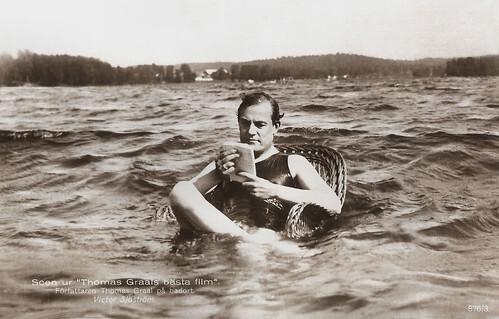
Swedish postcard by Ed. Nordisk Konst, Stockholm, no. 876/3. Photo: Svenska Biografteatern AB. Victor Sjöström in Thomas Graals bästa film/Thomas Graal's Best Film (Mauritz Stiller, 1917), scripted by Gustav Molander. The story deals with a screenwriter ( Victor Sjöström ) who falls in love with his secretary Bessie ( Karin Molander ) and imagines himself rescuing her from poverty. Reality is quite different as Bessie is a modern woman. The film also mocks the bored aristocracy involved in the modernity of filmmaking. Caption: The author Thomas Graal at sea.
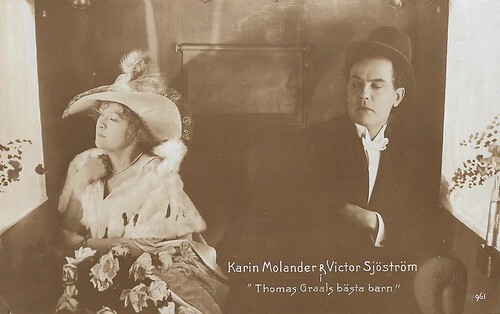
Swedish postcard by Förlag Nordisk Konst, Stockholm, no. 961. Photo: Svenska Biografteatern. Victor Sjöström and Karin Molander in the Swedish silent comedy Thomas Graals bästa barn/Thomas Graal's First Child (Mauritz Stiller, 1918), again scripted by Gustav Molander. In this sequel to Thomas Graals bästa film (1917), comedic situations follow Thomas and Bessie - beginning with the preparations of the wedding ceremony, to the daily married life. Molander wrote several screenplays for Victor Sjöström and Mauritz Stiller and was helped by the latter to get employment as a director for Svensk Filmindustri, where he worked from 1923 to 1956.
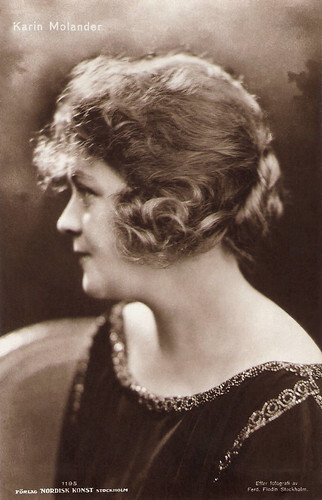
Swedish postcard by Förlag Nordisk Konst, Stockholm, no. 1195. Photo: Ferd. Flodin, Stockholm. Swedish actress Karin Molander (1889–1978) was a star of the silent Scandinavian cinema. From 1910-1918, she was married to Gustaf Molander and they had a son, director and producer Harald Molander. In the films of Mauritz Stiller , sometimes written by Gustaf, Karin became a symbol of the modern, young and emancipated women of the 1910s.
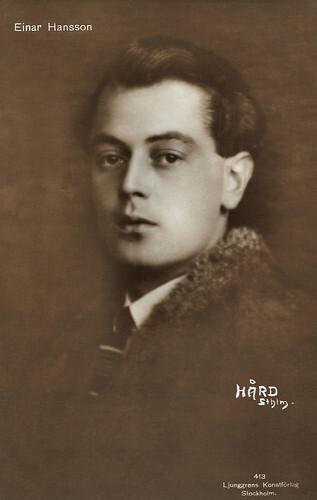
Swedish postcard by Ljunggrens Konstförlag, Stockholm, no. 413. Photo: Hard, Stockholm. Einar Hanson was the star of Gustaf Molander's fourth film as a director, the comedy Mälarpirater/Pirates of Lake Mälaren (Gustaf Molander, 1923) about three boys who steal a sailboat and sail away for a summer adventure on Lake Mälaren.
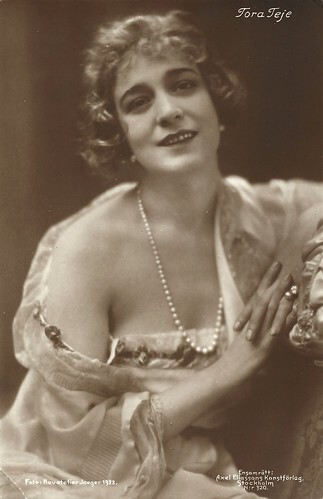
Swedish postcard by Axel Eliassons Konstförlag, Stockholm, no. 320. Photo: Hofatelier Jaeger, 1922. Tora Teje (1893-1970) was a Swedish actress who starred in the Swedish silent cinema of Mauritz Stiller and Victor Sjöström in the early 1920s. She also appeared in Gustaf Molander's fifth film, 33.333/33,333 (1924) about a shoemaker who wins the lottery but loses his ticket.
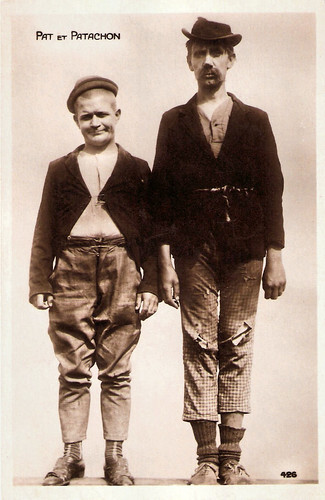
French postcard by Cinémagazine Edition, Paris, no. 426. The Danish double-act Fy og Bi (Fyrtårnet og Bivognen a.k.a. Pat & Patachon) was the most famous comedy couple of the European silent cinema. Long Carl Schenstrom and short Harald Madsen became very popular in the 1920s with their slapstick films. Gustaf Molander directed their Swedisch comedy Polis Paulus' påskasmäll/Constable Paulus' Easter Bomb (1925). It was Molander's sixth film as a director.
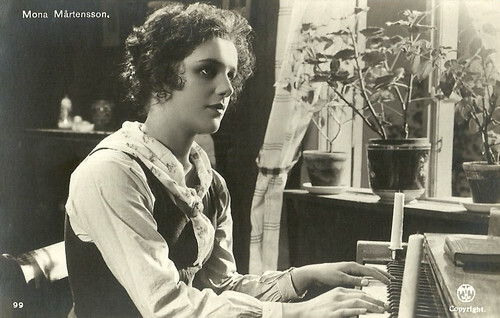
Danish postcard by Alex. Vincent's Kunstforlag, Copenhagen, no. 99. Mona Mårtenson in Ingmarsarvet/Ingmar's Inheritance (Gustav Molander, 1925), after Selma Lagerlöf's book 'Jerusalem'. Ingmarsarvet is the story of a group of farmers who choose to leave their homes and follow the preacher Helgum ( Conrad Veidt ) to the Holy Land. A few years earlier, Victor Sjöström had adapted Lagerlöf's novel into the films Ingmarssönerna/Sons of Ingmar (1919), depicting chapters one and two from the novel and Karin Ingmarsdotter/Karin, Daughter of Ingmar (1920), depicting chapters three and four from the novel. The critical reception of the film was, however, unenthusiastic, and Sjöström decided to not direct any more parts. Gustaf Molander finished the suite in 1926 with a fourth film.
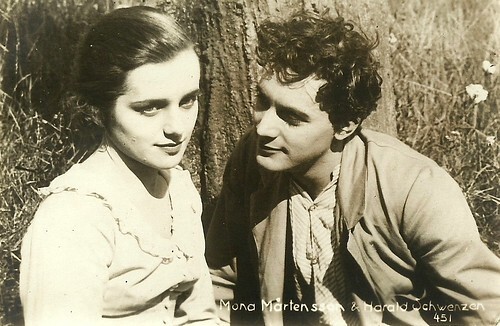
Danish postcard by Helsingin, Helsingfors, no. 451. Photo: Mona Mårtenson and Harald Schwenzen in Till österland/To the Orient (Gustav Molander, 1926). This was the last part in the 'Jerusalem' adaptations, directed as well as co-written by Gustaf Molander and starring Lars Hanson , Jenny Hasselqvist and Mona Mårtenson . The film was shot at the Råsunda Studios in Stockholm and on location in Jaffa and Jerusalem in Mandatory Palestine.
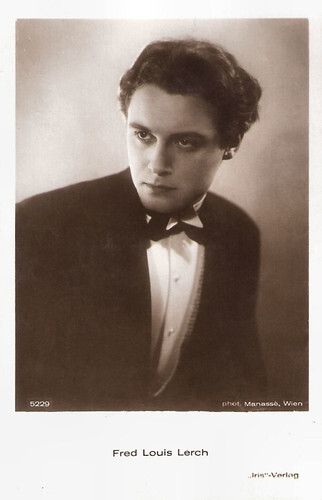
Austrian postcard by Iris Verlag, no. 5229. Photo: Manassé, Wien. Austrian actor Fred Louis Lerch (1902-1985) was a handsome star of the European silent cinema. He appeared opposite Mona Mårtenson in Gustaf Molander's Förseglade läppar/Sealed Lips (1927), based on a story by Guy de Maupassant. The drama was shot at the Råsunda Studios in Stockholm and on location at Lake Como and Feltre in Italy. Lerch also starred in Molander's next film Parisiskor/Women of Paris (Gustaf Molander, 1928) with Margit Manstad and Ruth Weyher . This was a coproduction with Ufa.
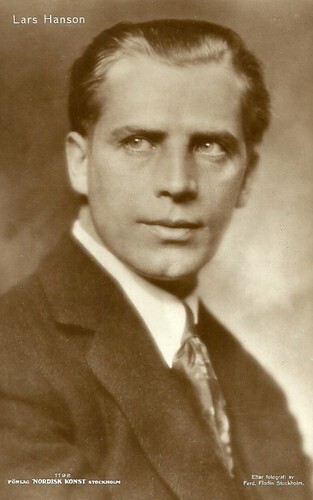
Swedish postcard by Förlag Nordisk Konst, Stockholm, no. 1192. Photo: Ferd. Flodin, Stockholm. Lars Hanson was the star of Synd/Sin (Gustaf Molander, 1928) based on a play by August Strindberg. Hanson played a married writer whose luck turns when he gets a play produced at Théâtre de Paris. He meets the femme fatale ( Gina Manès ) who should play the lead in his play. Passion and conflict occur. Synd/Sin was a co-production between Germany, Sweden and the United Kingdom.
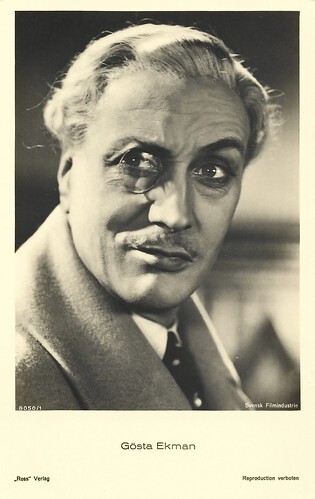
German postcard by Ross Verlag, Berlin, no. 8050/1, 1933-1934. Photo: Svensk Filmindustri(e). Gösta Ekman in Kära släkten/Dear Relatives (Gustaf Molander, 1933). During the sound era, Molander's films became very distinguished and recognisable. He often made sophisticated comedies in an upper-class environment with a touch of money and aristocracy, like Kära släkten/Dear Relatives. Molander also co-wrote the screenplay with Gösta Stevens. The film was a hit at the box office.
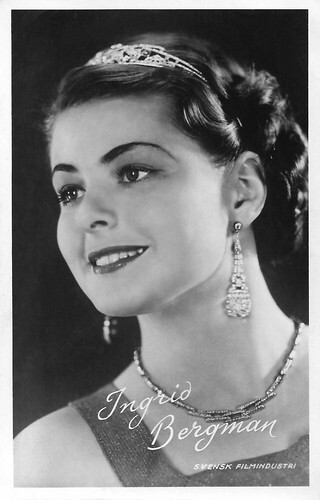
Dutch postcard by Takken / 't Sticht, Utrecht, no. 662. Photo: Svensk Filmindustri. Ingrid Bergman in Swedenhielms (Gustaf Molander, 1935). Gösta Ekman played the head of the Swedenhielm family, an old proud nobility family on the verge of bankruptcy. Ingrid Bergman played a supporting part in this film. In 1934, Bergman was offered a studio contract and placed under Gustaf Molander. In the following years, he made her a star.
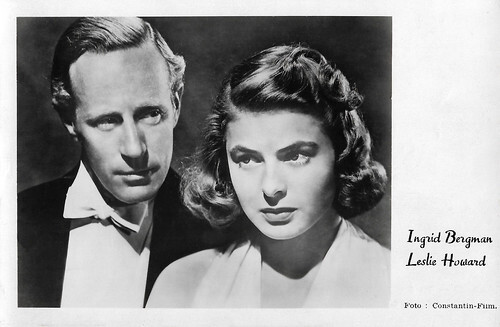
West German postcard by Schneider-Junior, Neunkirchen/Saar, no. 60. Photo: Constantin-Film. Ingrid Bergman and Leslie Howard in Intermezzo (Gregory Ratoff, 1939). in 1936, Ingrid Bergman appeared in Intermezzo (Gustaf Molander, 1936), her first lead performance, where she was reunited with Gösta Ekman . This was a pivotal film for the young actress and allowed her to demonstrate her talent. Director Molander later said: "I created Intermezzo for her, but I was not responsible for its success. Ingrid herself made it successful." This film led to Bergman gaining her contract with David O. Selznick and acting in a 1939 American remake opposite Leslie Howard .
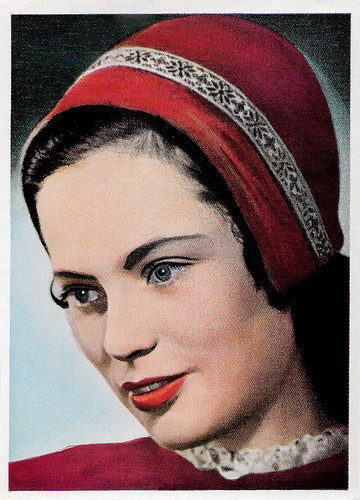
German collectors card in the 'Filmgrössen aus aller Welt" series II. Ulla Jacobsson in Herr Arnes penningar/Sir Arne's Treasure (Gustaf Molander, 1954). Molander based the film on Selma Lagerlöf's novel 'The Treasure' which had previously been filmed in 1919 by Mauritz Stiller . Molander had been the co-scriptwriter then.
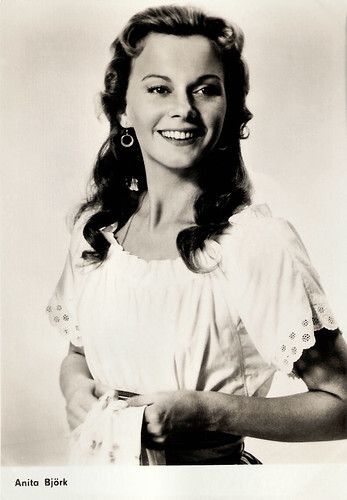
East-German postcard by VEB Progress Filmvertrieb, Berlin, no. 2.337, 1965. Anita Björk in Sången om den eldröda blomman/Song of the Scarlet Flower (Gustaf Molander, 1956)The film is one of several film adaptations of the 1905 novel 'The Song of the Blood-Red Flower' by Finnish author Johannes Linnankoski.
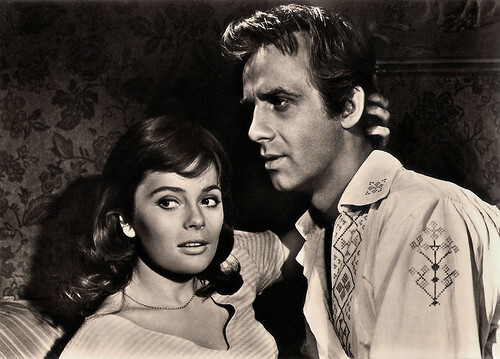
East-German postcard by VEB Progress Filmverlag, Berlin, no. 2.338, 1965. Photo: Ulla Jacobsson and Jarl Kulle in Sången om den eldröda blomman/Song of the Scarlet Flower (Gustaf Molander, 1956). It was one of Molander's last films. He was more or less forced to leave the production company Svensk Filmindustri (SF), whom he had been faithful to during his career when they wanted to get rid of everything old and tried. He continued to work for radio and television. In the 1960s he directed several stage productions at Vasateatern in Stockholm and for Riksteatern.
Sources: (IMDb), Wikipedia (Swedish and English) and .

Swedish postcard by Ed. Nordisk Konst, Stockholm, no. 876/3. Photo: Svenska Biografteatern AB. Victor Sjöström in Thomas Graals bästa film/Thomas Graal's Best Film (Mauritz Stiller, 1917), scripted by Gustav Molander. The story deals with a screenwriter ( Victor Sjöström ) who falls in love with his secretary Bessie ( Karin Molander ) and imagines himself rescuing her from poverty. Reality is quite different as Bessie is a modern woman. The film also mocks the bored aristocracy involved in the modernity of filmmaking. Caption: The author Thomas Graal at sea.

Swedish postcard by Förlag Nordisk Konst, Stockholm, no. 961. Photo: Svenska Biografteatern. Victor Sjöström and Karin Molander in the Swedish silent comedy Thomas Graals bästa barn/Thomas Graal's First Child (Mauritz Stiller, 1918), again scripted by Gustav Molander. In this sequel to Thomas Graals bästa film (1917), comedic situations follow Thomas and Bessie - beginning with the preparations of the wedding ceremony, to the daily married life. Molander wrote several screenplays for Victor Sjöström and Mauritz Stiller and was helped by the latter to get employment as a director for Svensk Filmindustri, where he worked from 1923 to 1956.

Swedish postcard by Förlag Nordisk Konst, Stockholm, no. 1195. Photo: Ferd. Flodin, Stockholm. Swedish actress Karin Molander (1889–1978) was a star of the silent Scandinavian cinema. From 1910-1918, she was married to Gustaf Molander and they had a son, director and producer Harald Molander. In the films of Mauritz Stiller , sometimes written by Gustaf, Karin became a symbol of the modern, young and emancipated women of the 1910s.

Swedish postcard by Ljunggrens Konstförlag, Stockholm, no. 413. Photo: Hard, Stockholm. Einar Hanson was the star of Gustaf Molander's fourth film as a director, the comedy Mälarpirater/Pirates of Lake Mälaren (Gustaf Molander, 1923) about three boys who steal a sailboat and sail away for a summer adventure on Lake Mälaren.

Swedish postcard by Axel Eliassons Konstförlag, Stockholm, no. 320. Photo: Hofatelier Jaeger, 1922. Tora Teje (1893-1970) was a Swedish actress who starred in the Swedish silent cinema of Mauritz Stiller and Victor Sjöström in the early 1920s. She also appeared in Gustaf Molander's fifth film, 33.333/33,333 (1924) about a shoemaker who wins the lottery but loses his ticket.

French postcard by Cinémagazine Edition, Paris, no. 426. The Danish double-act Fy og Bi (Fyrtårnet og Bivognen a.k.a. Pat & Patachon) was the most famous comedy couple of the European silent cinema. Long Carl Schenstrom and short Harald Madsen became very popular in the 1920s with their slapstick films. Gustaf Molander directed their Swedisch comedy Polis Paulus' påskasmäll/Constable Paulus' Easter Bomb (1925). It was Molander's sixth film as a director.

Danish postcard by Alex. Vincent's Kunstforlag, Copenhagen, no. 99. Mona Mårtenson in Ingmarsarvet/Ingmar's Inheritance (Gustav Molander, 1925), after Selma Lagerlöf's book 'Jerusalem'. Ingmarsarvet is the story of a group of farmers who choose to leave their homes and follow the preacher Helgum ( Conrad Veidt ) to the Holy Land. A few years earlier, Victor Sjöström had adapted Lagerlöf's novel into the films Ingmarssönerna/Sons of Ingmar (1919), depicting chapters one and two from the novel and Karin Ingmarsdotter/Karin, Daughter of Ingmar (1920), depicting chapters three and four from the novel. The critical reception of the film was, however, unenthusiastic, and Sjöström decided to not direct any more parts. Gustaf Molander finished the suite in 1926 with a fourth film.

Danish postcard by Helsingin, Helsingfors, no. 451. Photo: Mona Mårtenson and Harald Schwenzen in Till österland/To the Orient (Gustav Molander, 1926). This was the last part in the 'Jerusalem' adaptations, directed as well as co-written by Gustaf Molander and starring Lars Hanson , Jenny Hasselqvist and Mona Mårtenson . The film was shot at the Råsunda Studios in Stockholm and on location in Jaffa and Jerusalem in Mandatory Palestine.

Austrian postcard by Iris Verlag, no. 5229. Photo: Manassé, Wien. Austrian actor Fred Louis Lerch (1902-1985) was a handsome star of the European silent cinema. He appeared opposite Mona Mårtenson in Gustaf Molander's Förseglade läppar/Sealed Lips (1927), based on a story by Guy de Maupassant. The drama was shot at the Råsunda Studios in Stockholm and on location at Lake Como and Feltre in Italy. Lerch also starred in Molander's next film Parisiskor/Women of Paris (Gustaf Molander, 1928) with Margit Manstad and Ruth Weyher . This was a coproduction with Ufa.

Swedish postcard by Förlag Nordisk Konst, Stockholm, no. 1192. Photo: Ferd. Flodin, Stockholm. Lars Hanson was the star of Synd/Sin (Gustaf Molander, 1928) based on a play by August Strindberg. Hanson played a married writer whose luck turns when he gets a play produced at Théâtre de Paris. He meets the femme fatale ( Gina Manès ) who should play the lead in his play. Passion and conflict occur. Synd/Sin was a co-production between Germany, Sweden and the United Kingdom.

German postcard by Ross Verlag, Berlin, no. 8050/1, 1933-1934. Photo: Svensk Filmindustri(e). Gösta Ekman in Kära släkten/Dear Relatives (Gustaf Molander, 1933). During the sound era, Molander's films became very distinguished and recognisable. He often made sophisticated comedies in an upper-class environment with a touch of money and aristocracy, like Kära släkten/Dear Relatives. Molander also co-wrote the screenplay with Gösta Stevens. The film was a hit at the box office.

Dutch postcard by Takken / 't Sticht, Utrecht, no. 662. Photo: Svensk Filmindustri. Ingrid Bergman in Swedenhielms (Gustaf Molander, 1935). Gösta Ekman played the head of the Swedenhielm family, an old proud nobility family on the verge of bankruptcy. Ingrid Bergman played a supporting part in this film. In 1934, Bergman was offered a studio contract and placed under Gustaf Molander. In the following years, he made her a star.

West German postcard by Schneider-Junior, Neunkirchen/Saar, no. 60. Photo: Constantin-Film. Ingrid Bergman and Leslie Howard in Intermezzo (Gregory Ratoff, 1939). in 1936, Ingrid Bergman appeared in Intermezzo (Gustaf Molander, 1936), her first lead performance, where she was reunited with Gösta Ekman . This was a pivotal film for the young actress and allowed her to demonstrate her talent. Director Molander later said: "I created Intermezzo for her, but I was not responsible for its success. Ingrid herself made it successful." This film led to Bergman gaining her contract with David O. Selznick and acting in a 1939 American remake opposite Leslie Howard .

German collectors card in the 'Filmgrössen aus aller Welt" series II. Ulla Jacobsson in Herr Arnes penningar/Sir Arne's Treasure (Gustaf Molander, 1954). Molander based the film on Selma Lagerlöf's novel 'The Treasure' which had previously been filmed in 1919 by Mauritz Stiller . Molander had been the co-scriptwriter then.

East-German postcard by VEB Progress Filmvertrieb, Berlin, no. 2.337, 1965. Anita Björk in Sången om den eldröda blomman/Song of the Scarlet Flower (Gustaf Molander, 1956)The film is one of several film adaptations of the 1905 novel 'The Song of the Blood-Red Flower' by Finnish author Johannes Linnankoski.

East-German postcard by VEB Progress Filmverlag, Berlin, no. 2.338, 1965. Photo: Ulla Jacobsson and Jarl Kulle in Sången om den eldröda blomman/Song of the Scarlet Flower (Gustaf Molander, 1956). It was one of Molander's last films. He was more or less forced to leave the production company Svensk Filmindustri (SF), whom he had been faithful to during his career when they wanted to get rid of everything old and tried. He continued to work for radio and television. In the 1960s he directed several stage productions at Vasateatern in Stockholm and for Riksteatern.
Sources: (IMDb), Wikipedia (Swedish and English) and .
Published on June 25, 2024 22:00
June 24, 2024
Messalina
At Il Cinema Ritrovato 1924, a preview of a new restoration will be shown of Enrico Guazzoni's silent classic Messalina starring diva Rina De Liguoro. This spectacular epic premiered a hundred years ago and was an international success. Unfortunately, only a badly printed, sonorised version of the film was available for a long time. The notorious Roman Empress Messalina, the third wife of the Roman Emperor Claudius, has proved endlessly fascinating to writers, painters, sculptors and composers of both ballet and opera. She has been portrayed on screen from as early as 1910.
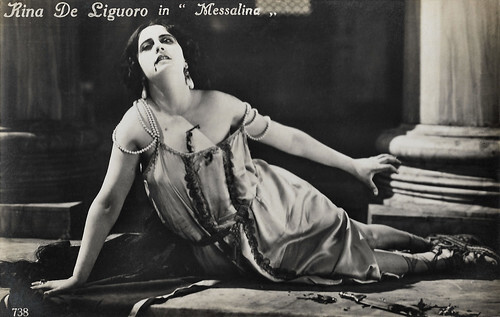
Italian postcard by Ed. A. Traldi, Milano, no. 738. Rina De Liguoro dies in the final scene of Messalina (Enrico Guazzoni 1924).
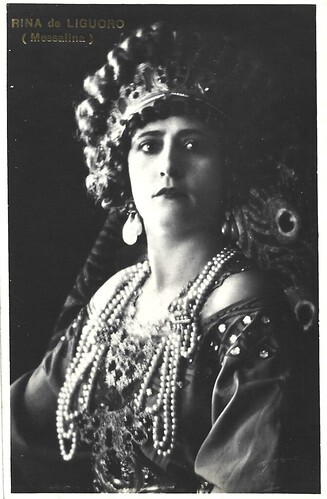
Italian postcard by Ed. Falci, La Fotominio, no. 385. Rina De Liguoro as the Roman empress Messalina in Messalina (Enrico Guazzoni, 1924).
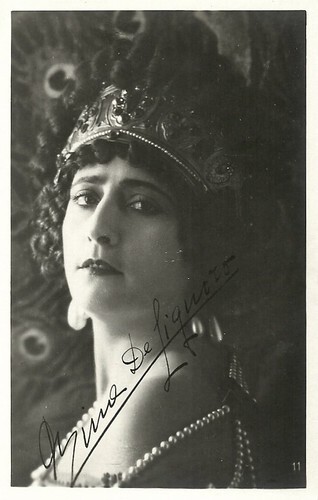
Italian postcard by B & G, B, no. 11. Signed by Rina De Liguoro. Rina De Liguoro is the title character in the epic film Messalina (Enrico Guazzoni, 1924).
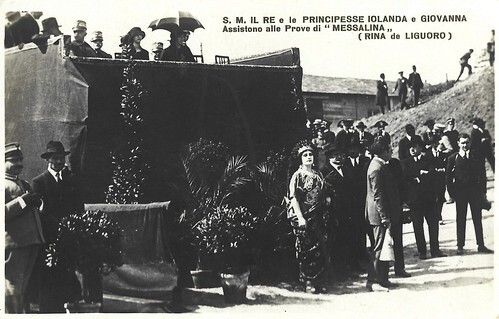
Italian postcard by Ed. Falci, La Fotominio. The Italian king Victor Emmanuel III and the princesses Jolanda and Giovanna visited the shooting in 1923 of the Italian silent epic Messalina (Enrico Guazzoni, 1924), starring (Countess) Rina De Liguoro .
Messalina (1924)
Claudius (Augusto Mastripietri) is acclaimed emperor after the murder of Caligula (Nello Carotenuto) by the praetorians, whose leader, Marcus, is in love with his wife, the immoral Messalina ( Rina De Liguoro ). She often leaves the imperial palace to roam the infamous areas in search of fleeting adventures and, during a raid, is rescued by Ennius (Gino Talamo), a Persian slave, with whom she falls in love.
She thus becomes the rival of Mirit ( Gianna Terribili Gonzales ), priestess of Isis, who blackmails the slave for her favours. Emperor Claudius, meanwhile, foils a plot to overthrow him hatched by Marcus and has him killed. To gain his freedom, Ennius participates in a quadriga race, but Mirit, annoyed by his refusal, arranges to poison the precious horses he is counting on for victory. Without the trained animals, Ennius topples over during the race and risks being killed by the gladiators, and it is Messalina who intervenes and brings him to safety.
Instead, Ennius loves Mirit's slave Egle (Lucia Zanussi), who is tortured by Mirit but at last saved by Ennius and his strongman friend Tigrane (Adolphe Trouché), who delivers Mirit to her own lions. The empress hatches a plot against her husband with the help of Caius Silvius. When this is discovered, Silvius is publicly humiliated and chased, while Messalina prefers to kill herself before being reduced in chains by the praetorians.
While Enrico Guazzoni shot Messalina in 1923, its Roman premiere took place in March 1924, while foreign premieres (Finland, Austria) already took place in January 1924. La rivista cinematografica (10-6-1924): "Excellent is the Countess Rina de Liguoro in the part of Messalina, a part so fit to her and cancelling the bad impression of her in a film some time ago of which we better don't speak anymore. For once the scissors of the censor have been mild towards the historical feats, so we can enjoy Messalina the corrupt, the depraved, the beautiful... we won't say more. Who hasn't gone yet, go and judge for yourself. Messalina is the triumph of the Italian cinematography, the pride of Enrico Guazzoni, and the Renaissance of our art."
Indeed, despite the decadence of Italian cinema in the early 1920s, Messalina was well-received in and outside of Italy. It was the only Italian silent film shown in the new Soviet Union. In the Anglosaxon world, the film was presented as The Fall of an Empress. Rina De Liguoro had her breakthrough as the sensual, untamed Roman empress. The beautiful countess continued her glittering career in such epics as Quo Vadis (1924), Casanova (1927) and Cecil B. De Mille 's notorious flop Madam Satan (1930).
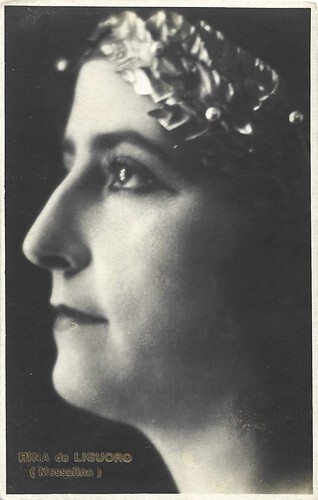
Italian postcard by Ed. Falci, La Fotominio, no. 386. Rina De Liguoro as the Roman empress Messalina in Messalina (Enrico Guazzoni, 1924).
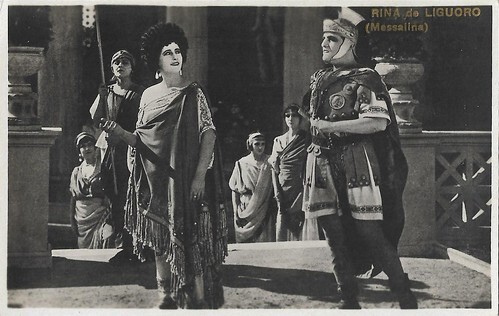
Italian postcard by Ed. A. Traldi, Milano, no. 738. Rina De Liguoro in Messalina (Enrico Guazzoni, 1924).
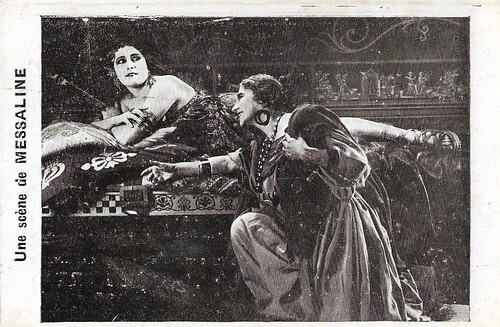
Belgian postcard by Anvers Palace. Photo: Rina De Liguoro in Messalina (Enrico Guazzoni, 1924).
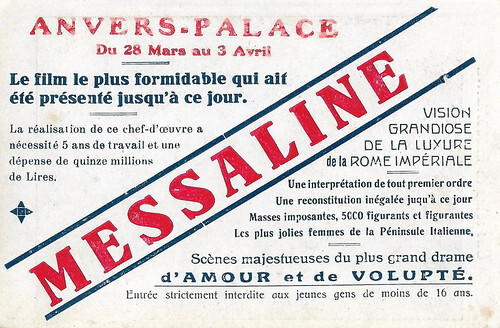
Belgian postcard (flip side). Publicity for the film Messalina (Enrico Guazzoni, 1924) at the Antwerp-based cinema Anvers-Palace.
The Opera Messaline (1899)
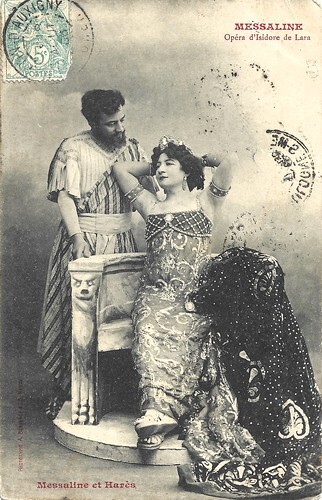
French postcard by A. Bergeret, Nancy. Caption: Messaline et Harès. Postcard mailed in 1906.
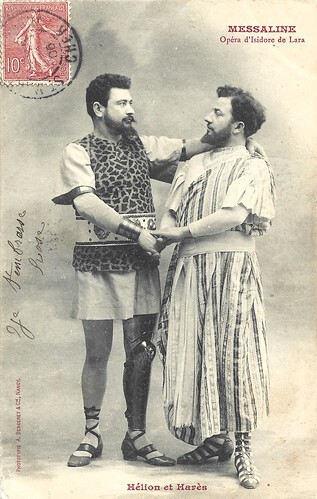
French postcard by A. Bergeret, Nancy. Caption: Hélion et Harès. Postcard mailed in 1906.
One of the earliest stage productions to feature the fall of the empress was 'The Tragedy of Messalina' (1639) by Nathanael Richards, where she is depicted as a monster. As well as plays, the story of Messalina was adapted to ballet and opera. The postcards above were made for the French opera 'Messaline' by Isidore de Lara, which premiered in 1899 in Monte Carlo. Yet, the A. Bergeret cards were for a production starring Belgian singer Jane Dasthy as Messalina. It was performed at least from late 1902 onward, e.g. at Montpellier, Nimes, Avignon, Ghent, Nantes, and Nice. Dhasty continued in later years with the opera in Lyon (1908) and Besançon (1909) but without the previous success.
In this opera, Empress Messalina is hated by all and many satirical songs about her circulate. Harès, one of the protest singers is brought to her, he is young and beautiful and so… Afterward, he is dumped by her and while looking for new adventures she meets in a tavern Helion, a sturdy gladiator, who saves her from the attacking mob. Harès witnesses this and realizes Messalina is about to start an affair with his own brother Helion. Later on, Hares discovers the love nest of Messalina and Helion. Quickly she hides Helion and her servants bound and gag Hares and throw him into the Tiber. Hares survives thanks to nearby boatmen but swears to kill the empress. Helion, who up till now didn’t realize his lover is the empress, goes to the imperial box at the circus to complain and discovers his beloved is the hated empress. She manages to seduce him again. Messalina warns him outside is a man who is waiting to kill her. He kills the intruder who storms in and of course, the other is his own brother. Out of his mind of grief, Helion jumps into the arena where the beasts will kill him.
The operatic tragédie lyrique 'Messaline' (Messalina) was composed by Isidore de Lara. The librettists were Paul Armand Silvestre and Eugène Morand. It premiered at the Opéra de Monte-Carlo on 21 March 1899 and was received enthusiastically. In the same year 'Messaline' was also performed at Covent Garden in London. 'Messaline' was de Lara's most successful opera. Subsequent productions were performed throughout Europe, including the first opera by an Englishman to be mounted at La Scala in Milan in 1901. According to the journal L'art dramatique et musical au XXe siècle, when in 1901 the opera was performed at the Scala for just one time, fans and acolytes of Arrigo Boito, whose Nerone was planned to be performed the year after (it would take several more years, until 1924 to be precise!), sensed competition and interrupted the performance with barking and growling. Nevertheless, the opera was a triumph and the author and singers were called back several times. Other notable performances of 'Messaline' took place at the Paris Opéra in 1903 (with Emma Calvé in the lead), in Warsaw in 1904, and in Cairo in 1907. The opera made its United States premiere at the Metropolitan Opera on 22 January 1902. The opera remained a regular part of the repertory, particularly in France, until 1943.
Jane Dhasty, singer from the Theatre de la Monnaie in Brussels, was announced to sing the role of Messaline for the first time on 21 January 1902 in Montpellier. Yet, it took till the end of the year to materialize. In late December 1902 Dhasty sang the lead in 'Messaline' at the Grand-Théâtre in Montpellier (so a year before the Paris premiere!). The local press was full of praise of the spectacle and considered the scenes with their voluptuous sumptuous sets in dark, bluish or purple tones worthy of the paintings by Georges-Antoine Rochegrosse. Yet, apart from Dasthy, there was little praise for the cast and the action seemed chaotic. Dhasty would also sing the part (probably all in 1903) in Nimes, Avignon, Ghent, Nice and Nantes.
Dasthy sang in Nantes the role from 12 December 1903, with Mézy as Hares and Abonil as Helion. The show in Nantes was an enormous success, according to the press. Sets were by M. Guillot, mise-en-scène by M. Viroux. A special festive evening was organised in early January 1904, also to celebrate Dasthy’s appointment to Officier de l’ordre, in which Lara thanked everybody. It is possible that the well-known postcard producer A. Bergeret from Nancy made a series of postcards on the opera with Dhasty after the success in Nantes. This could also mean Mezy and Abonil are visible on the postcards, next to Dasthy.
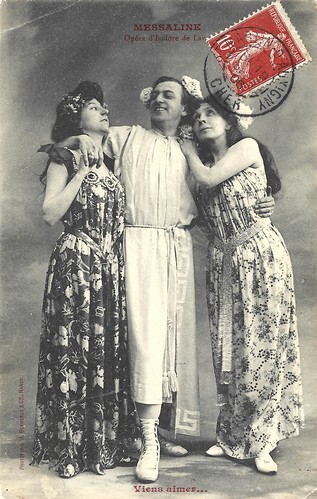
French postcard by A. Bergeret & Cie, Nancy. Caption: Viens aimer... Postcard mailed in 1906.
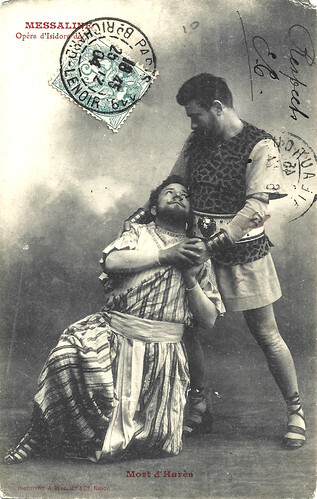
French postcard by A. Bergeret, Nancy. Caption: Mort de Harès. Postcard mailed in 1904.
Messaline (1910)
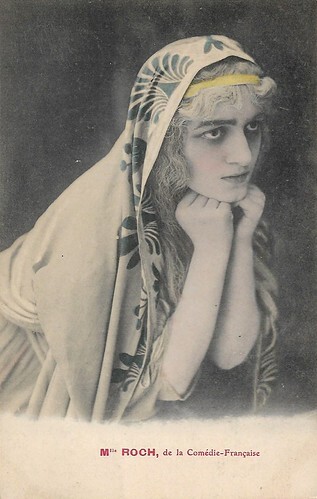
French postcard.
Madeleine Roch (1883–1930) was a reputed French 'tragédienne' from the Comédie-Française, who between 1909 and 1913 acted in a series of 11 Film d'Art-like historical films at Pathé Frères, including Messaline (Ferdinand Zecca, Henri Andréani, 1910). Roch entered the Comédie-Française in 1903 and was Sociétaire there between 1912 and 1930. She stopped film acting in 1912. In 1930 Roch gave her last stage performance and died in the same year.
In Messaline (Ferdinand Zecca, Henri Andréani, 1910), the empress (Madeleine Roch) leads a double life, secretly looking for pleasures in the city of Rome. She meets Manus (Louis Ravet), who is betrothed to Thysla ( Madeleine Céliat ) and is an honest Roman. When Manus rescues her from the mob, she falls in love with him. When he refuses her love, she has him arrested and imprisoned.
Thysla witnesses the arrest and finds out Messalina ordered it. During an orgy Messalina tries to seduce him, but fails. Narcissus and Vitellius warn Claudius (Jean Jacquinet) of the Empress' behaviour. Thysla implores Claudius to give her her bethrothed back. When Manus refuses Messalina a last time, she orders him to be strangled, but Claudius arrives just in time to reunite the couple, and orders the death of Messalina instead. In the US, the film was known as The Justice of Claudius.
Messalina (1951)
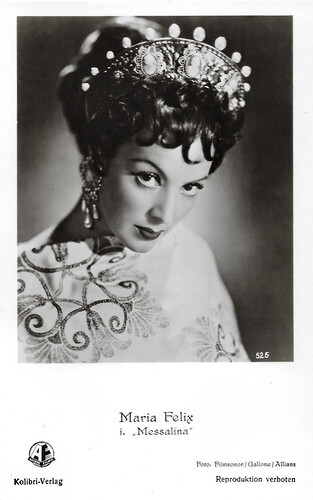
West German postcard by Kolibri-Verlag, no. 525. Photo: Filmsonor / Gallone / Allianz-Film. Maria Felix in Messalina/The Affairs of Messalina (Carmine Gallone, 1951).
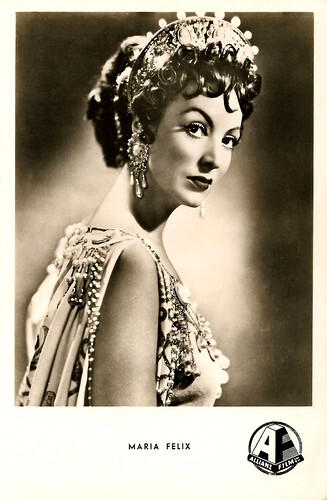
German postcard by Kunst und Bild, Berlin, no. A 405. Photo: Allianz Film. Maria Félix in Messalina (Carmine Gallone, 1951).
Energetic, fiery femme fatale María Félix (1914–2002) was an icon of the Golden Age of Mexican cinema. She was considered one of the most beautiful film actresses of her time, and one of the erotic myths of the Spanish-language cinema. She debuted in Italy with Incantesimo Tragico/Tragic Spell (Mario Sequi, 1951) opposite Rossano Brazzi. In the same year, she filmed Messalina (Carmine Gallone, 1951), with French actor Georges Marchal , Memo Benassi, Delia Scala and Erno Crisa .
At the time, Messalina (1951) was the most expensive film of the Italian cinema. It was a co-production between France, Italy and Spain. It was shot at the Cinecittà studios in Rome with sets designed by the art directors Gastone Medin and Vittorio Nino Novarese. It was part of a growing trend of epic historical films of the 1950s. The story of Messalina (1951) is again set in Rome in 44 A.D. and again concerns the amorous and political intrigues of the evil Messalina and her eventual hounding to death. Thirsty for power and pleasure, Messalina changes lovers as quickly as she eliminates her enemies, such as the proverbial Valerius. She even manages to convince the emperor Claudius, terrified by a false oracle, that to save him she must remarry her lover Caius Sylvius. But the plan with which she plans to seize the imperial throne will turn against her.
The reputation of Messalina, the third wife of Emperor Claudius, as being murderous and sexually rapacious is mainly based upon the histories of Suetonius and Tacitus while Juvenal in his sixth satire was also far from complimentary. Historians assume that some accounts were politically biased character assassinations in which historical facts were mixed with gossip. The historical figure and her fate were often used in the arts to make a moral point, but there was often as well a prurient fascination with her sexually liberated behaviour.
However, Maria Felix is perfect in the role. Messalina increased the international profile of the sensual, smouldering actress and probably paved the way for her French films including Jean Renoir 's classic French Cancan. Director Carmine Gallone is known for his notorious propaganda film Scipio Africanus (1937) which was made to justify Italy's invasion of Abyssinia. That film featured Camillo Pilotto as Hannibal and Memo Benassi as Cinna and both also appear in this film. Benassi, in particular, is excellent as Claudius. There is also very good support from the French actors Jean Chevrier as Valerius, Germaine Kerjean as the 'witch' and Jean Tissier , suitably flamboyant as Mnester.
Messalina (1951) is beautifully shot by Anchise Brizzi and the excellent, understated score is by Renzo Rossellini. Brog Miller at IMDb : "The gladiatorial combats are generally well handled and the obligatory one-sided 'Christians versus Lions' contest has an unusual twist, to say the least. Historically inaccurate to be sure but extremely watchable. Maria is mean, moody and magnificent".
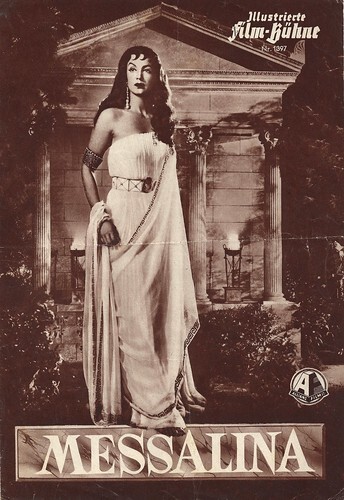
German film brochure by Illustrierte Film-Bühne, no. 1397. Maria Félix in Messalina (Carmine Gallone, 1951).
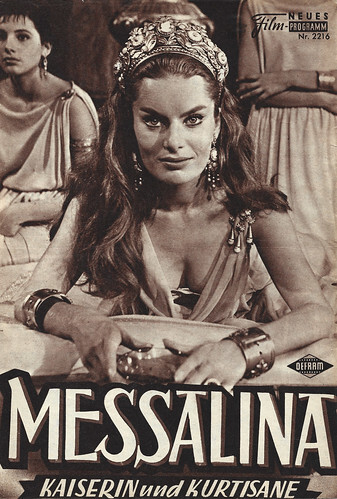
Austrian film brochure by Neues Filmprogramm, no. 2216. Photo: Oefram / Emo-Bistolfi. Belinda Lee as the notorious Roman Empress Messalina in Messalina Venere Imperatrice (Vittorio Cottafavi, 1960). The German distribution title by Oefram-Film was Messalina Kaiserin und Kurtisane.
Sources: Brog Miller (IMDb), Gallica, Wikipedia (French and English) and IMDb.

Italian postcard by Ed. A. Traldi, Milano, no. 738. Rina De Liguoro dies in the final scene of Messalina (Enrico Guazzoni 1924).

Italian postcard by Ed. Falci, La Fotominio, no. 385. Rina De Liguoro as the Roman empress Messalina in Messalina (Enrico Guazzoni, 1924).

Italian postcard by B & G, B, no. 11. Signed by Rina De Liguoro. Rina De Liguoro is the title character in the epic film Messalina (Enrico Guazzoni, 1924).

Italian postcard by Ed. Falci, La Fotominio. The Italian king Victor Emmanuel III and the princesses Jolanda and Giovanna visited the shooting in 1923 of the Italian silent epic Messalina (Enrico Guazzoni, 1924), starring (Countess) Rina De Liguoro .
Messalina (1924)
Claudius (Augusto Mastripietri) is acclaimed emperor after the murder of Caligula (Nello Carotenuto) by the praetorians, whose leader, Marcus, is in love with his wife, the immoral Messalina ( Rina De Liguoro ). She often leaves the imperial palace to roam the infamous areas in search of fleeting adventures and, during a raid, is rescued by Ennius (Gino Talamo), a Persian slave, with whom she falls in love.
She thus becomes the rival of Mirit ( Gianna Terribili Gonzales ), priestess of Isis, who blackmails the slave for her favours. Emperor Claudius, meanwhile, foils a plot to overthrow him hatched by Marcus and has him killed. To gain his freedom, Ennius participates in a quadriga race, but Mirit, annoyed by his refusal, arranges to poison the precious horses he is counting on for victory. Without the trained animals, Ennius topples over during the race and risks being killed by the gladiators, and it is Messalina who intervenes and brings him to safety.
Instead, Ennius loves Mirit's slave Egle (Lucia Zanussi), who is tortured by Mirit but at last saved by Ennius and his strongman friend Tigrane (Adolphe Trouché), who delivers Mirit to her own lions. The empress hatches a plot against her husband with the help of Caius Silvius. When this is discovered, Silvius is publicly humiliated and chased, while Messalina prefers to kill herself before being reduced in chains by the praetorians.
While Enrico Guazzoni shot Messalina in 1923, its Roman premiere took place in March 1924, while foreign premieres (Finland, Austria) already took place in January 1924. La rivista cinematografica (10-6-1924): "Excellent is the Countess Rina de Liguoro in the part of Messalina, a part so fit to her and cancelling the bad impression of her in a film some time ago of which we better don't speak anymore. For once the scissors of the censor have been mild towards the historical feats, so we can enjoy Messalina the corrupt, the depraved, the beautiful... we won't say more. Who hasn't gone yet, go and judge for yourself. Messalina is the triumph of the Italian cinematography, the pride of Enrico Guazzoni, and the Renaissance of our art."
Indeed, despite the decadence of Italian cinema in the early 1920s, Messalina was well-received in and outside of Italy. It was the only Italian silent film shown in the new Soviet Union. In the Anglosaxon world, the film was presented as The Fall of an Empress. Rina De Liguoro had her breakthrough as the sensual, untamed Roman empress. The beautiful countess continued her glittering career in such epics as Quo Vadis (1924), Casanova (1927) and Cecil B. De Mille 's notorious flop Madam Satan (1930).

Italian postcard by Ed. Falci, La Fotominio, no. 386. Rina De Liguoro as the Roman empress Messalina in Messalina (Enrico Guazzoni, 1924).

Italian postcard by Ed. A. Traldi, Milano, no. 738. Rina De Liguoro in Messalina (Enrico Guazzoni, 1924).

Belgian postcard by Anvers Palace. Photo: Rina De Liguoro in Messalina (Enrico Guazzoni, 1924).

Belgian postcard (flip side). Publicity for the film Messalina (Enrico Guazzoni, 1924) at the Antwerp-based cinema Anvers-Palace.
The Opera Messaline (1899)

French postcard by A. Bergeret, Nancy. Caption: Messaline et Harès. Postcard mailed in 1906.

French postcard by A. Bergeret, Nancy. Caption: Hélion et Harès. Postcard mailed in 1906.
One of the earliest stage productions to feature the fall of the empress was 'The Tragedy of Messalina' (1639) by Nathanael Richards, where she is depicted as a monster. As well as plays, the story of Messalina was adapted to ballet and opera. The postcards above were made for the French opera 'Messaline' by Isidore de Lara, which premiered in 1899 in Monte Carlo. Yet, the A. Bergeret cards were for a production starring Belgian singer Jane Dasthy as Messalina. It was performed at least from late 1902 onward, e.g. at Montpellier, Nimes, Avignon, Ghent, Nantes, and Nice. Dhasty continued in later years with the opera in Lyon (1908) and Besançon (1909) but without the previous success.
In this opera, Empress Messalina is hated by all and many satirical songs about her circulate. Harès, one of the protest singers is brought to her, he is young and beautiful and so… Afterward, he is dumped by her and while looking for new adventures she meets in a tavern Helion, a sturdy gladiator, who saves her from the attacking mob. Harès witnesses this and realizes Messalina is about to start an affair with his own brother Helion. Later on, Hares discovers the love nest of Messalina and Helion. Quickly she hides Helion and her servants bound and gag Hares and throw him into the Tiber. Hares survives thanks to nearby boatmen but swears to kill the empress. Helion, who up till now didn’t realize his lover is the empress, goes to the imperial box at the circus to complain and discovers his beloved is the hated empress. She manages to seduce him again. Messalina warns him outside is a man who is waiting to kill her. He kills the intruder who storms in and of course, the other is his own brother. Out of his mind of grief, Helion jumps into the arena where the beasts will kill him.
The operatic tragédie lyrique 'Messaline' (Messalina) was composed by Isidore de Lara. The librettists were Paul Armand Silvestre and Eugène Morand. It premiered at the Opéra de Monte-Carlo on 21 March 1899 and was received enthusiastically. In the same year 'Messaline' was also performed at Covent Garden in London. 'Messaline' was de Lara's most successful opera. Subsequent productions were performed throughout Europe, including the first opera by an Englishman to be mounted at La Scala in Milan in 1901. According to the journal L'art dramatique et musical au XXe siècle, when in 1901 the opera was performed at the Scala for just one time, fans and acolytes of Arrigo Boito, whose Nerone was planned to be performed the year after (it would take several more years, until 1924 to be precise!), sensed competition and interrupted the performance with barking and growling. Nevertheless, the opera was a triumph and the author and singers were called back several times. Other notable performances of 'Messaline' took place at the Paris Opéra in 1903 (with Emma Calvé in the lead), in Warsaw in 1904, and in Cairo in 1907. The opera made its United States premiere at the Metropolitan Opera on 22 January 1902. The opera remained a regular part of the repertory, particularly in France, until 1943.
Jane Dhasty, singer from the Theatre de la Monnaie in Brussels, was announced to sing the role of Messaline for the first time on 21 January 1902 in Montpellier. Yet, it took till the end of the year to materialize. In late December 1902 Dhasty sang the lead in 'Messaline' at the Grand-Théâtre in Montpellier (so a year before the Paris premiere!). The local press was full of praise of the spectacle and considered the scenes with their voluptuous sumptuous sets in dark, bluish or purple tones worthy of the paintings by Georges-Antoine Rochegrosse. Yet, apart from Dasthy, there was little praise for the cast and the action seemed chaotic. Dhasty would also sing the part (probably all in 1903) in Nimes, Avignon, Ghent, Nice and Nantes.
Dasthy sang in Nantes the role from 12 December 1903, with Mézy as Hares and Abonil as Helion. The show in Nantes was an enormous success, according to the press. Sets were by M. Guillot, mise-en-scène by M. Viroux. A special festive evening was organised in early January 1904, also to celebrate Dasthy’s appointment to Officier de l’ordre, in which Lara thanked everybody. It is possible that the well-known postcard producer A. Bergeret from Nancy made a series of postcards on the opera with Dhasty after the success in Nantes. This could also mean Mezy and Abonil are visible on the postcards, next to Dasthy.

French postcard by A. Bergeret & Cie, Nancy. Caption: Viens aimer... Postcard mailed in 1906.

French postcard by A. Bergeret, Nancy. Caption: Mort de Harès. Postcard mailed in 1904.
Messaline (1910)

French postcard.
Madeleine Roch (1883–1930) was a reputed French 'tragédienne' from the Comédie-Française, who between 1909 and 1913 acted in a series of 11 Film d'Art-like historical films at Pathé Frères, including Messaline (Ferdinand Zecca, Henri Andréani, 1910). Roch entered the Comédie-Française in 1903 and was Sociétaire there between 1912 and 1930. She stopped film acting in 1912. In 1930 Roch gave her last stage performance and died in the same year.
In Messaline (Ferdinand Zecca, Henri Andréani, 1910), the empress (Madeleine Roch) leads a double life, secretly looking for pleasures in the city of Rome. She meets Manus (Louis Ravet), who is betrothed to Thysla ( Madeleine Céliat ) and is an honest Roman. When Manus rescues her from the mob, she falls in love with him. When he refuses her love, she has him arrested and imprisoned.
Thysla witnesses the arrest and finds out Messalina ordered it. During an orgy Messalina tries to seduce him, but fails. Narcissus and Vitellius warn Claudius (Jean Jacquinet) of the Empress' behaviour. Thysla implores Claudius to give her her bethrothed back. When Manus refuses Messalina a last time, she orders him to be strangled, but Claudius arrives just in time to reunite the couple, and orders the death of Messalina instead. In the US, the film was known as The Justice of Claudius.
Messalina (1951)

West German postcard by Kolibri-Verlag, no. 525. Photo: Filmsonor / Gallone / Allianz-Film. Maria Felix in Messalina/The Affairs of Messalina (Carmine Gallone, 1951).

German postcard by Kunst und Bild, Berlin, no. A 405. Photo: Allianz Film. Maria Félix in Messalina (Carmine Gallone, 1951).
Energetic, fiery femme fatale María Félix (1914–2002) was an icon of the Golden Age of Mexican cinema. She was considered one of the most beautiful film actresses of her time, and one of the erotic myths of the Spanish-language cinema. She debuted in Italy with Incantesimo Tragico/Tragic Spell (Mario Sequi, 1951) opposite Rossano Brazzi. In the same year, she filmed Messalina (Carmine Gallone, 1951), with French actor Georges Marchal , Memo Benassi, Delia Scala and Erno Crisa .
At the time, Messalina (1951) was the most expensive film of the Italian cinema. It was a co-production between France, Italy and Spain. It was shot at the Cinecittà studios in Rome with sets designed by the art directors Gastone Medin and Vittorio Nino Novarese. It was part of a growing trend of epic historical films of the 1950s. The story of Messalina (1951) is again set in Rome in 44 A.D. and again concerns the amorous and political intrigues of the evil Messalina and her eventual hounding to death. Thirsty for power and pleasure, Messalina changes lovers as quickly as she eliminates her enemies, such as the proverbial Valerius. She even manages to convince the emperor Claudius, terrified by a false oracle, that to save him she must remarry her lover Caius Sylvius. But the plan with which she plans to seize the imperial throne will turn against her.
The reputation of Messalina, the third wife of Emperor Claudius, as being murderous and sexually rapacious is mainly based upon the histories of Suetonius and Tacitus while Juvenal in his sixth satire was also far from complimentary. Historians assume that some accounts were politically biased character assassinations in which historical facts were mixed with gossip. The historical figure and her fate were often used in the arts to make a moral point, but there was often as well a prurient fascination with her sexually liberated behaviour.
However, Maria Felix is perfect in the role. Messalina increased the international profile of the sensual, smouldering actress and probably paved the way for her French films including Jean Renoir 's classic French Cancan. Director Carmine Gallone is known for his notorious propaganda film Scipio Africanus (1937) which was made to justify Italy's invasion of Abyssinia. That film featured Camillo Pilotto as Hannibal and Memo Benassi as Cinna and both also appear in this film. Benassi, in particular, is excellent as Claudius. There is also very good support from the French actors Jean Chevrier as Valerius, Germaine Kerjean as the 'witch' and Jean Tissier , suitably flamboyant as Mnester.
Messalina (1951) is beautifully shot by Anchise Brizzi and the excellent, understated score is by Renzo Rossellini. Brog Miller at IMDb : "The gladiatorial combats are generally well handled and the obligatory one-sided 'Christians versus Lions' contest has an unusual twist, to say the least. Historically inaccurate to be sure but extremely watchable. Maria is mean, moody and magnificent".

German film brochure by Illustrierte Film-Bühne, no. 1397. Maria Félix in Messalina (Carmine Gallone, 1951).

Austrian film brochure by Neues Filmprogramm, no. 2216. Photo: Oefram / Emo-Bistolfi. Belinda Lee as the notorious Roman Empress Messalina in Messalina Venere Imperatrice (Vittorio Cottafavi, 1960). The German distribution title by Oefram-Film was Messalina Kaiserin und Kurtisane.
Sources: Brog Miller (IMDb), Gallica, Wikipedia (French and English) and IMDb.
Published on June 24, 2024 22:00
June 23, 2024
Journeys into the night: the world of Anatole Litvak
Il Cinema Ritrovato 2024 hails Anatole Litvak (1902-1974) as 'an unjustly overlooked master with an international career spanning six decades'. Litvak made 'some of the most riveting and innovative films in the history of cinema that, save for a few titles, are hardly seen or discussed today. The Kyiv-born director made films in Germany, France, the UK and eventually Hollywood.' Curator Ehsan Khoshbakht programmed an overview of Litvak's career features films with 'sweeping camera movements, long takes, ironic cutting, and splendid use of décor'. His films 'dive into a nocturnal world of flawed and unstable men and women whose identity crisis for Litvak reflects the crisis of the world between the Russian Revolution and the Second World War – a time of awakening and political turmoil that Litvak experienced first-hand'. For this post, we chose postcards from his masterpieces such as L’équipage and of his lesser-known works.
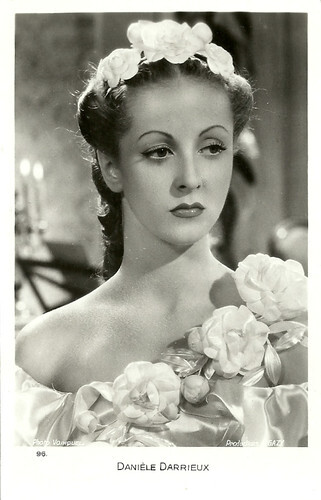
French postcard. Photo: Raymond Voinquel / Production Gazy. Danielle Darrieux as Marie Vetsera in Mayerling (Anatole Litvak, 1936).
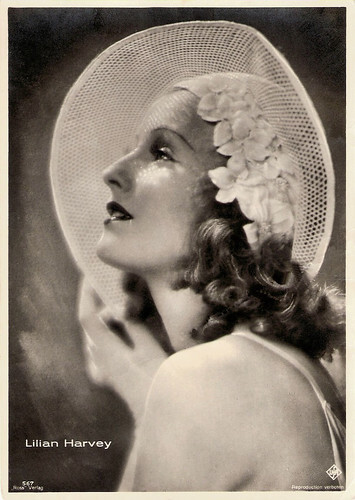
German postcard by Ross Verlag, no. 567. Photo: Ufa. Lilian Harvey in Nie wieder Liebe! (Anatole Litvak, 1931).
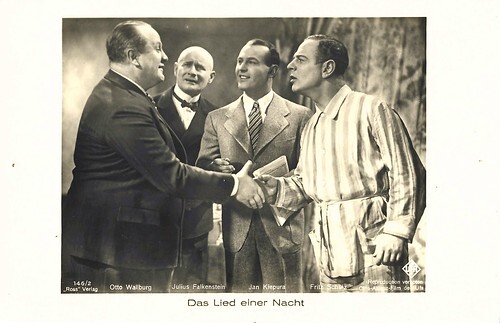
German postcard by Ross Verlag, no. 146/2. Photo: Cine-Allianz-Film der Ufa. Otto Wallburg , Julius Falkenstein , Jan Kiepura and Fritz Schulz in Das Lied einer Nacht/The Song of Night (Anatole Litvak, 1932).
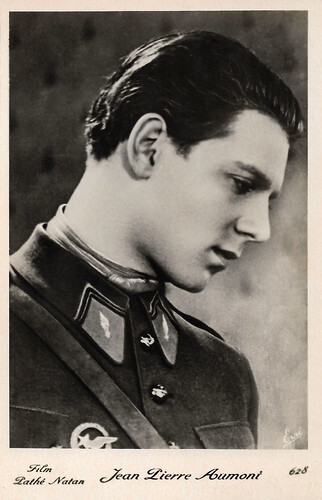
French postcard by Erpé, no. 628. Photo: Film Pathé Natan. Jean-Pierre Aumont in L'équipage/Flight Into Darkness (Anatole Litvak, 1935).
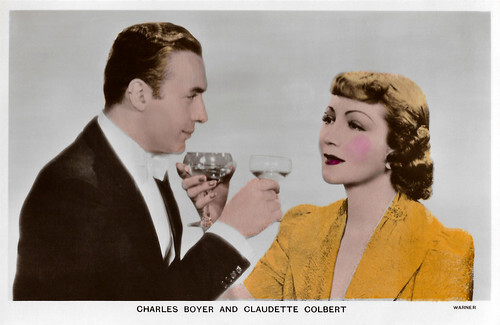
British postcard in the Film Partners Series, London, no. PC 251. Photo: Warner. Charles Boyer and Claudette Colbert in Tovarich (Anatole Litvak, 1937).
Witness of the 1917 Russian Revolution
Anatoly Mikhailovich Litvak was born in 1902 in the city of Kyiv in the Russian Empire (now Ukraine). He was the son of Lithuanian Jewish parents. "Litvak" means "Lithuanian" in Yiddish.
The family moved to St. Petersburg, the capital of the Russian Empire. In 1915, Antatoly began to work at a little-known experimental theatre.
As a teenager, he witnessed the 1917 Russian Revolution and the consequent nationalisation of all theatres and drama schools.
In St. Petersburg, he studied philosophy at the university but in 1921 he began to train as an actor and theatre director in the same city. In 1923, he started working as a set decorator and assistant director for Nordkino Studios in Leningrad (the Soviet name for St. Petersburg).
Litvak worked his way up to directing short features, notably Tatiana (Anatole Litvak, 1925), a film about children.
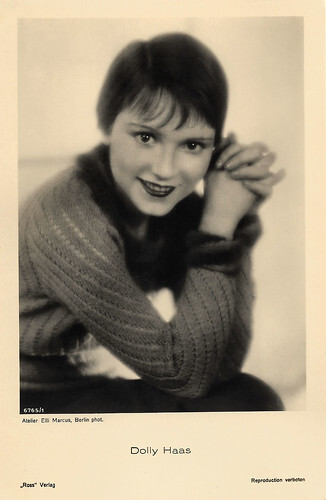
German postcard by Ross Verlag, no. 6765/1, 1931-1932. Photo: Atelier Elli Marcus, Berlin. Dolly Haas in Dolly macht Karriere/Dolly's Way to Stardom (Anatole Litvak, 1930).
Litvak's first European feature, Dolly macht Karriere/Dolly's Way to Stardom, was a musical vehicle for up-and-coming Dolly Haas . She plays a would-be actress with a would-be composer boyfriend. At one point, she sings that she has the walk of Lilian Harvey , the mouth of Greta Garbo and the legs of Marlene Dietrich .
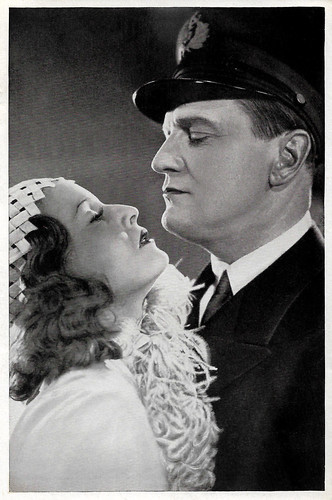
German collectors card in the series 'Vom Werden deutscher Filmkunst - Der Tonfilm', album no. 11, picture no. 61. Photo: Ufa / Ross Verlag. Lilian Harvey and Harry Liedtke in Nie wieder Liebe!/No More Love (Anatole Litvak, 1931).
Harry Liedtke in Nie wieder Liebe!/No More Love is an American millionaire, who always has bad luck with women. He bets that he can live without them for five years. But after four and a half years travelling around on his yacht, he rescues a lady, Lilian Harvey , in her one piece and bathing cap, from the English Channel. Litvak's undistinguished second European feature comes in a couple of languages and uses montage and moving camera to try to disguise the thinness of its script. However, Harvey - at the peak of her career, makes a lively impression.
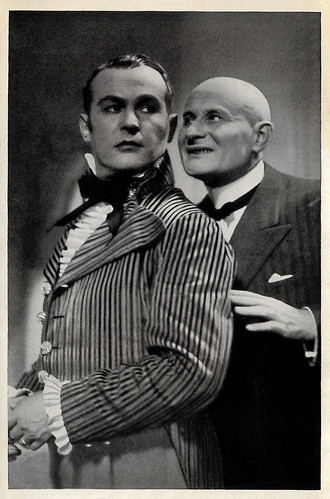
German collectors card in the series 'Vom Werden deutscher Filmkunst - Der Tonfilm', album no. 11, picture no. 32. Photo: Cine-Allianz / Ross Verlag. Jan Kiepura and Julius Falkenstein in Das Lied einer Nacht/The Song of Night (Anatole Litvak, 1932).
In Das Lied einer Nacht/The Song of Night, Opera star Enrico Ferraro (Polish tenor Jan Kiepura ), tired of his stressful schedule, changes trains for a Swiss vacation. When his presence is discovered at the peaceful lakeside resort, he changes places with a new friend ( Fritz Schulz ) pretending he is his secretary. Free at last he explores the country and meets a beautiful girl (Magda Schneider). In this German musical, Litvak is already tracking, panning and quick cutting to push up the pace of his work. He also directed a now-lost English version, Tell Me Tonight (1932), and a French version, La chanson d'une nuit (1932), both also with Kiepura.
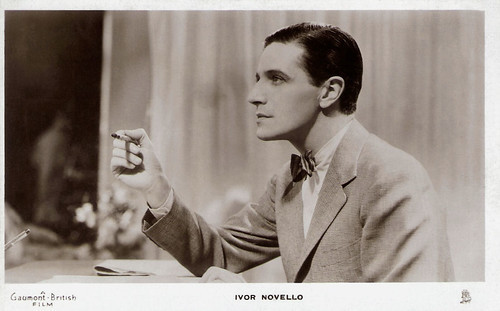
British postcard by Raphael Tuck & Sons, London, no. 50-S. Photo: Gaumont-British. Ivor Novello in Love and Let Love/Sleeping Car (Anatole Litvak, 1933).
In the charming romantic comedy Love and Let Love/Sleeping Car, Ivor Novello plays a French sleeping car attendant with a girl at every stop of the Orient Express. He hooks up with a wealthy widow ( Madeleine Carroll ) to add her to his collection. Being a good iceberg blonde, she resists. However, when she is given two weeks to get out of France for having too many speeding tickets, she decides to take advantage of a loophole by marrying a Frenchman. Novello gets the job but insists there be no funny business. The stars are very good and seem to be having a good time.
A major hit on both sides of the Atlantic
In 1925, Antole Litvak left the Soviet Union for Berlin to find more artistic possibilities. He was hired by the renowned director Georg Wilhelm Pabst to edit Die freudlose Gasse/The Joyless Street (G.W. Pabst, 1925) starring Asta Nielsen and Greta Garbo .
In 1930, he began directing numerous short films for Ufa. His first full-length feature was the romantic comedy Dolly macht Karriere/Dolly's Way to Stardom (Anatole Litvak, 1930) starring Dolly Haas.
Litvak's stay in Germany was cut short by the rise to power of Adolf Hitler. The Jewish Litvak moved to France and directed four films, including the historical drama Mayerling (Anatole Litvak, 1936), starring Charles Boyer and Danielle Darrieux.
This production was the turning point in Litvak's career, being a major hit on both sides of the Atlantic. He received effusive praise from critic Frank S. Nugent of the New York Times , who commented on the director's "superb assembling of scenes" and the "matchless performances" of the stars (September 14,1937). Hollywood soon beckoned and Litvak signed with RKO. After a year at RKO, he transferred to Warner Bros.
From 1937 to 1941, Litvak was a contract director for Warner Brothers. His first film was The Woman I Love (Anatole Litvak, 1937), which starred his future wife Miriam Hopkins. His experience with diverse aspects of stagecraft, as well as his fluency in four languages (Russian, German, French and English), enabled him to competently tackle a wide variety of subjects. The screwball comedy Tovarich (Anatole Litvak, 1937)) was a film adaptation of a Broadway hit starring Claudette Colbert and Charles Boyer . It paved the way for Litvak's further career.
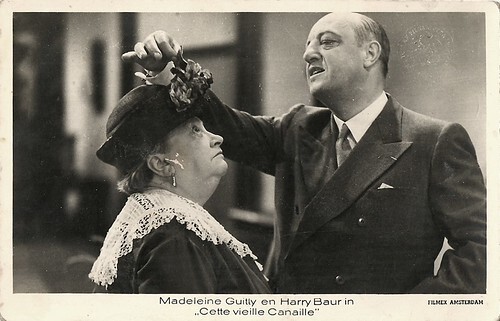
Dutch postcard. Photo: Filmex, Amsterdam. Madeleine Guitty and Harry Baur in Cette vieille canaille/The Old Devil (Anatole Litvak, 1933).
Harry Baur stars in one of Litvak's first French films, Cette vieille canaille/The Old Devil, as Vautier, a wealthy surgeon in his fifties. He falls in love with Hélène ( Alice Field ), a young woman from a modest background. He allows her to have a string of short-lived lovers - but when Jean Trapeau, an old boyfriend ( Pierre Blanchar ), resurfaces, things get complicated.
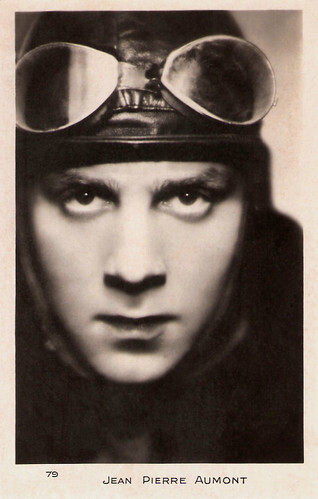
French postcard, no. 79. Jean-Pierre Aumont in L'équipage/Flight into Darkness (Anatole Litvak, 1935).
In L'équipage/Flight into Darkness (Anatole Litvak, 1935), Charles Vanel and Annabella star as a daring WW I aviator and his loving but neglected wife. Ostracised by the other pilots because of his recklessness and standoffishness, Vanel nonetheless befriends a young pilot ( Jean-Pierre Aumont ) who is in love with Vanel's wife. Litvak did a couple of years later an American version, The Woman I Love (Anatole Litvak, 1937) with Paul Muni and Miriam Hopkins , but L'équipage is the better of the two thanks to the excellent aviation photography, the warm and likeable performances of the leads and the arrival at the front which seems darker and more sombre in the French version.
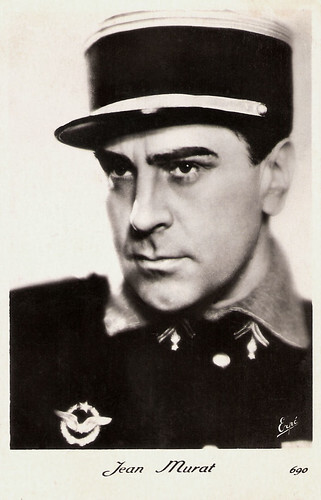
French postcard by Erpé, no. 690. Jean Murat in L'équipage/Flight Into Darkness (Anatole Litvak, 1935).
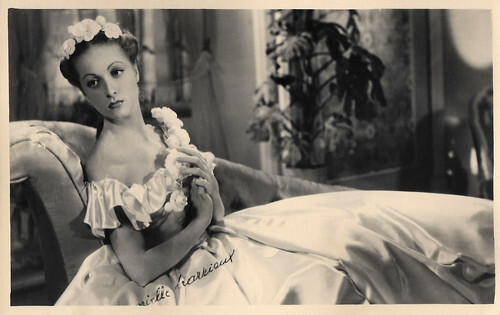
Vintage postcard. Danielle Darrieux in Mayerling (Anatole Litvak, 1936).
Mayerling (Anatole Litvak, 1936) was one of the first foreign films with sound to become a hit in the United States. It made an international star out of Charles Boyer . He stars as Rudolf, Crown Prince of Austria, who is fettered on all sides. He's bored. His father, the emperor, is domineering. He's got more liberal views than his father ( Jean Dax ), but he knows his views carry no weight. He agrees to marry a princess to sire an heir, then spends his nights as a playboy. In 1888, he meets Marie Vetsera ( Danielle Darrieux ), 17, a baroness's daughter. She is resolute, smitten, and wants nothing in return for her love. The Prime Minister is alarmed; he contrives to have her sent away. With the British monarchy crisis in the news in America and everywhere else but the British Empire, Mayerling found an interested audience in 1936. Litvak, Boyer, and Darrieux would be in Hollywood soon.
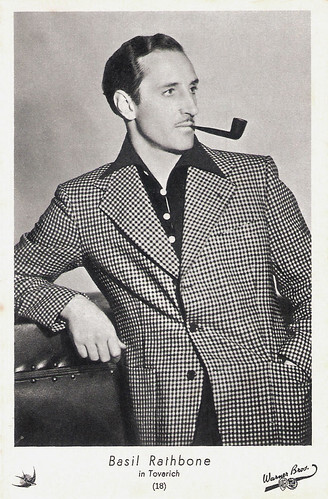
Italian postcard in the series '100 Artisti del Cinema' by Edizione ELAH 'La casa delle caramelle', no. 18. Photo: Warner Bros. Basil Rathbone in Tovarich (Anatole Litvak, 1937).
An unquestionable winner
Anatole Litvak was at his best directing taut, suspenseful crime dramas, such as The Amazing Dr. Clitterhouse (Anatole Litvak, 1938) with Edward G. Robinson and Humphrey Bogart , hailed by Variety as "an unquestionable winner". Also with Warner Brothers, he directed Confessions of a Nazi Spy (Anatole Livak, 1939), starring Edward G. Robinson as an FBI agent who breaks up a Nazi spy ring. It was released at a time of increasing tensions in Europe as the Nazis promoted their expansion. The film was banned in Germany and by its Fascist allies Italy and Spain.
Litvak directed the melodrama The Sisters (Anatole Litvak, 1938) with Bette Davis , and worked with Davis and Boyer again on All This, and Heaven Too (Anatole Livak, 1940) a dramatic love story between a governess and a baron. Again, it became a commercial success, and the film was nominated for an Academy Award as Best Picture. It allowed Litvak to shoot This Above All (Anatole Litvak, 1942), a patriotic love story starring Tyrone Power and Joan Fontaine . He also directed two tough action films starring John Garfield , Castle on the Hudson (Anatole Litvak, 1940) and Out of the Fog (Anatole Litvak, 1941).
Having become an American citizen in 1940, Litvak enlisted in the US Army and collaborated with Frank Capra on the wartime Why We Fight series of documentaries. He was involved in directing The Nazis Strike (Frank Capra, Anatole Litvak, 1942) and Divide and Conquer (Frank Capra, Anatole Litvak, 1942) and The Battle of China (Frank Capra, Anatole Litvak, 1943). He later co-directed War Comes to America (Frank Capra, Anatole Litvak, 1945), the final film in the Why We Fight series. Because of his multilingualism, speaking Russian, German and French, he had a key role as the leader of the photography division that captured the landing of US troops during the D-Day landing in Normandy (Operation Overlord). At the war's end, he left the army with the rank of colonel and returned to Hollywood.
After the war, Litvak made the Film Noir The Long Night (Anatole Litvak, 1947) starring Henry Fonda and the classic thriller Sorry Wrong Number (Anatole Litvak, 1948) with Barbara Stanwyck and Burt Lancaster .
Arguably his best film was the superb psychological drama The Snake Pit (Anatole Litvak, 1948), starring Olivia De Havilland . It was Hollywood's first attempt to seriously examine the treatment of mental illness. Indeed, the film was so influential that it precipitated changes in the American mental health system. Litvak was nominated for an Academy Award as Best Director but lost out to John Huston for The Treasure of the Sierra Madre (John Huston, 1948).
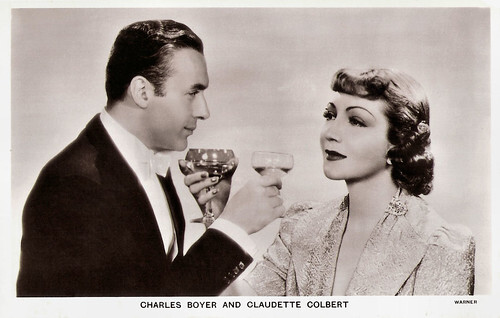
British postcard in the Film Partners Series, London, no. P 251. Photo: Warner. Charles Boyer and Claudette Colbert in Tovarich (Anatole Litvak, 1937).
After the Russian Revolution, a married Russian couple of nobility ( Charles Boyer and Claudette Colbert ) must take up jobs in Paris to survive. They take positions as butler and housemaid in a wealthy household and, owing to their impeccable breeding and manners, excel in their new jobs. But once they are recognised for the noble couple they are, they must face new - and formidable - responsibilities. Colbert fought with Litvak throughout most of the filming of the screwball comedy Tovarich. Her main problem was with Litvak's cinematographer, Charles Lang. Colbert, famous for demanding that when she be primarily photographed from the left side, didn't feel that Lang was photographing her according to her wishes. She demanded that he be fired. Litvak refused, setting off the battle.
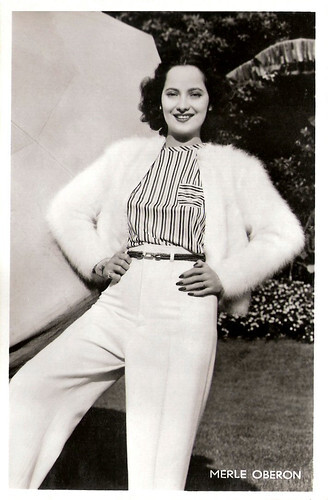
Dutch postcard. Merle Oberon in Till We Meet Again (Edmund Goulding, William K. Howard (uncredited), William Keighley (uncredited), Anatole Litvak (uncredited), 1940).
In Till We Meet Again, dying Joan Ames ( Merle Oberon ) meets criminal Dan Hardesty (George Brent) on a luxury liner as he is being transported back to America by policeman Steve Burke (Pat O'Brien) to face execution. Joan and Dan fall in love, their fates unbeknownst to one another. Illness caused director Edmund Goulding to be replaced for much of this romantic drama. Anatole Litvak shot approximately 26% of the film, William Keighley 4%, and William K. Howard shot a few retakes. Goulding shot 70% of the picture around bouts of pneumonia.
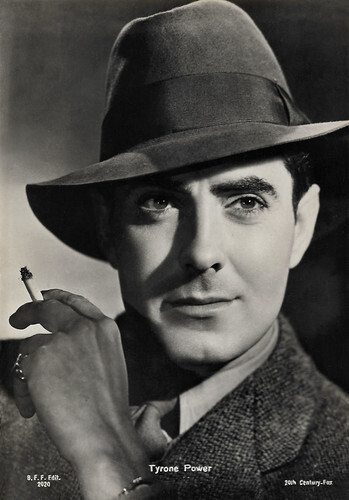
Italian postcard by B.F.F. Edit., no. 2020. Photo: 20th Century Fox. Tyrone Power in This Above All (Anatole Litvak, 1942).
Litvak's engrossing romantic drama This Above All (Anatole Litvak, 1942) takes place in the early years of World War II, before the United States entered the war. Beautiful and strong-willed Prudence Cathaway ( Joan Fontaine ) shocks her aristocratic family by enlisting in the WAFs. A fellow WAF sets her up on a blind date with handsome but moody Clive Briggs ( Tyrone Power ). Prudence learns that Clive is a deserter, but still loves him and senses that he will eventually prove himself a patriot. the film was intended to boost sympathy and support for England, which was already engaged in a desperate battle with Nazi Germany.
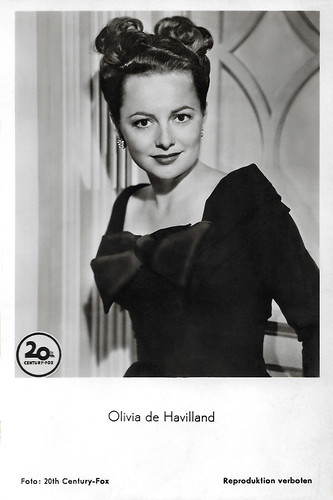
German postcard by F. J. Rüdel, Filmpostkartenverlag, Hamburg-Bergedorf, no. 83. Photo: 20th Century Fox. Olivia de Havilland in The Snake Pit (Anatole Litvak, 1948).
Olivia de Havilland gives a standout performance in The Snake Pit (Anatole Litvak, 1948) a film in line with the interest in psychiatry after World War II. De Havilland plays a troubled, often disoriented woman with unexplained mood swings who winds up in a state mental hospital with no memory of her new husband (Mark Stevens). She becomes a patient of Dr. Kik ( Leo Genn ) who patiently works with her to try and get to the core of her problem, and to do so, employs several rounds of electroshock therapy. Together they uncover suppressed memories.

German collectors card in the 'Filmstars von Hollywood bis Tokio' series III. Photo: Vivien Leigh in The Deep Blue Sea (Anatole Litvak, 1955).
Vivien Leigh plays in The Deep Blue Sea a woman unhappy in her passionless marriage. She leaves her husband ( Emlyn Williams ) for a younger and more ardent lover (Kenneth More). The Deep Blue Sea was based on a successful play by Terrence Rattigan and produced by Alexander Korda in Britain. Litvak cleverly opened Rattigan's play out with flashbacks, many locations (including an air show, Klosters, and the London Embankment) and several big studio sets such as a a huge recreation of London's Soho.
A moody, introspective romantic drama and a suspenseful wartime thriller
In 1949, Anatole Litvak, who had once described Hollywood as a "Mecca", returned to Europe and settled in Paris, working only infrequently. Litvak was especially fond of Paris. He lived there between 1933 and 1936, and again between 1949 and 1974.
In 1951, and from 1955 to 1956, he undertook several projects under contract to 20th Century Fox.
Notable among his later efforts are two contrasting films with Ingrid Bergman . The first one was the lavishly produced Anastasia (Anatole Litvak, 1956) with Yul Brynner , about a woman claiming to be the Romanoff dynasty's last living direct descendant. Bergman won an Oscar for her performance in this film. The second was the moody, introspective romantic drama Goodbye Again (Anatole Litvak, 1961) with Yves Montand and Anthony Perkins , shot on location in Paris.
In stark thematic contrast to these films, he also directed the suspenseful wartime thriller The Night of the Generals (Anatole Litvak, 1967), starring Peter O'Toole . His final film was the psuchological thriller La Dame dans l'auto avec des lunettes et un fusil/The Lady in the Car with Glasses and a Gun (Anatole Litcak, 1970), starring Samantha Eggar and Oliver Reed .
Anatole Litvak died in a hospital in Neuilly, Paris, in December 1974 at the age of 72. He was married to Miriam Hopkins from 1937 till their divorce in 1939. From 1955 till his death, he was married to costume designer Sophie Litvak née Steur. Litvak was awarded a Star on the Hollywood Walk of Fame at 6633 Hollywood Boulevard in Hollywood, California in 1960.
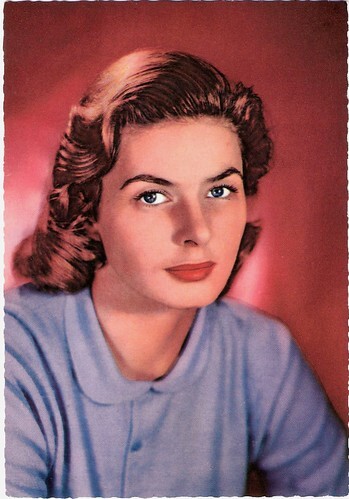
German postcard by ISV, no. A 58. Photo: 20th Century Fox. Publicity still of Ingrid Bergman for Anastasia (Anatole Litvak, 1956).
A trio of unscrupulous Russian exiles ( Yul Brynner , Sacha Pitoeff, and Akim Tamiroff) in Paris plot to collect ten million pounds from the Bank of England by grooming Anna, a mysterious, suicidal woman ( Ingrid Bergman ) to pose as heir to the Russian throne, the Grand Duchess Anastasia. She is so convincing that even the biggest sceptics believe her. At the time of filming Anastasia (Anatole Litvak, 1956), the producers at Fox were not aware that the real Anna Anderson was still alive. After this came to their attention, they flew to her home in Germany and asked permission to use her name. Litvak with his own Russian background gives Anastasia a flavour of authenticity for the main characters and the Russian exile background of the film. The film was shot on location in both Paris and Copenhagen and the camera work is first-rate.
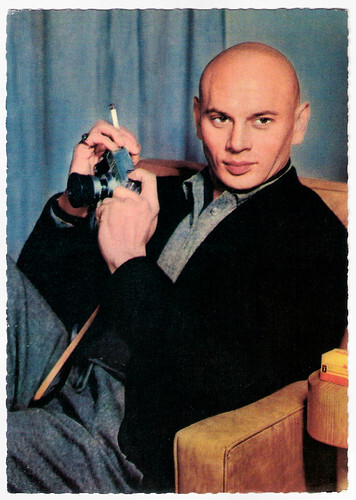
German postcard by ISV, no. A 54. Photo: 20th Century Fox. Publicity still of Yul Brynner for Anastasia (Anatole Litvak, 1956).

Romanian postcard by Casa Filmului Acin, no. 459. Ingrid Bergman and Yves Montand in Goodbye Again (Anatole Litvak, 1961).
Goodbye Again (1961) is an adaptation of Françoise Sagan's bestselling novel 'Aimez-Vous Brahms?'. Ingrid Bergman plays a successful businesswoman, dissatisfied with her current, philandering lover ( Yves Montand ), who starts an affair with a much younger man ( Anthony Perkins ). Society does not approve.
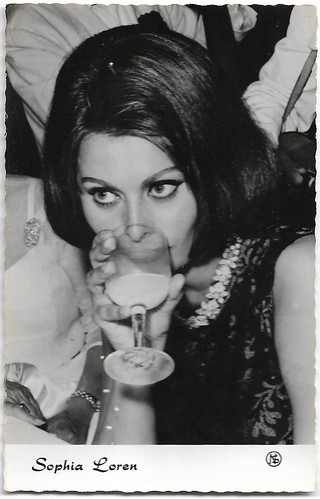
Dutch postcard. NS, 18. On the back, the number 621024 might be the date of printing, so 24 October 1962. Sophia Loren wears the same hairstyle in Le couteau dans la plaie/Five Miles to Midnight (Anatole Livak, 1962).
In Le couteau dans la plaie/Five Miles to Midnight, Italian Lisa Macklin ( Sophia Loren ) has a fight with her American husband Robert ( Anthony Perkins ) in a Paris nightclub. He leaves the next day for a business trip and Lisa says she does not want to see him again. She is with newspaperman Alan Stewart that evening when she learns Robert's plane has crashed with no survivors. Waking from sedation after the funeral, Lisa finds Robert in their flat, injured but alive. He now plans to collect the $120,000 insurance he took out at the airport.
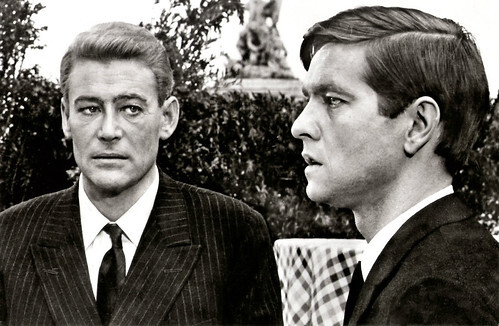
Romanian postcard by Casa Filmului Acin, no. 291. Peter O'Toole and Tom Courtenay in The Night of the Generals (Anatole Litvak, 1967).
In 1942, a Polish prostitute and German Agent is murdered in Warsaw in a sadistic way. Major Grau ( Omar Sharif ), an Agent from German Intelligence who believes in justice, is in charge of the investigation. An eyewitness saw a German General leaving the building after a scream from the victim. A further investigation shows that three Generals do not have any alibi for that night: General Tanz ( Peter O'Toole ), Major General Klaus Kahlenberge (Donald Pleasence), and General von Seidlitz-Gabler (Charles Gray). The story ends in 1965, in Hamburg, with another, similar crime.
Sources: Il Cinema Ritrovato 2024, (IMDb), Mike Rogers (IMDb), Wikipedia and .

French postcard. Photo: Raymond Voinquel / Production Gazy. Danielle Darrieux as Marie Vetsera in Mayerling (Anatole Litvak, 1936).

German postcard by Ross Verlag, no. 567. Photo: Ufa. Lilian Harvey in Nie wieder Liebe! (Anatole Litvak, 1931).

German postcard by Ross Verlag, no. 146/2. Photo: Cine-Allianz-Film der Ufa. Otto Wallburg , Julius Falkenstein , Jan Kiepura and Fritz Schulz in Das Lied einer Nacht/The Song of Night (Anatole Litvak, 1932).

French postcard by Erpé, no. 628. Photo: Film Pathé Natan. Jean-Pierre Aumont in L'équipage/Flight Into Darkness (Anatole Litvak, 1935).

British postcard in the Film Partners Series, London, no. PC 251. Photo: Warner. Charles Boyer and Claudette Colbert in Tovarich (Anatole Litvak, 1937).
Witness of the 1917 Russian Revolution
Anatoly Mikhailovich Litvak was born in 1902 in the city of Kyiv in the Russian Empire (now Ukraine). He was the son of Lithuanian Jewish parents. "Litvak" means "Lithuanian" in Yiddish.
The family moved to St. Petersburg, the capital of the Russian Empire. In 1915, Antatoly began to work at a little-known experimental theatre.
As a teenager, he witnessed the 1917 Russian Revolution and the consequent nationalisation of all theatres and drama schools.
In St. Petersburg, he studied philosophy at the university but in 1921 he began to train as an actor and theatre director in the same city. In 1923, he started working as a set decorator and assistant director for Nordkino Studios in Leningrad (the Soviet name for St. Petersburg).
Litvak worked his way up to directing short features, notably Tatiana (Anatole Litvak, 1925), a film about children.

German postcard by Ross Verlag, no. 6765/1, 1931-1932. Photo: Atelier Elli Marcus, Berlin. Dolly Haas in Dolly macht Karriere/Dolly's Way to Stardom (Anatole Litvak, 1930).
Litvak's first European feature, Dolly macht Karriere/Dolly's Way to Stardom, was a musical vehicle for up-and-coming Dolly Haas . She plays a would-be actress with a would-be composer boyfriend. At one point, she sings that she has the walk of Lilian Harvey , the mouth of Greta Garbo and the legs of Marlene Dietrich .

German collectors card in the series 'Vom Werden deutscher Filmkunst - Der Tonfilm', album no. 11, picture no. 61. Photo: Ufa / Ross Verlag. Lilian Harvey and Harry Liedtke in Nie wieder Liebe!/No More Love (Anatole Litvak, 1931).
Harry Liedtke in Nie wieder Liebe!/No More Love is an American millionaire, who always has bad luck with women. He bets that he can live without them for five years. But after four and a half years travelling around on his yacht, he rescues a lady, Lilian Harvey , in her one piece and bathing cap, from the English Channel. Litvak's undistinguished second European feature comes in a couple of languages and uses montage and moving camera to try to disguise the thinness of its script. However, Harvey - at the peak of her career, makes a lively impression.

German collectors card in the series 'Vom Werden deutscher Filmkunst - Der Tonfilm', album no. 11, picture no. 32. Photo: Cine-Allianz / Ross Verlag. Jan Kiepura and Julius Falkenstein in Das Lied einer Nacht/The Song of Night (Anatole Litvak, 1932).
In Das Lied einer Nacht/The Song of Night, Opera star Enrico Ferraro (Polish tenor Jan Kiepura ), tired of his stressful schedule, changes trains for a Swiss vacation. When his presence is discovered at the peaceful lakeside resort, he changes places with a new friend ( Fritz Schulz ) pretending he is his secretary. Free at last he explores the country and meets a beautiful girl (Magda Schneider). In this German musical, Litvak is already tracking, panning and quick cutting to push up the pace of his work. He also directed a now-lost English version, Tell Me Tonight (1932), and a French version, La chanson d'une nuit (1932), both also with Kiepura.

British postcard by Raphael Tuck & Sons, London, no. 50-S. Photo: Gaumont-British. Ivor Novello in Love and Let Love/Sleeping Car (Anatole Litvak, 1933).
In the charming romantic comedy Love and Let Love/Sleeping Car, Ivor Novello plays a French sleeping car attendant with a girl at every stop of the Orient Express. He hooks up with a wealthy widow ( Madeleine Carroll ) to add her to his collection. Being a good iceberg blonde, she resists. However, when she is given two weeks to get out of France for having too many speeding tickets, she decides to take advantage of a loophole by marrying a Frenchman. Novello gets the job but insists there be no funny business. The stars are very good and seem to be having a good time.
A major hit on both sides of the Atlantic
In 1925, Antole Litvak left the Soviet Union for Berlin to find more artistic possibilities. He was hired by the renowned director Georg Wilhelm Pabst to edit Die freudlose Gasse/The Joyless Street (G.W. Pabst, 1925) starring Asta Nielsen and Greta Garbo .
In 1930, he began directing numerous short films for Ufa. His first full-length feature was the romantic comedy Dolly macht Karriere/Dolly's Way to Stardom (Anatole Litvak, 1930) starring Dolly Haas.
Litvak's stay in Germany was cut short by the rise to power of Adolf Hitler. The Jewish Litvak moved to France and directed four films, including the historical drama Mayerling (Anatole Litvak, 1936), starring Charles Boyer and Danielle Darrieux.
This production was the turning point in Litvak's career, being a major hit on both sides of the Atlantic. He received effusive praise from critic Frank S. Nugent of the New York Times , who commented on the director's "superb assembling of scenes" and the "matchless performances" of the stars (September 14,1937). Hollywood soon beckoned and Litvak signed with RKO. After a year at RKO, he transferred to Warner Bros.
From 1937 to 1941, Litvak was a contract director for Warner Brothers. His first film was The Woman I Love (Anatole Litvak, 1937), which starred his future wife Miriam Hopkins. His experience with diverse aspects of stagecraft, as well as his fluency in four languages (Russian, German, French and English), enabled him to competently tackle a wide variety of subjects. The screwball comedy Tovarich (Anatole Litvak, 1937)) was a film adaptation of a Broadway hit starring Claudette Colbert and Charles Boyer . It paved the way for Litvak's further career.

Dutch postcard. Photo: Filmex, Amsterdam. Madeleine Guitty and Harry Baur in Cette vieille canaille/The Old Devil (Anatole Litvak, 1933).
Harry Baur stars in one of Litvak's first French films, Cette vieille canaille/The Old Devil, as Vautier, a wealthy surgeon in his fifties. He falls in love with Hélène ( Alice Field ), a young woman from a modest background. He allows her to have a string of short-lived lovers - but when Jean Trapeau, an old boyfriend ( Pierre Blanchar ), resurfaces, things get complicated.

French postcard, no. 79. Jean-Pierre Aumont in L'équipage/Flight into Darkness (Anatole Litvak, 1935).
In L'équipage/Flight into Darkness (Anatole Litvak, 1935), Charles Vanel and Annabella star as a daring WW I aviator and his loving but neglected wife. Ostracised by the other pilots because of his recklessness and standoffishness, Vanel nonetheless befriends a young pilot ( Jean-Pierre Aumont ) who is in love with Vanel's wife. Litvak did a couple of years later an American version, The Woman I Love (Anatole Litvak, 1937) with Paul Muni and Miriam Hopkins , but L'équipage is the better of the two thanks to the excellent aviation photography, the warm and likeable performances of the leads and the arrival at the front which seems darker and more sombre in the French version.

French postcard by Erpé, no. 690. Jean Murat in L'équipage/Flight Into Darkness (Anatole Litvak, 1935).

Vintage postcard. Danielle Darrieux in Mayerling (Anatole Litvak, 1936).
Mayerling (Anatole Litvak, 1936) was one of the first foreign films with sound to become a hit in the United States. It made an international star out of Charles Boyer . He stars as Rudolf, Crown Prince of Austria, who is fettered on all sides. He's bored. His father, the emperor, is domineering. He's got more liberal views than his father ( Jean Dax ), but he knows his views carry no weight. He agrees to marry a princess to sire an heir, then spends his nights as a playboy. In 1888, he meets Marie Vetsera ( Danielle Darrieux ), 17, a baroness's daughter. She is resolute, smitten, and wants nothing in return for her love. The Prime Minister is alarmed; he contrives to have her sent away. With the British monarchy crisis in the news in America and everywhere else but the British Empire, Mayerling found an interested audience in 1936. Litvak, Boyer, and Darrieux would be in Hollywood soon.

Italian postcard in the series '100 Artisti del Cinema' by Edizione ELAH 'La casa delle caramelle', no. 18. Photo: Warner Bros. Basil Rathbone in Tovarich (Anatole Litvak, 1937).
An unquestionable winner
Anatole Litvak was at his best directing taut, suspenseful crime dramas, such as The Amazing Dr. Clitterhouse (Anatole Litvak, 1938) with Edward G. Robinson and Humphrey Bogart , hailed by Variety as "an unquestionable winner". Also with Warner Brothers, he directed Confessions of a Nazi Spy (Anatole Livak, 1939), starring Edward G. Robinson as an FBI agent who breaks up a Nazi spy ring. It was released at a time of increasing tensions in Europe as the Nazis promoted their expansion. The film was banned in Germany and by its Fascist allies Italy and Spain.
Litvak directed the melodrama The Sisters (Anatole Litvak, 1938) with Bette Davis , and worked with Davis and Boyer again on All This, and Heaven Too (Anatole Livak, 1940) a dramatic love story between a governess and a baron. Again, it became a commercial success, and the film was nominated for an Academy Award as Best Picture. It allowed Litvak to shoot This Above All (Anatole Litvak, 1942), a patriotic love story starring Tyrone Power and Joan Fontaine . He also directed two tough action films starring John Garfield , Castle on the Hudson (Anatole Litvak, 1940) and Out of the Fog (Anatole Litvak, 1941).
Having become an American citizen in 1940, Litvak enlisted in the US Army and collaborated with Frank Capra on the wartime Why We Fight series of documentaries. He was involved in directing The Nazis Strike (Frank Capra, Anatole Litvak, 1942) and Divide and Conquer (Frank Capra, Anatole Litvak, 1942) and The Battle of China (Frank Capra, Anatole Litvak, 1943). He later co-directed War Comes to America (Frank Capra, Anatole Litvak, 1945), the final film in the Why We Fight series. Because of his multilingualism, speaking Russian, German and French, he had a key role as the leader of the photography division that captured the landing of US troops during the D-Day landing in Normandy (Operation Overlord). At the war's end, he left the army with the rank of colonel and returned to Hollywood.
After the war, Litvak made the Film Noir The Long Night (Anatole Litvak, 1947) starring Henry Fonda and the classic thriller Sorry Wrong Number (Anatole Litvak, 1948) with Barbara Stanwyck and Burt Lancaster .
Arguably his best film was the superb psychological drama The Snake Pit (Anatole Litvak, 1948), starring Olivia De Havilland . It was Hollywood's first attempt to seriously examine the treatment of mental illness. Indeed, the film was so influential that it precipitated changes in the American mental health system. Litvak was nominated for an Academy Award as Best Director but lost out to John Huston for The Treasure of the Sierra Madre (John Huston, 1948).

British postcard in the Film Partners Series, London, no. P 251. Photo: Warner. Charles Boyer and Claudette Colbert in Tovarich (Anatole Litvak, 1937).
After the Russian Revolution, a married Russian couple of nobility ( Charles Boyer and Claudette Colbert ) must take up jobs in Paris to survive. They take positions as butler and housemaid in a wealthy household and, owing to their impeccable breeding and manners, excel in their new jobs. But once they are recognised for the noble couple they are, they must face new - and formidable - responsibilities. Colbert fought with Litvak throughout most of the filming of the screwball comedy Tovarich. Her main problem was with Litvak's cinematographer, Charles Lang. Colbert, famous for demanding that when she be primarily photographed from the left side, didn't feel that Lang was photographing her according to her wishes. She demanded that he be fired. Litvak refused, setting off the battle.

Dutch postcard. Merle Oberon in Till We Meet Again (Edmund Goulding, William K. Howard (uncredited), William Keighley (uncredited), Anatole Litvak (uncredited), 1940).
In Till We Meet Again, dying Joan Ames ( Merle Oberon ) meets criminal Dan Hardesty (George Brent) on a luxury liner as he is being transported back to America by policeman Steve Burke (Pat O'Brien) to face execution. Joan and Dan fall in love, their fates unbeknownst to one another. Illness caused director Edmund Goulding to be replaced for much of this romantic drama. Anatole Litvak shot approximately 26% of the film, William Keighley 4%, and William K. Howard shot a few retakes. Goulding shot 70% of the picture around bouts of pneumonia.

Italian postcard by B.F.F. Edit., no. 2020. Photo: 20th Century Fox. Tyrone Power in This Above All (Anatole Litvak, 1942).
Litvak's engrossing romantic drama This Above All (Anatole Litvak, 1942) takes place in the early years of World War II, before the United States entered the war. Beautiful and strong-willed Prudence Cathaway ( Joan Fontaine ) shocks her aristocratic family by enlisting in the WAFs. A fellow WAF sets her up on a blind date with handsome but moody Clive Briggs ( Tyrone Power ). Prudence learns that Clive is a deserter, but still loves him and senses that he will eventually prove himself a patriot. the film was intended to boost sympathy and support for England, which was already engaged in a desperate battle with Nazi Germany.

German postcard by F. J. Rüdel, Filmpostkartenverlag, Hamburg-Bergedorf, no. 83. Photo: 20th Century Fox. Olivia de Havilland in The Snake Pit (Anatole Litvak, 1948).
Olivia de Havilland gives a standout performance in The Snake Pit (Anatole Litvak, 1948) a film in line with the interest in psychiatry after World War II. De Havilland plays a troubled, often disoriented woman with unexplained mood swings who winds up in a state mental hospital with no memory of her new husband (Mark Stevens). She becomes a patient of Dr. Kik ( Leo Genn ) who patiently works with her to try and get to the core of her problem, and to do so, employs several rounds of electroshock therapy. Together they uncover suppressed memories.

German collectors card in the 'Filmstars von Hollywood bis Tokio' series III. Photo: Vivien Leigh in The Deep Blue Sea (Anatole Litvak, 1955).
Vivien Leigh plays in The Deep Blue Sea a woman unhappy in her passionless marriage. She leaves her husband ( Emlyn Williams ) for a younger and more ardent lover (Kenneth More). The Deep Blue Sea was based on a successful play by Terrence Rattigan and produced by Alexander Korda in Britain. Litvak cleverly opened Rattigan's play out with flashbacks, many locations (including an air show, Klosters, and the London Embankment) and several big studio sets such as a a huge recreation of London's Soho.
A moody, introspective romantic drama and a suspenseful wartime thriller
In 1949, Anatole Litvak, who had once described Hollywood as a "Mecca", returned to Europe and settled in Paris, working only infrequently. Litvak was especially fond of Paris. He lived there between 1933 and 1936, and again between 1949 and 1974.
In 1951, and from 1955 to 1956, he undertook several projects under contract to 20th Century Fox.
Notable among his later efforts are two contrasting films with Ingrid Bergman . The first one was the lavishly produced Anastasia (Anatole Litvak, 1956) with Yul Brynner , about a woman claiming to be the Romanoff dynasty's last living direct descendant. Bergman won an Oscar for her performance in this film. The second was the moody, introspective romantic drama Goodbye Again (Anatole Litvak, 1961) with Yves Montand and Anthony Perkins , shot on location in Paris.
In stark thematic contrast to these films, he also directed the suspenseful wartime thriller The Night of the Generals (Anatole Litvak, 1967), starring Peter O'Toole . His final film was the psuchological thriller La Dame dans l'auto avec des lunettes et un fusil/The Lady in the Car with Glasses and a Gun (Anatole Litcak, 1970), starring Samantha Eggar and Oliver Reed .
Anatole Litvak died in a hospital in Neuilly, Paris, in December 1974 at the age of 72. He was married to Miriam Hopkins from 1937 till their divorce in 1939. From 1955 till his death, he was married to costume designer Sophie Litvak née Steur. Litvak was awarded a Star on the Hollywood Walk of Fame at 6633 Hollywood Boulevard in Hollywood, California in 1960.

German postcard by ISV, no. A 58. Photo: 20th Century Fox. Publicity still of Ingrid Bergman for Anastasia (Anatole Litvak, 1956).
A trio of unscrupulous Russian exiles ( Yul Brynner , Sacha Pitoeff, and Akim Tamiroff) in Paris plot to collect ten million pounds from the Bank of England by grooming Anna, a mysterious, suicidal woman ( Ingrid Bergman ) to pose as heir to the Russian throne, the Grand Duchess Anastasia. She is so convincing that even the biggest sceptics believe her. At the time of filming Anastasia (Anatole Litvak, 1956), the producers at Fox were not aware that the real Anna Anderson was still alive. After this came to their attention, they flew to her home in Germany and asked permission to use her name. Litvak with his own Russian background gives Anastasia a flavour of authenticity for the main characters and the Russian exile background of the film. The film was shot on location in both Paris and Copenhagen and the camera work is first-rate.

German postcard by ISV, no. A 54. Photo: 20th Century Fox. Publicity still of Yul Brynner for Anastasia (Anatole Litvak, 1956).

Romanian postcard by Casa Filmului Acin, no. 459. Ingrid Bergman and Yves Montand in Goodbye Again (Anatole Litvak, 1961).
Goodbye Again (1961) is an adaptation of Françoise Sagan's bestselling novel 'Aimez-Vous Brahms?'. Ingrid Bergman plays a successful businesswoman, dissatisfied with her current, philandering lover ( Yves Montand ), who starts an affair with a much younger man ( Anthony Perkins ). Society does not approve.

Dutch postcard. NS, 18. On the back, the number 621024 might be the date of printing, so 24 October 1962. Sophia Loren wears the same hairstyle in Le couteau dans la plaie/Five Miles to Midnight (Anatole Livak, 1962).
In Le couteau dans la plaie/Five Miles to Midnight, Italian Lisa Macklin ( Sophia Loren ) has a fight with her American husband Robert ( Anthony Perkins ) in a Paris nightclub. He leaves the next day for a business trip and Lisa says she does not want to see him again. She is with newspaperman Alan Stewart that evening when she learns Robert's plane has crashed with no survivors. Waking from sedation after the funeral, Lisa finds Robert in their flat, injured but alive. He now plans to collect the $120,000 insurance he took out at the airport.

Romanian postcard by Casa Filmului Acin, no. 291. Peter O'Toole and Tom Courtenay in The Night of the Generals (Anatole Litvak, 1967).
In 1942, a Polish prostitute and German Agent is murdered in Warsaw in a sadistic way. Major Grau ( Omar Sharif ), an Agent from German Intelligence who believes in justice, is in charge of the investigation. An eyewitness saw a German General leaving the building after a scream from the victim. A further investigation shows that three Generals do not have any alibi for that night: General Tanz ( Peter O'Toole ), Major General Klaus Kahlenberge (Donald Pleasence), and General von Seidlitz-Gabler (Charles Gray). The story ends in 1965, in Hamburg, with another, similar crime.
Sources: Il Cinema Ritrovato 2024, (IMDb), Mike Rogers (IMDb), Wikipedia and .
Published on June 23, 2024 22:00
Paul van Yperen's Blog
- Paul van Yperen's profile
- 13 followers
Paul van Yperen isn't a Goodreads Author
(yet),
but they
do have a blog,
so here are some recent posts imported from
their feed.



